Robert Freimark
Born in 1922, American artist Bob Freimark hails from a period when artists were experimenting with multiple mediums to express their conceptual ideas. Over the course of his career, he chose to work in a wide variety of media to articulate the issues important to him including painting, watercolor, drawing, all print media, tapestry, sculpture, and recently video and film.
He was educated at the University of Toledo, before going on for an MFA from Cranbrook Academy of Art. Later he became a student of Max Weber, and was elected to New Talent in the USA in 1957. In the period from 1960-68 he created a series of serigraphs entitled "Fifty States" which depict the U.S. states, and were completed under the aegis of a California State Colleges Special Creative Leave. They became the official U.S. bicentennial offering in 1976, opening at the Amerika Haus in Munich. They have been shown throughout the world, and the National Museum in Washington has acquired the complete set together with all accompanying sketches, and plates.
Although he was born in the United States, Freimark was of European descent. In his piece, “Immigration Blues” we can see his sensitivity towards the immigrant situation. His placement of the patriotic colors red, white and blue at the top of the work symbolize the desired goal. Underneath it are various maze-like pathways to get to the same place; a metaphor for the multiple routes people have gone through to get into this country.
Freimark has over 250 solo exhibitions to his credit.
His works are in collections such as the Boston Museum of Fine Arts, Fogg Museum, Pennsylvania Academy of Fine Arts, British Museum, Bibliotheque Nationale in Paris, Honolulu Academy of Arts, Library of Congress, National Gallery in Prague, etc. He has lectured around the world, and was a Visiting Professor at Harvard University in 1972-73.
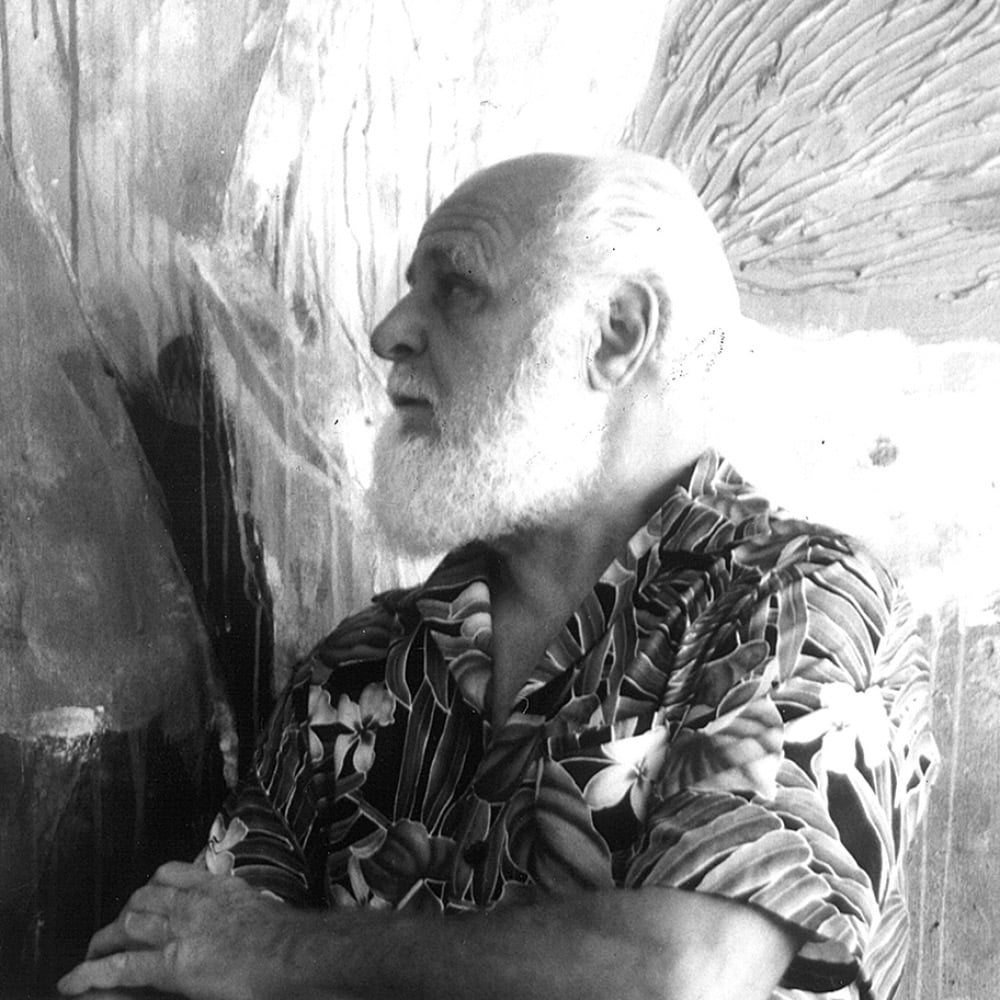
AVAILABLE WORKS
Our inventory changes frequently. Please view available works below or click FOLLOW to be notified of new arrivals.
FOLLOW THIS ARTIST
Interested, but not ready to move forward yet? Want to be the first to know about new arrivals? Follow this artist to be notified.
FOLLOWFOLLOW THIS ARTIST
Our inventory changes regularly. Join our private collector list to receive early previews of new arrivals, updates on exhibitions, and occasional exclusive opportunities — thoughtfully curated for those who follow this artist.
ARTWORK





Artist Statement
“I am an abstract-expressionist, but I am committed to the belief that all artists must thoroughly know and pursue the figure and the figurative genre, in the same sense that a pianist regularly practices the scale.” Methods of work: It is imperative that the artist seek and discover the most suitable media for the labor at hand, and to attempt to master whatever media he encounters, to achieve this goal. Recently, I have completed an exhibition called “Los Desaparecidos” which depicts my subjects in an all-media exhibit by one artist including film, which adds the dimensions of time and action.
I spent seven years of my life in the United States Navy, including all of World War II. I was on the ship with the best firing record throughout the war, where I was a pointer on a forty millimeter quad. The pointer is the man who aims and fires the guns. I was in 56 engagements with the Japanese. I came out of the experience disillusioned by the intelligence of our Naval officers, and totally against all war. As an artist, it is one of my commitments to relay this experience to my fellow citizens."
- Robert Freimark
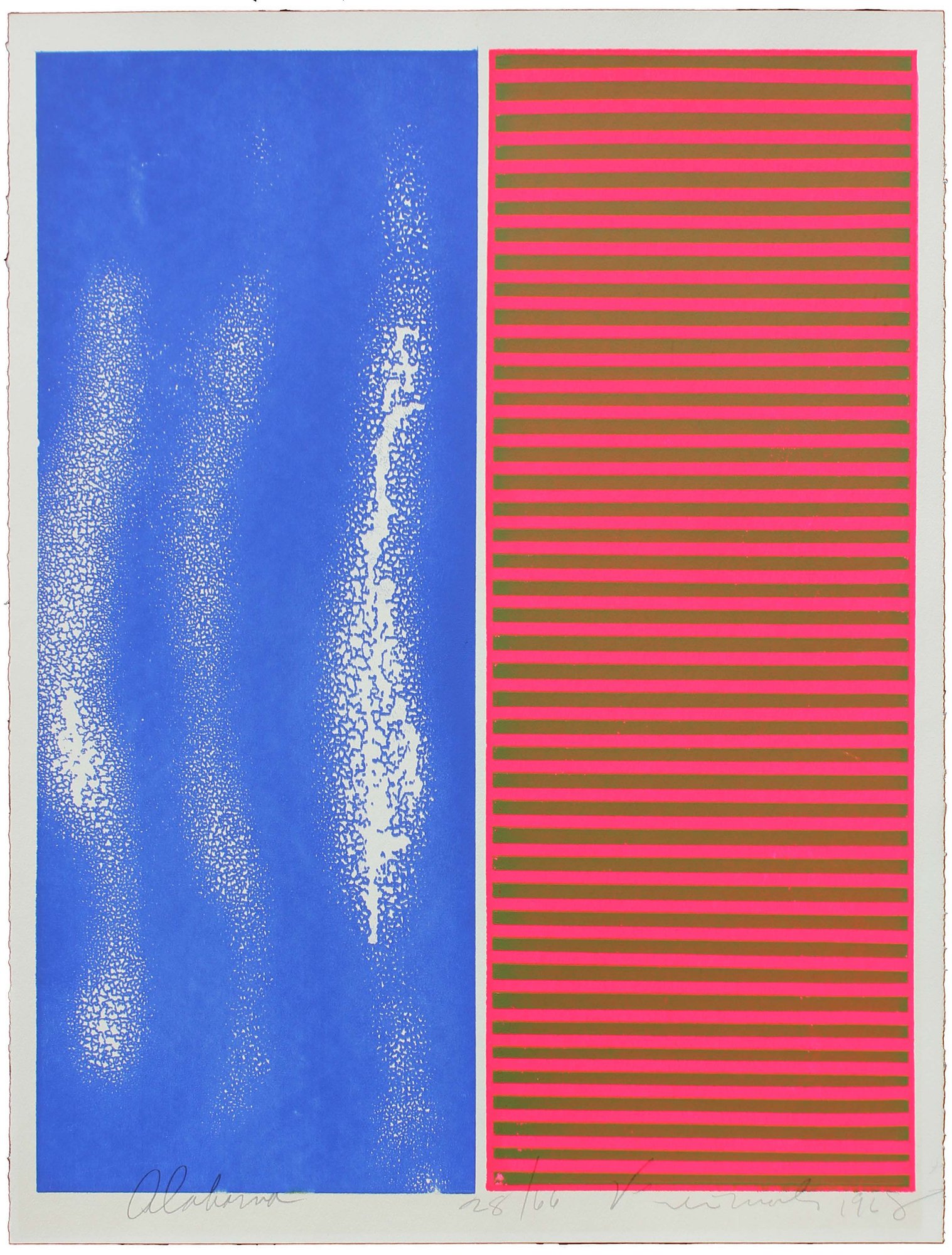
ALABAMA
22.25” X 17.25” – Edition of 66 – 1968
A bisected field in patriotic colors of red, white, and blue conjure the political climate in Alabama in 1968 when civil rights leader Jerry Pogue carried the American flag in lead of a march through downtown Mobile that was held in the memory of slain civil rights leader Martin Luther King. The stripes on the right hold true while the white stains on the left showcase the casualties of a country learning to right the wrongs of their race relations – a blurry rendition of whitewashing and a nod to what would become a future equality. Positioned in abstract as the ingredients of unity become two sides of a future coin.
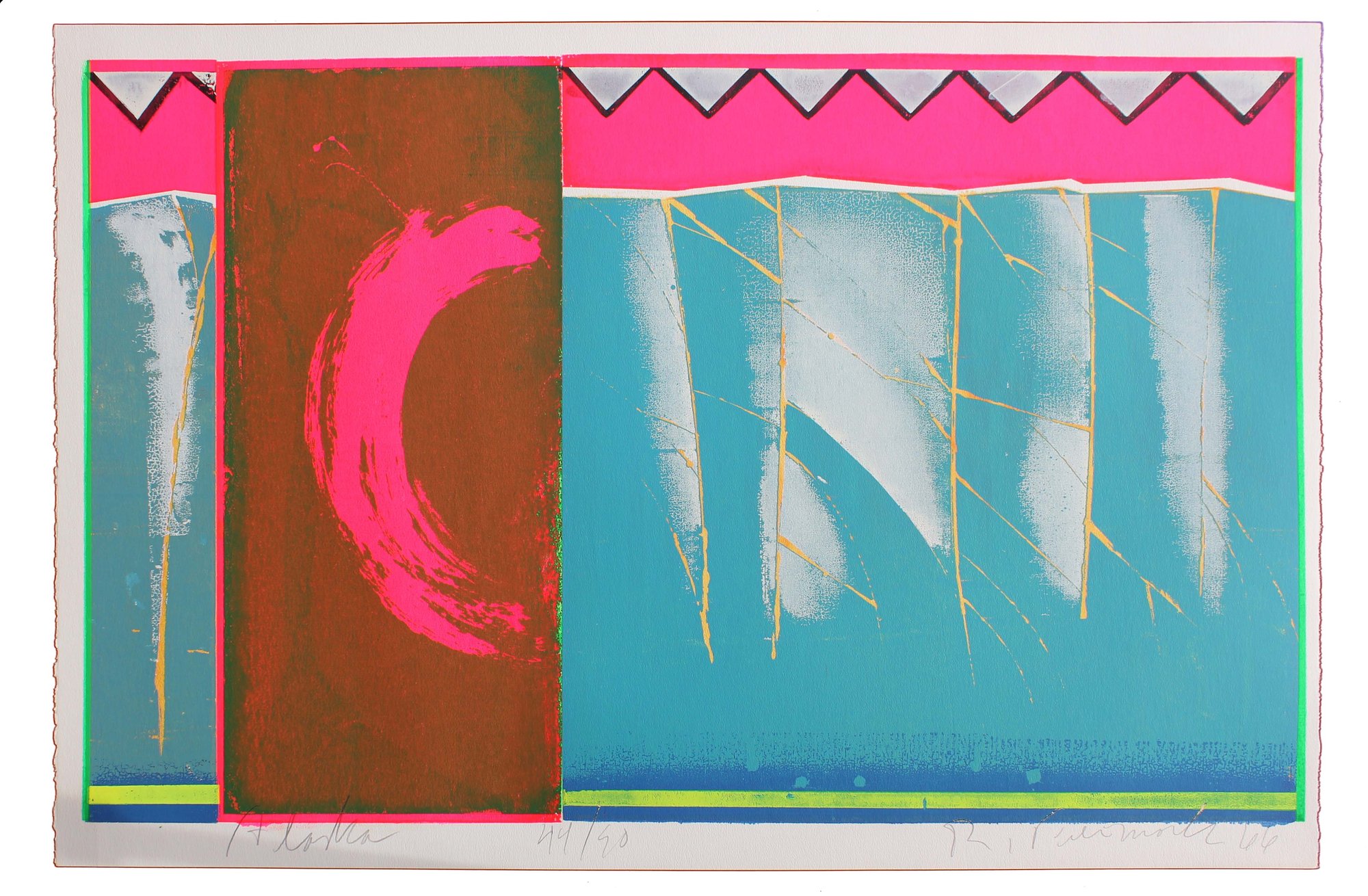
ALASKA
21” x 34” – Edition of 50 – 1966
For Freimark, Alaska was the color of cold, its frozen stillness cracking the horizon, as regiments of mountains marched above the glaciers. A cerulean background swathed with frosted white conjures a perpetual iced over body of water, with thin streams of yellow drizzling a feeble warmth. A cerise border on top, studded with triangles and a slim line of green below, hint at bits of landscape peeking through the freeze. The triangular pattern also brings to mind the Native Alaskan tribes while a rust-colored rectangle hovers to the left, bearing an arced slash of stark pink sun.
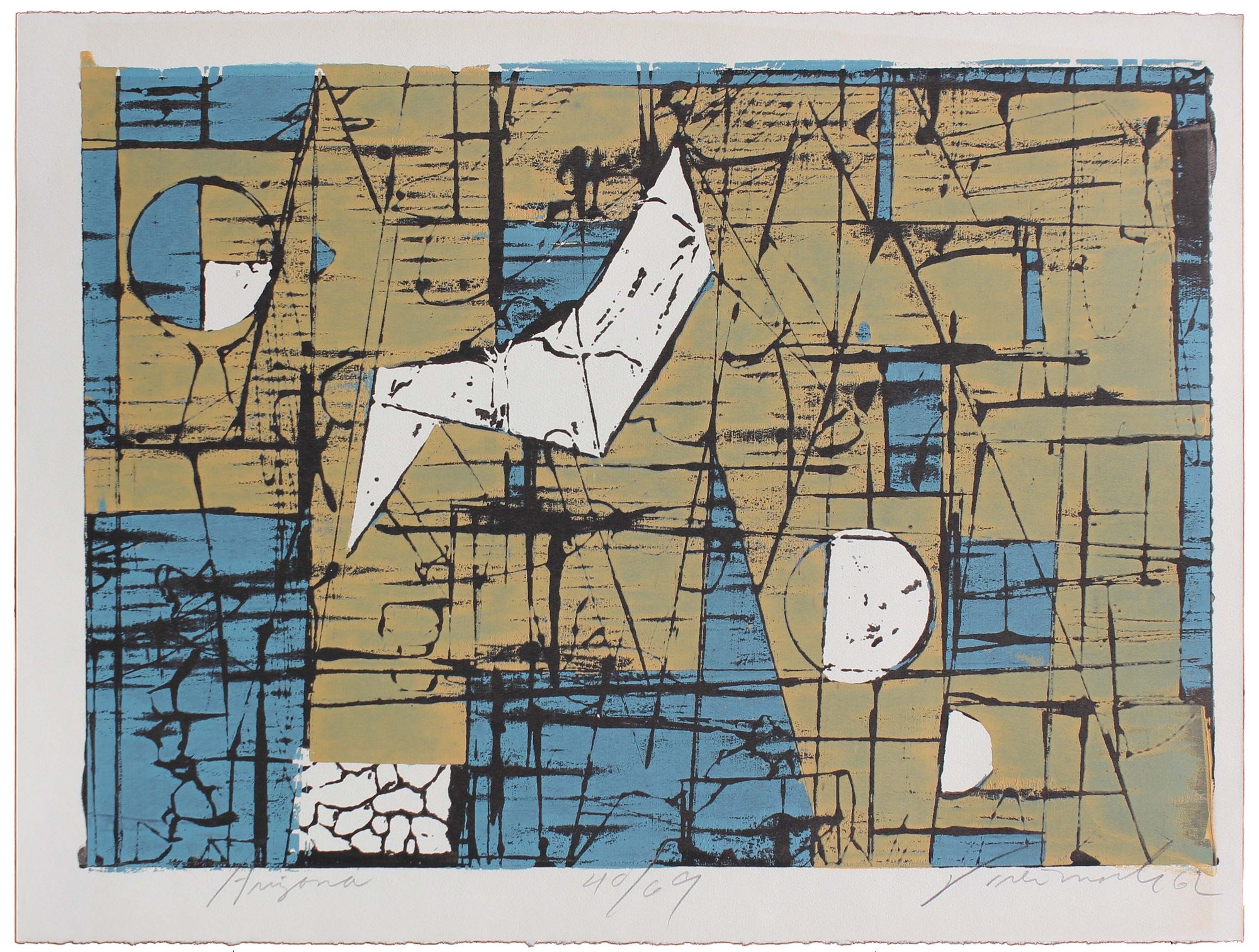
ARIZONA
15-1/2” x 22” – Edition of 69 – 1962
Dusty cornflower blue, pale olive green, and smoky cream compile a geometric composition scratched with black lines reflecting a fascinating mix of striking landscapes and shifting cultural currents from an era when the state embodied both timeless desert mystique and mid-century American change. Freimark viewed Arizona as being “built out of sticks and mud, and rooks carefully fitted together.” A vast and arid land of sunbaked shelters written with the heritage of a forgotten people whose art lived on. He saw this in the adobe, an old mine, or the backcountry, all with whispers of man who had been there before.
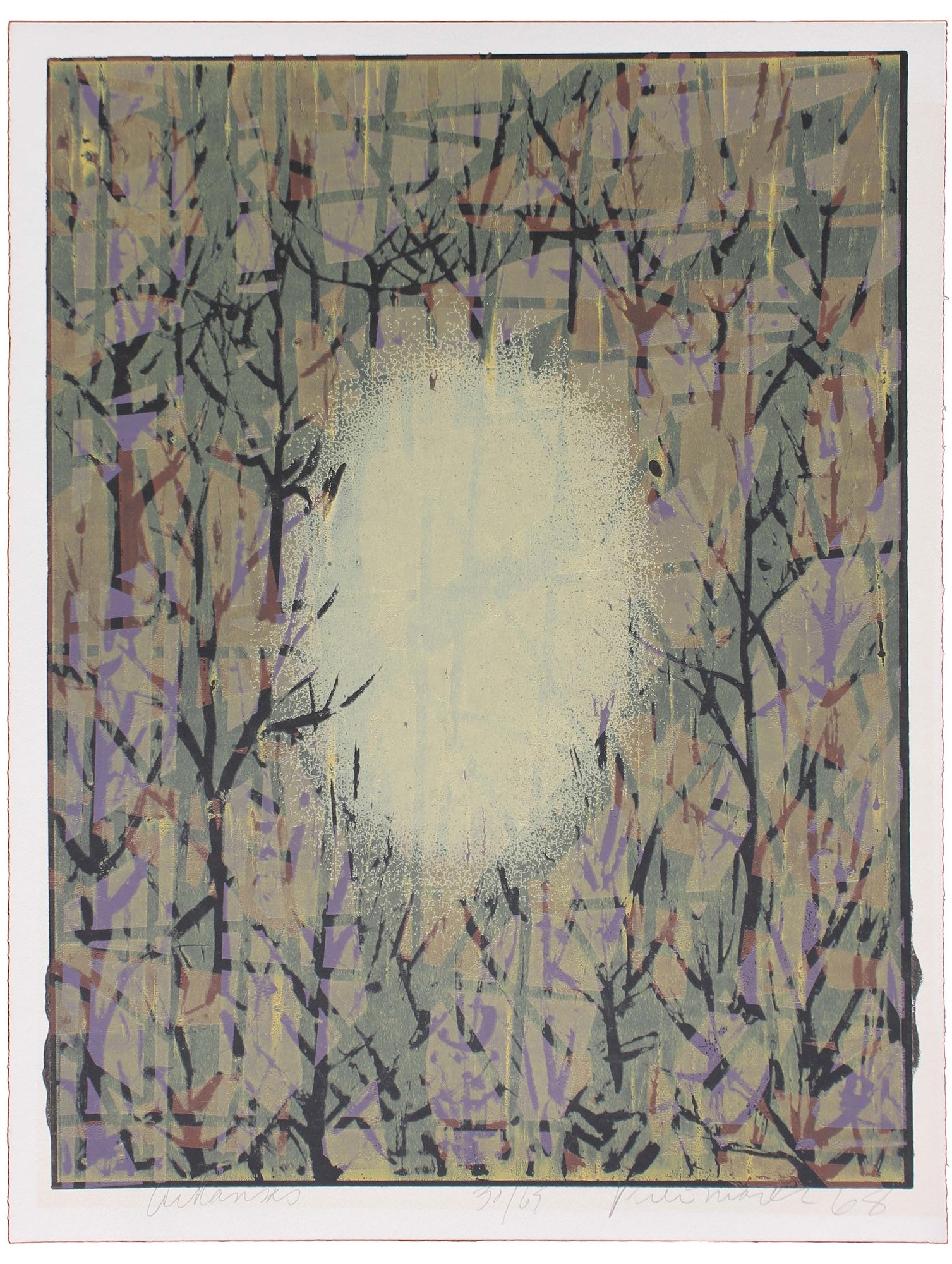
ARKANSAS
16-3/4” x 22-1/2” – Edition of 65 – 1968
Freimark’s glimpse of Arkansas is one of revelry for in its “hummocky knolls” he found “recessed delights to make eyes bright” in “The stringy gossamer of moss draped light over live oak” that “ transmutes a common glade to some sanctuary fit to couch oracles, romantics, or whatnot, but not by a long and hollow shot the least bit ordinary, or hard to visualize.” He felt the average American relegated the state to an obscure patch of territory yet his lemon-yellow point of brightness amidst the lavender, black, and brown foliage proves otherwise.
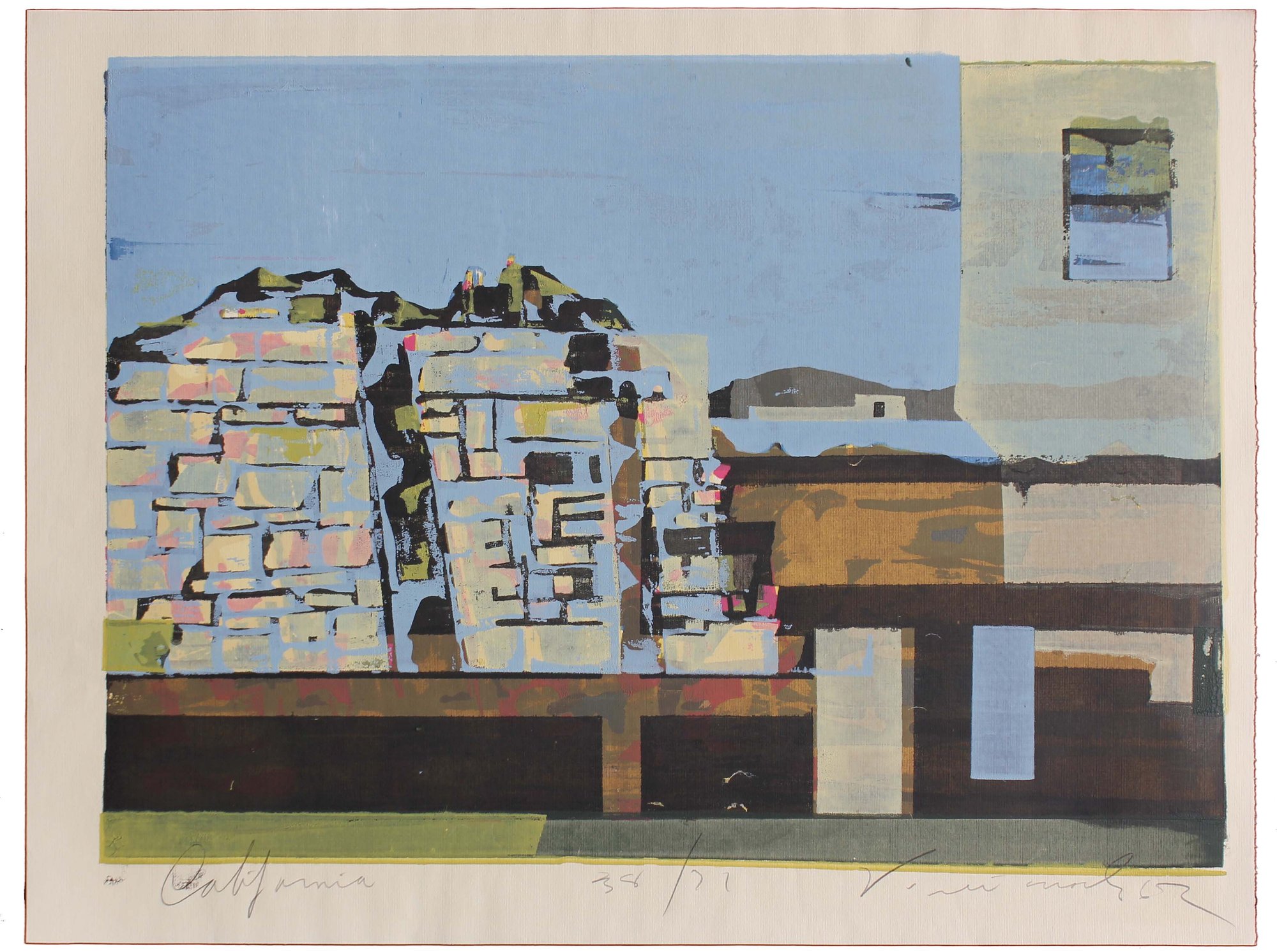
CALIFORNIA
18.25” x 24.25” – Edition of 71 – 1962
A dock side palette piled with sun-kissed pastel-colored parcels under a paradisical robin egg’s blue sky beckons the spirit of Manifest Destiny connotated with the Golden state of California. Dominating the West Coast and hugging the sea with its Pacific Ocean ports of call, this grand place in the sixties was alive with potential opportunity: citrus groves of juicy fruit, condos, and palm trees all rubbing elbows with a burgeoning entertainment industry, a cinematic allusion that one could carve out an identity in myriad shapes and forms as one wished. As Freimark lived, worked, and taught here, his homage to his home sings with kaleidoscope fervor and a fortuitous, hearkening toward a universal dream.
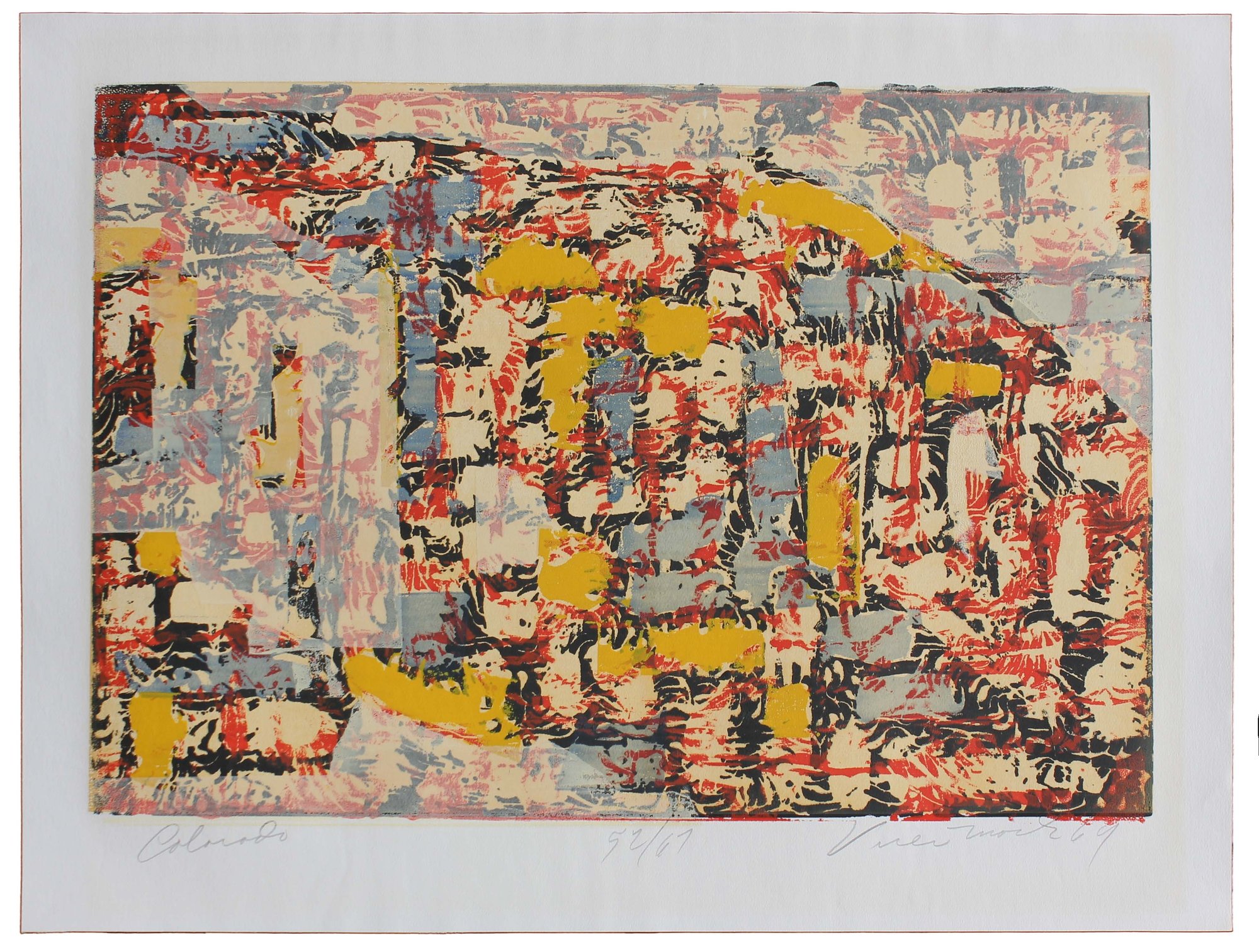
COLORADO
14.75” x 21.75” – Edition of 67 – 1969
Freimark’s Colorado is depicted much like a massive cob of maize, dug from the ground of a Native American’s heart, splayed on the canvas as if each individual kernel tells a story, painted on distant hills in hues of mustard, rust, slate, and sage. The land of the Rocky Mountains, home of our Ancestral Puebloan cliff dwellings, stark sanctuary of root, desert, cliff, mesa, and wide-open range. A land of stunning natural beauty that continues to awe in its steady graduation through annual native climates inviting reminiscence of its lazy canyons, dawdling rivers, and age-old cultural traditions of the relationship between land and man.
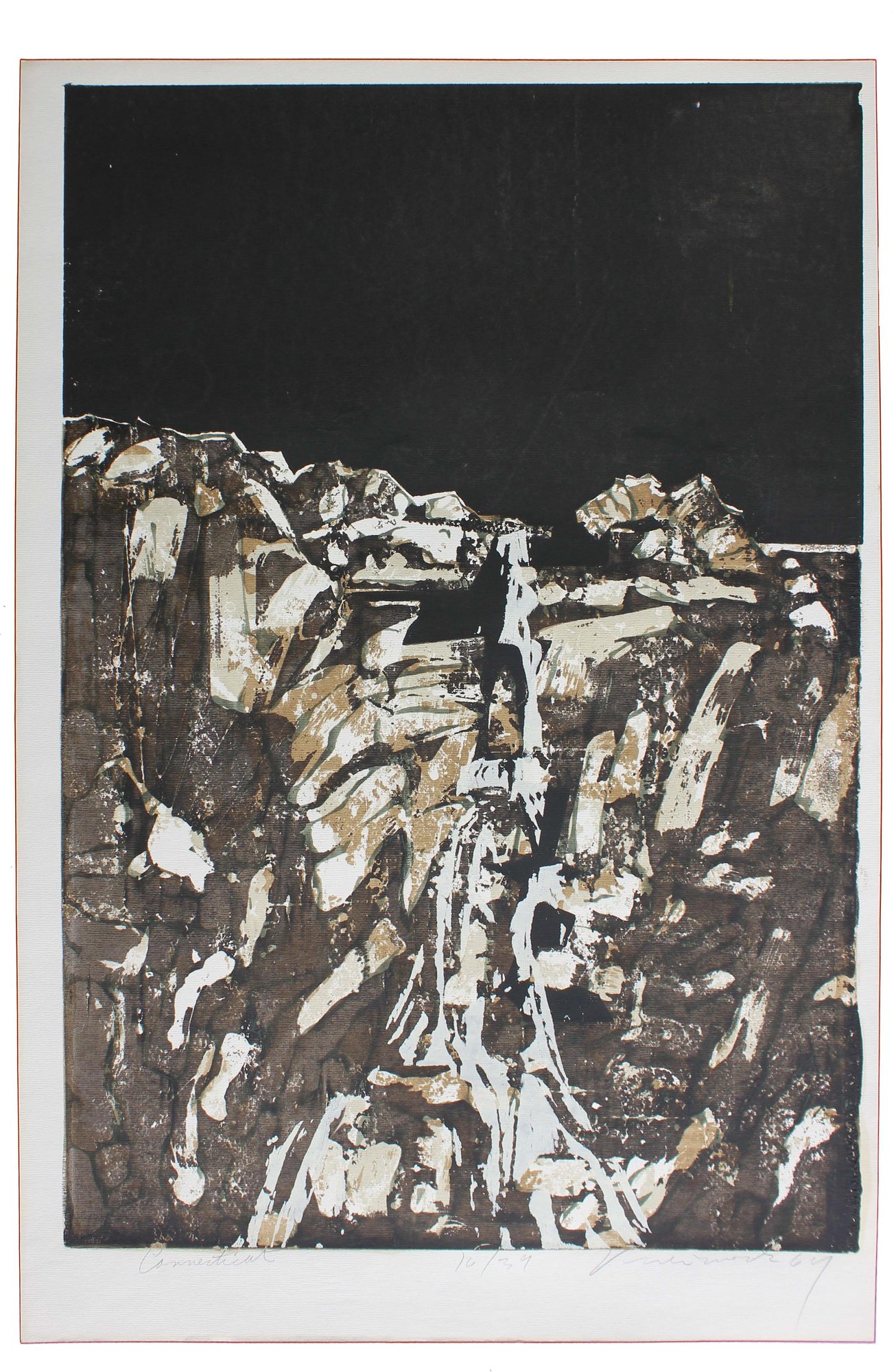
CONNECTICUT
21-1/2” x 31-3/4” – Edition of 39 – 1964
In Connecticut, Freimark was reminded of a mystic spring he saw as a youth, memorialized at the center of this work as a white downward gush falling between a rugged scramble of brown, tan, and light black terrain beneath a dark matte sky. A land stoked by New England roots carrying the nostalgic memory of days spent running amongst brooks that fed ancient oaks and frying up twitching bullfrogs in pans out in the open. A time capsule of childhood when things loom large until revisited in adulthood to be rendered as very “small and trivial” like a simple Polaroid snapshot.
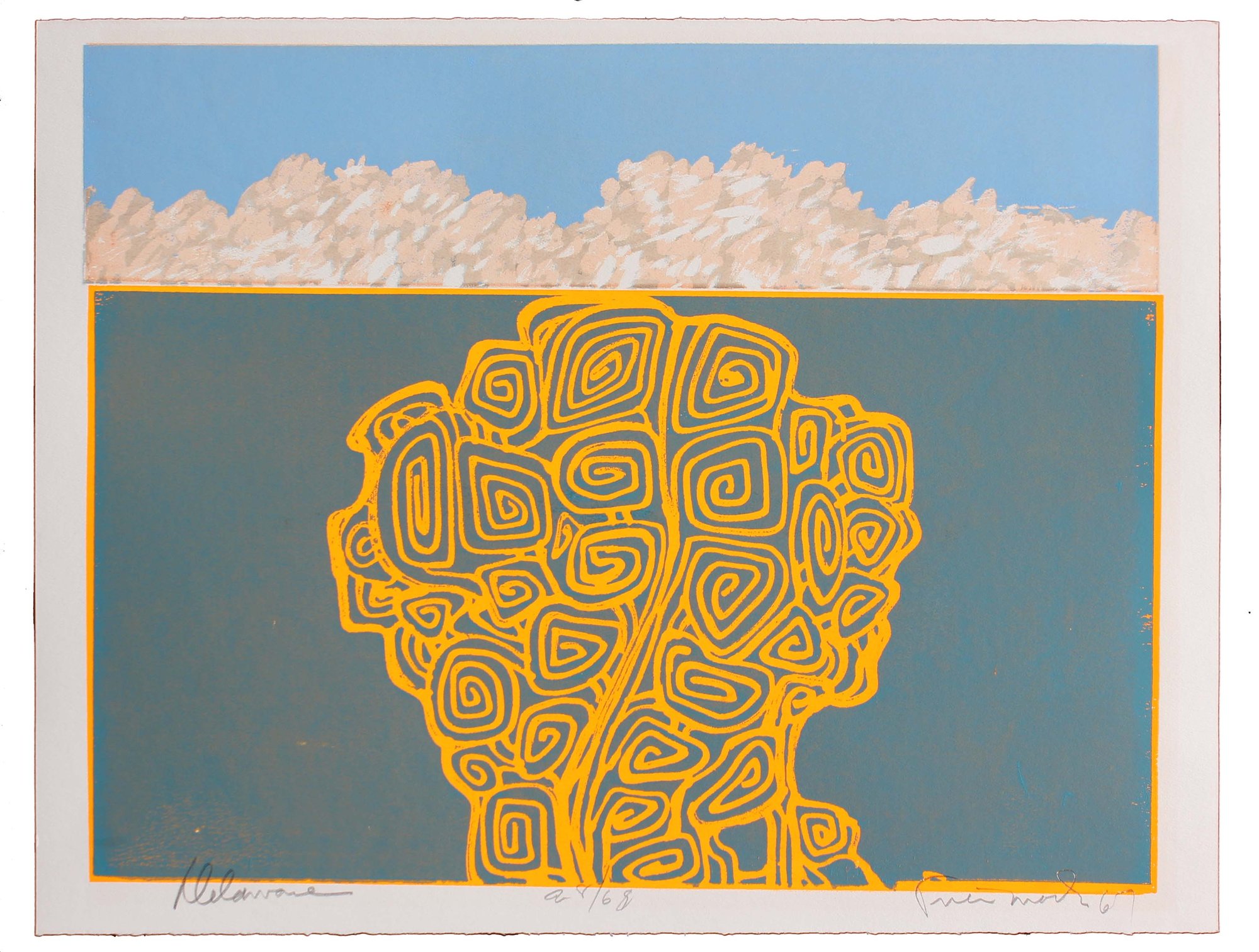
DELAWARE
17” x 21-7/8” – Edition of 68 – 1967
A state known for its yearly peach blossom blooms and a thriving agricultural industry. In Freimark’s own words, Delaware presents a double floral image – one abstract and one inventive form. The one of the mind, and the one of the eye, to rhythmically pronounce its visual sensation. In transparent pinks and blues juxtaposing the opacity of sunburst yellow which pierces its thalo complement – the colors of the American Crayon Company on a box thrown by a child in the well – the primary quotient of Delaware, snuggled beneath a tranquil masthead of light blue.
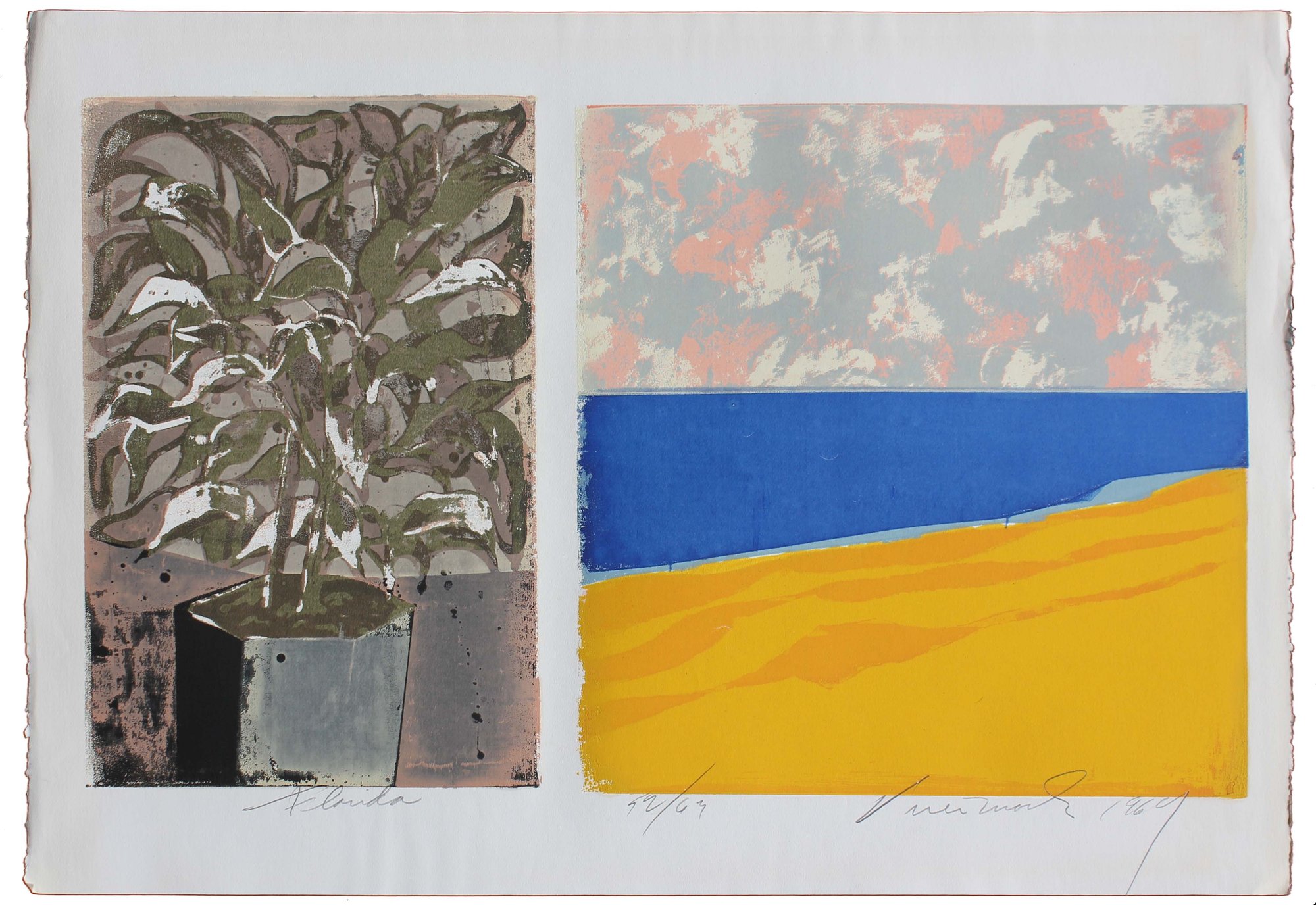
FLORIDA
14.25” x 24.25” – Edition of 63 – 1969
A potted plant, oddly rendered in shades of gray, top-heavy with boisterous leaves, announces Freimark’s depiction of Florida—a swampy, humid, hot, and wet state rich with the elements of overabundant desire. On the right sits a benign seascape, butter popcorn-cored sand and a blue sea, environment for vacationer’s, retirees, and the young, indulging on the great American beachfront. A cacophony of abstract expressionism, muted behind a white veil, sits above the water’s edge, heralding all that’s inspired beneath days of fun and sun, like a firework soliloquy, or a stab at first love: a great carnival exploding in the American sky.
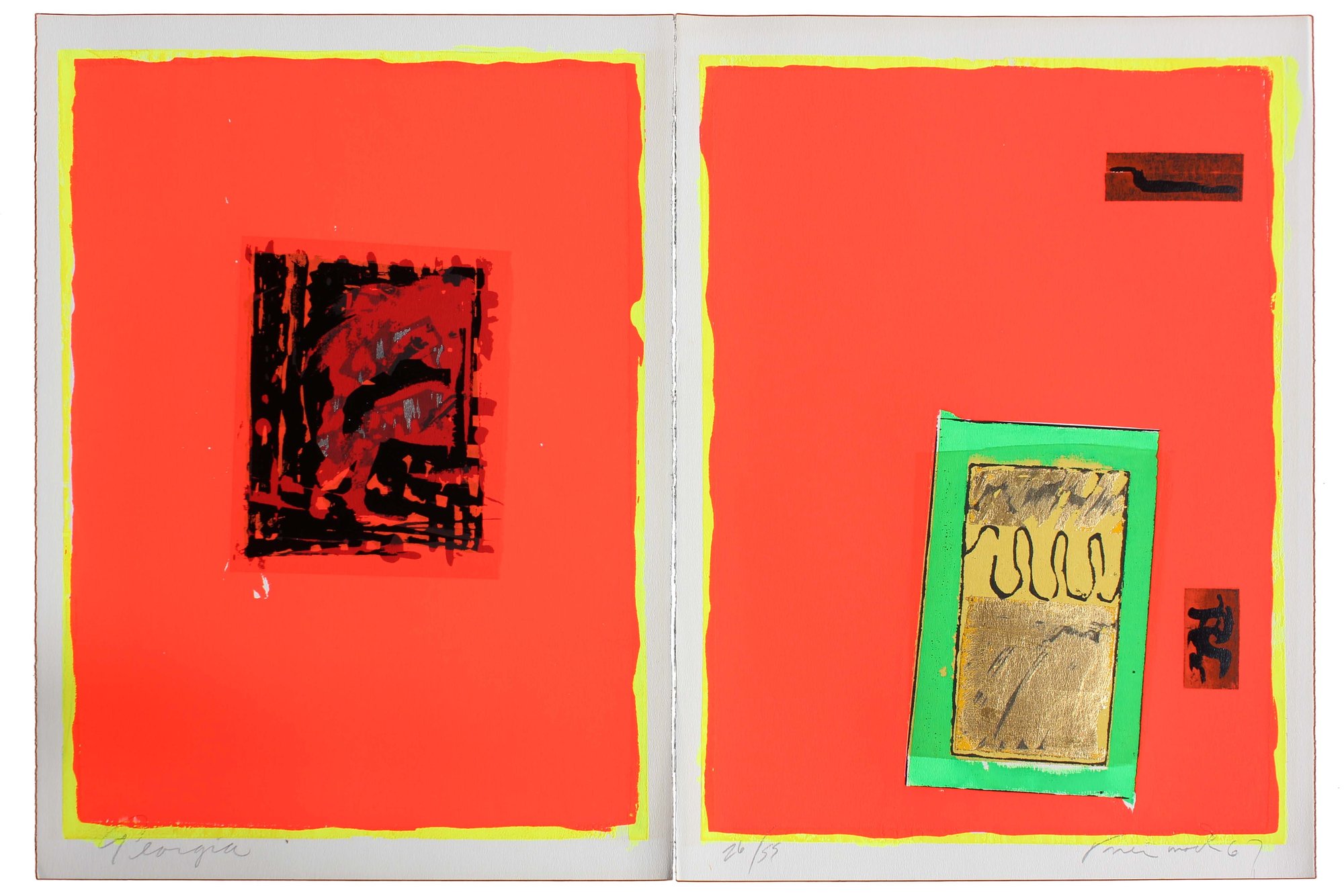
GEORGIA
Two panels 16-5/8” x 22” – Edition of 55 – 1967
A hot and pulsating tomato red background on two diptych planes demark the red clay soil that defined much of central Georgia, defined by the Piedmont plateau strewn with rolling hills and forests of oak and pine. A state of bold contrasts with lush and evocative landscapes rooted in the Deep South and a culture poised between the traditions of its agrarian past and the turbulence of the Civil Rights era. Freimark conveyed the relentless vigor of the feisty land in this piece, of which he wrote “Halfway up an insane hill there is still a rebel refusing to fall; when he is trapped, he will yell Charge!”
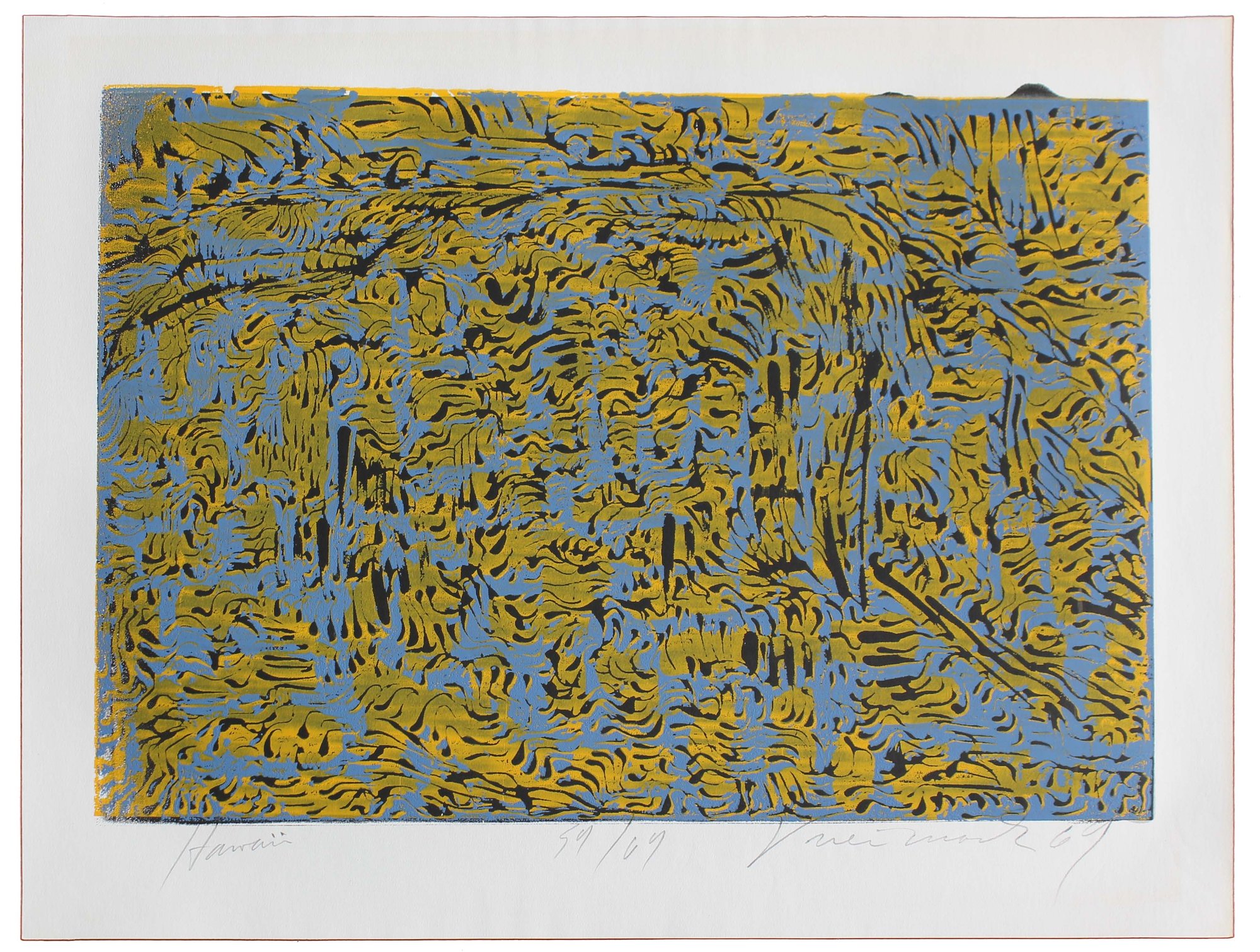
HAWAII
14.75” x 21.25” – Edition of 69 – 1969
Hawaii aptly represents the island chain state’s constantly morphing, tumultuous dialogue between land and sea, a relationship carving out its topographical presence for at least 5 million years. 137 islands have been documented over the course of this land’s existence, each an archipelago spawned by multiple underwater volcanic eruptions. This ever-shifting environment is reflected in Freimark’s print where chunks of earth float amongst the Pacific waters, tethered or tossed, but never stagnant. Born from oceanic crust plate explosions that continually activate, spewing lava up through the core of our planet, this distinctive space is called forth through spare color and raw form in homage to instability, fragility, and the inherent power of nature.
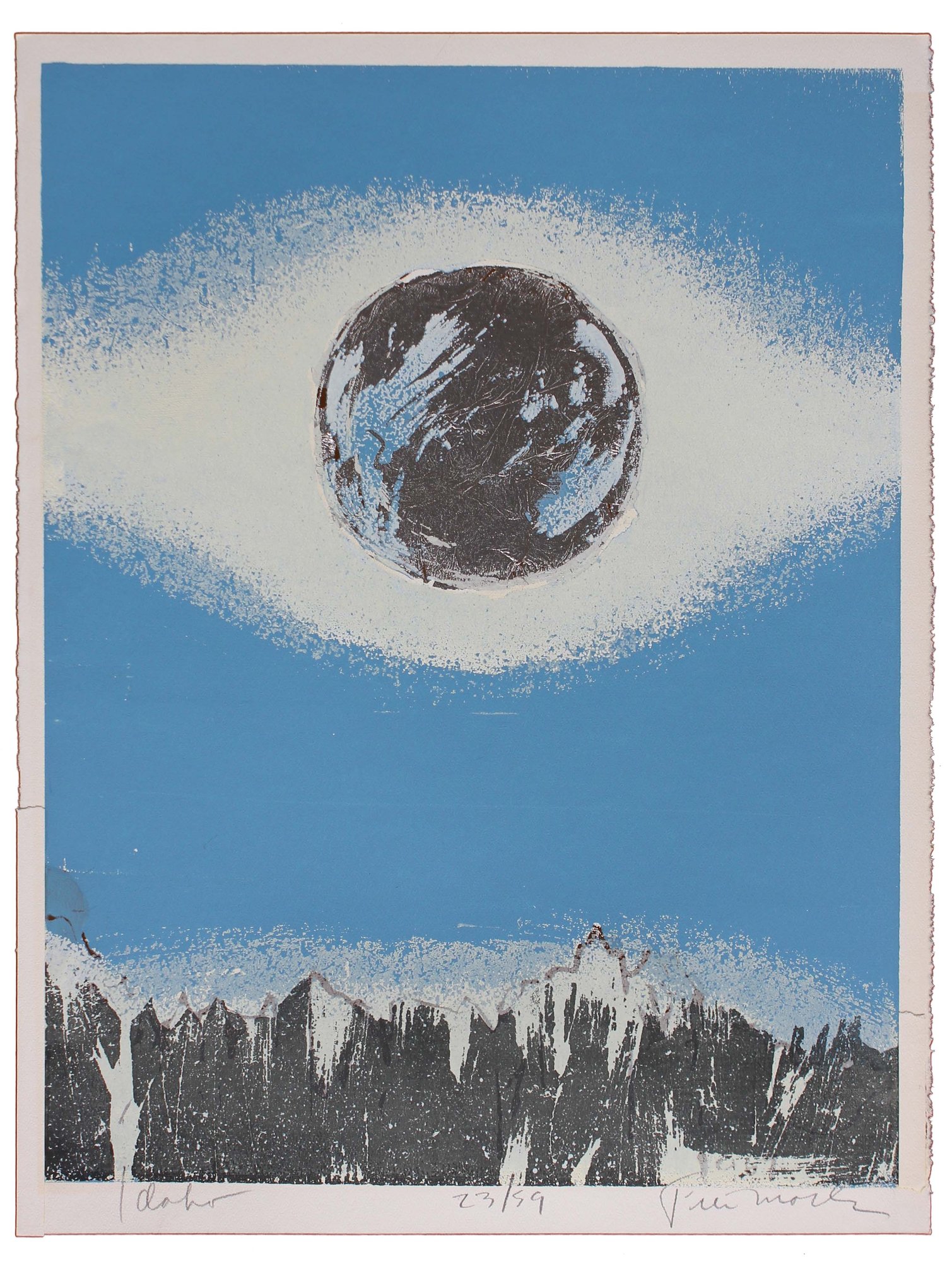
IDAHO
22-1/2” x 16-7/8” – Edition of 59 –1967
A cold blue background presents a rugged Western visage of dramatic geometry in a state known for its majestic mountains made of alpine peaks, deep canyons, and crystal lakes still largely untouched by humanity. In Freimark’s words, “the axe still rings on a frosty morning, making the deer move higher, their hot breath visible against the chill, and high in the rocky alps at night a glistening silver orb hangs suspended in a snowy light, proclaiming itself the moon.” A portrait of big sky and untamed beauty offering both livelihood and spiritual refuge in an era of rapid American change.
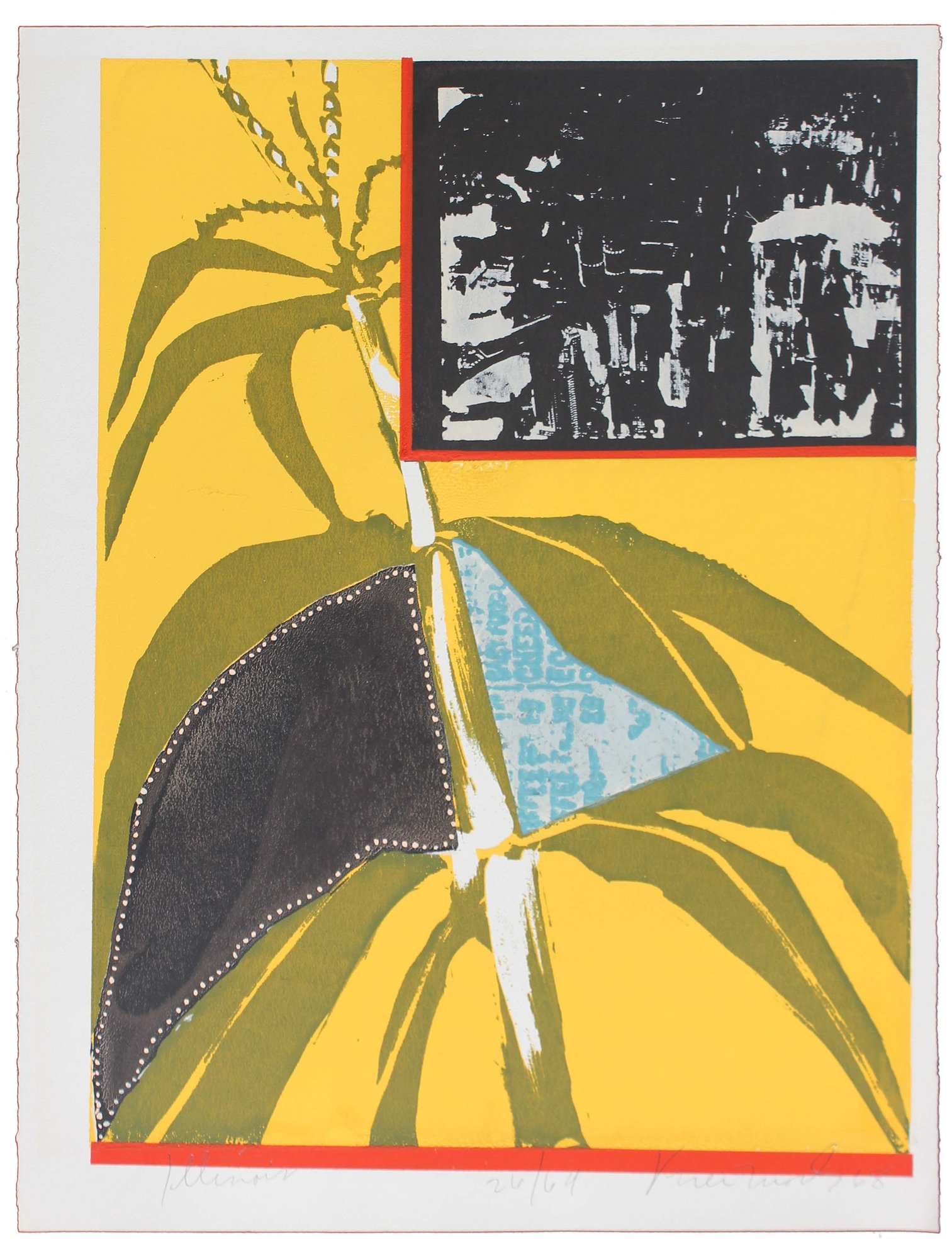
ILLINOIS
16-1/8” x 22” – Edition of 64 – 1968
An abstract stalk of corn on a butter yellow field dominates Freimark’s vision of Illinois, highlighting the state’s national grain crop. While simultaneously in the upper right-hand corner, a vignette shows the gritty black and white pulsing vibe of the city in all its enterprise and glory as a side participant to agriculture. For Freimark, “At the same moment a dusty tribune swirls in the eddies of Grant Park, up past the high rise that jabs the sky announcing Chicago, a small swirl of dry loam may envelop a farmer situated high on his gang plow, cutting with steel sixteen furrows that will seed and yield enough hybrid from DeKalb to turn an elevator’s insides yellow, come November.”
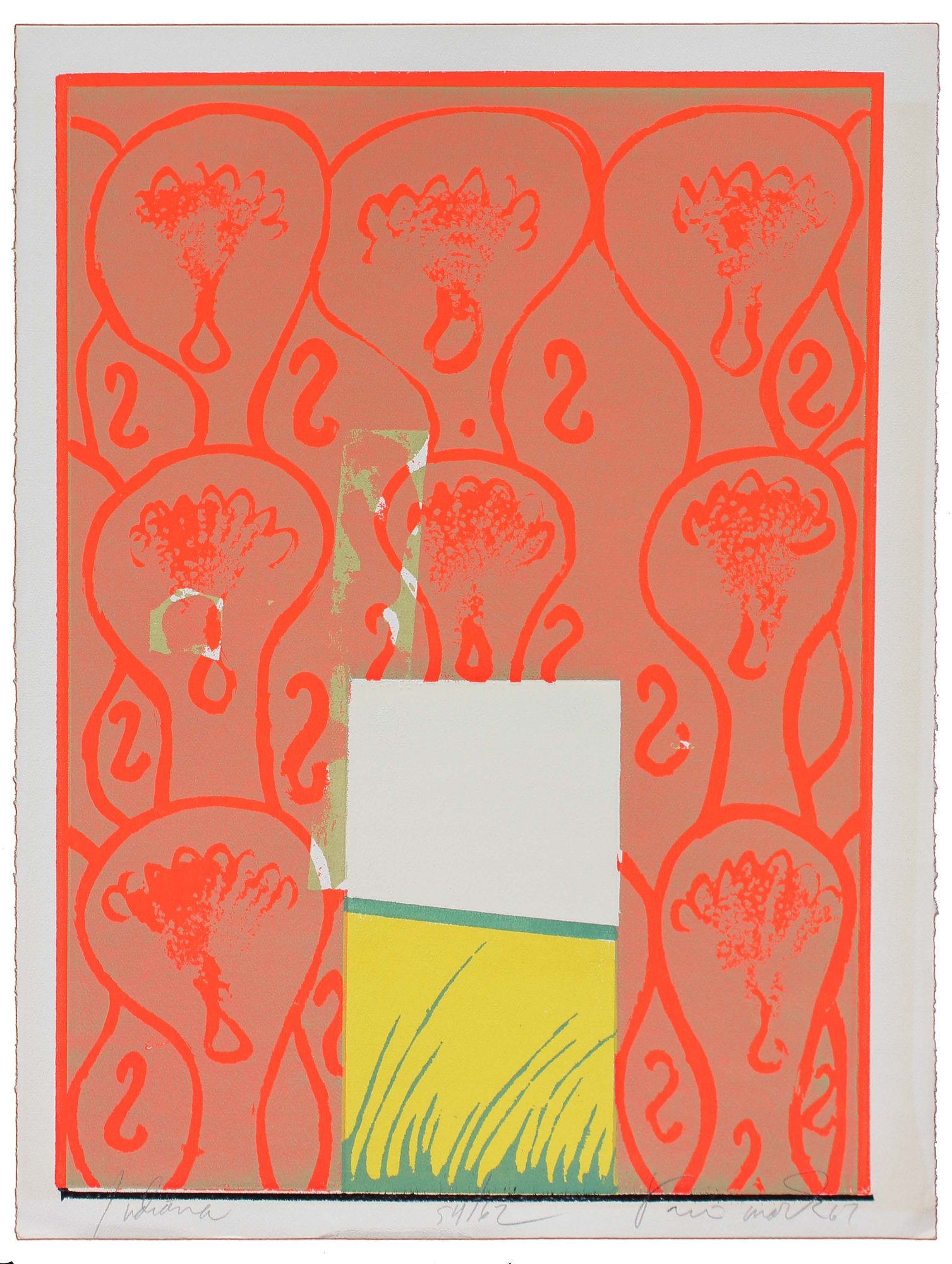
INDIANA
22.5 X 16.25 – Edition of 62 – 1967
A background of frenetic orange-red circles and squiggles ring with the phantom sounds of rubber shoes on athletic courts or tires on a racetrack, two notable past times of the Hoosier nation. In this crossroads of America, Freimark discovered the energy of speed alongside the low lazy wisdom of meditating in a corn field, beneath a pale cornflower sky, wisps of green stalks providing a temporary respite like a window into the soul’s ultimate presence. Perhaps the wandering artist enjoyed a slice of the state of Indiana’s famous sugar cream pie whilst wasting away an afternoon in a place known for its lingering hospitality. Or, as he mentioned in an ode to the place, this could be his version of writing a poem in the dust.
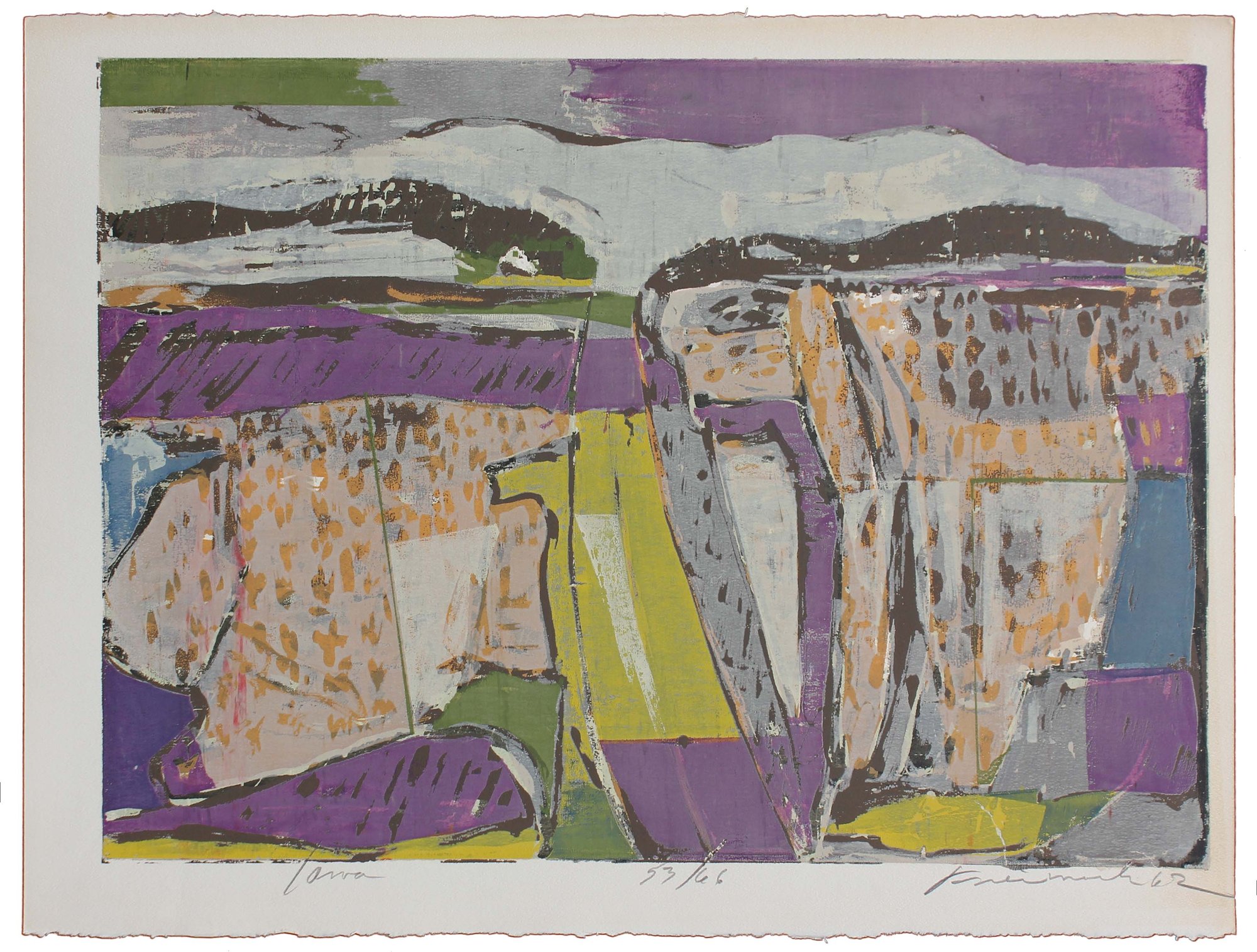
IOWA
15-3/4” x 22-1/4” – Edition of 66 -- 1962
A complex ten color serigraph aptly depicts a state of perpetual geometric plots reminiscent of a patchwork quilt in the colors of harvest on purple earth: chartreuse, green, brown, gray, white, and ochre. Embodying the true heartland character of Iowa derived of rich farmland, close-knit communities, church bells, grain elevators, cornfields, and town squares and a culture that balanced deep agricultural traditions, this piece represents the steady, fertile core of the American Midwest—a place of pragmatism and quiet prosperity rooted in the rhythms of land even as technology and social change began to reshape the fabric of rural life.
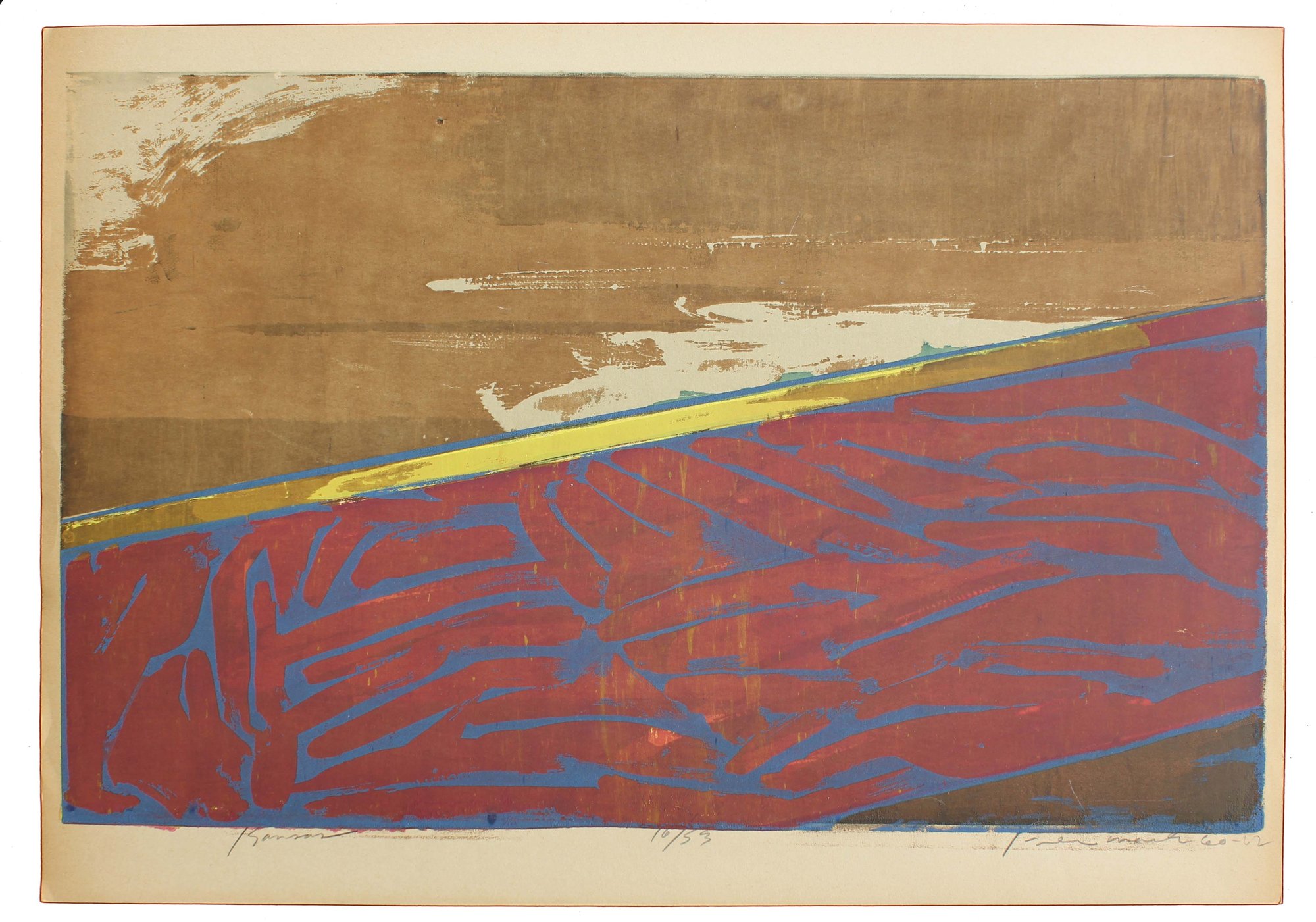
KANSAS
15-1/2” x 25-1/4” – Edition of 53 – 1960-62
Kansas was the initial print of the series, opening up possibilities for the entire suite. In it, we find a diagonal slash of purple earth rising up against a raw umber sky with a dividing strip of green, yellow, and brown where heaven and land marry. A Great Plains breadbasket synonymous with golden wheat, endless flatlands, softly rolling prairies, and long two-lane highways giving travelers a panoramic view of the immense Midwest sky. Located in Tornado Alley, Freimark wrote, “Flirting along the green horizon somewhere is a vestige of Thomas Hart Benton’s bully tornado, ready to knock the daylights out of the first helpless homesteader he happens on.”
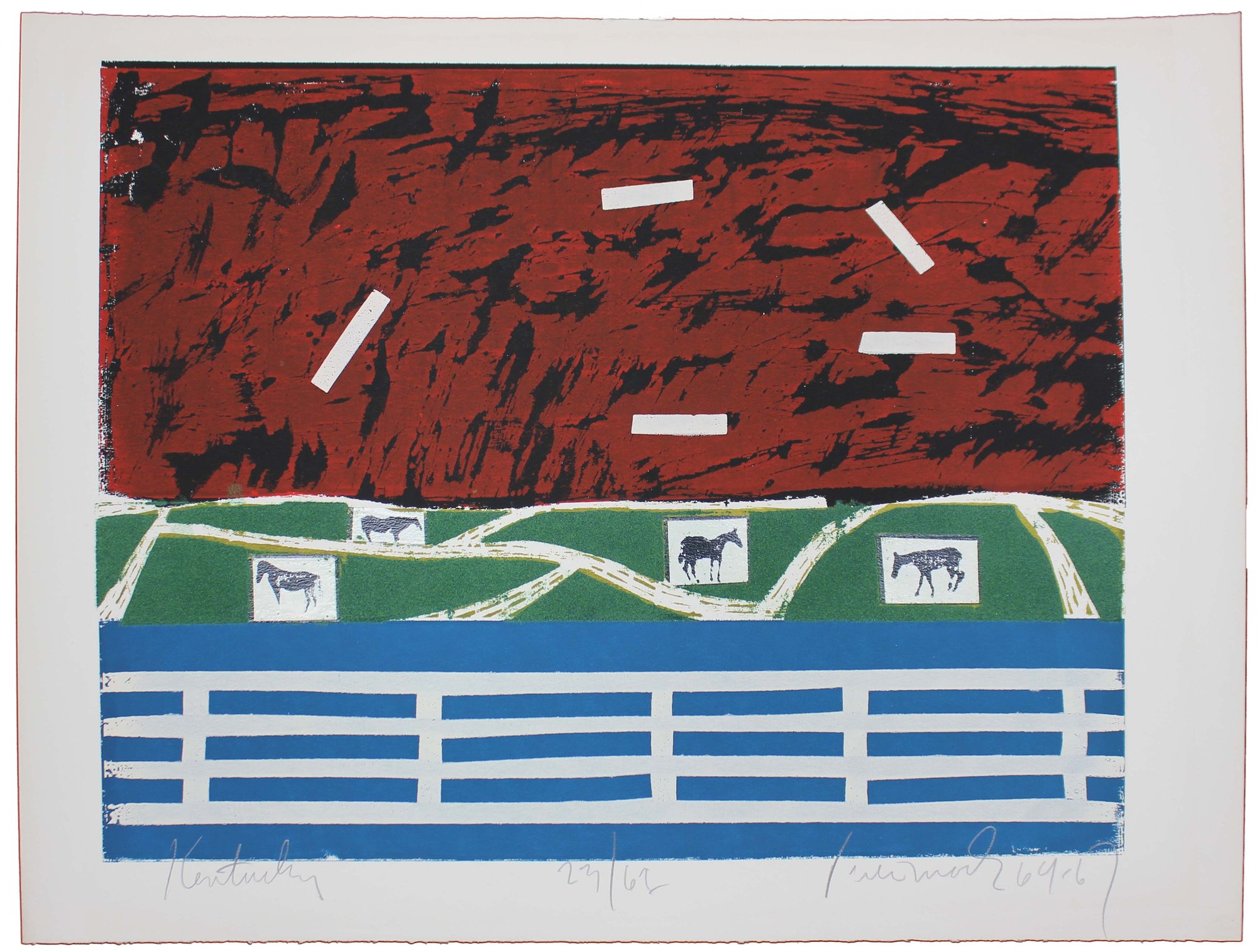
KENTUCKY
15-1/2” x 20” – Edition of 63 – Created in 1964-67
Kentucky pays homage to the nationally renowned and beloved pastime of the state, horseracing at the Kentucky Derby, where Freimark found a love for the sprawling acres of velvety green grass framed by immaculate fences where a hearty equine population grazed and roamed. Field, animal, and enclosure are all reflected here as evidence of man’s amusement Rugged maroon-red hills form the upper half, the color of bourbon –another pride of the place – along with the coal mining industry. White strips dot rocky terrain as if scars left by man or an abstract map of gashes made in earth for entering underground.
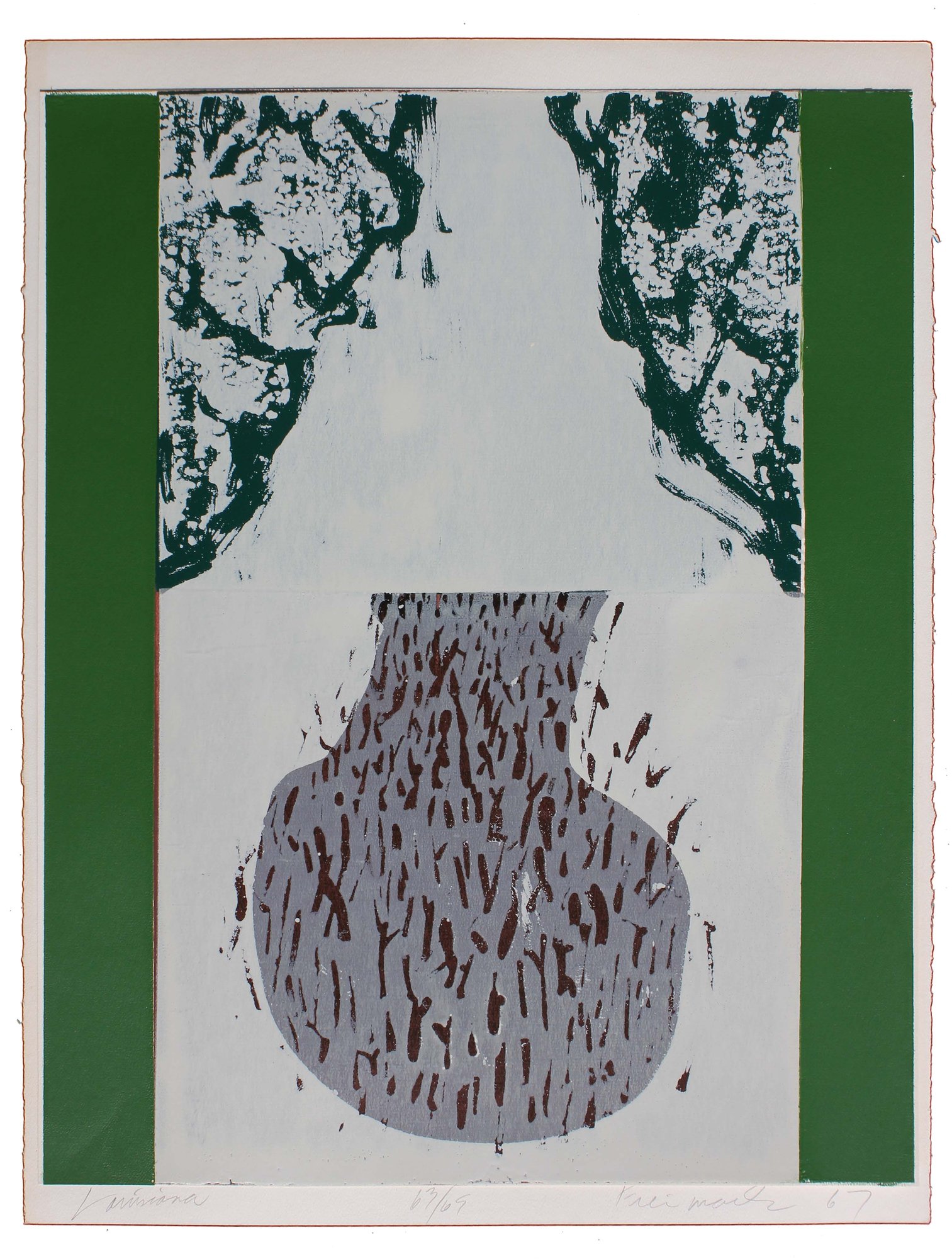
LOUISIANA
17-1/4” x 22” –Edition of 65 –1967
A hunter green border encases this glimpse of a state defined by its wetlands and humid lush swamps, centered with a gray and sunken pot of soaked earth from which a chaotic flurry of marsh grasses grows. According to Freimark, “Deep in the bogs of the bayou a man is in another country, where the silken moss hangs heavy in the trees, and the ghost of a butterfly he never saw before lights casually on a stump. Over yonder are thousands of beckoning fingers, the extruding stumps and branches of drowned cypresses, calling him, urging him further on.” His Louisiana is sensual, conflicted, and alive with rhythm.
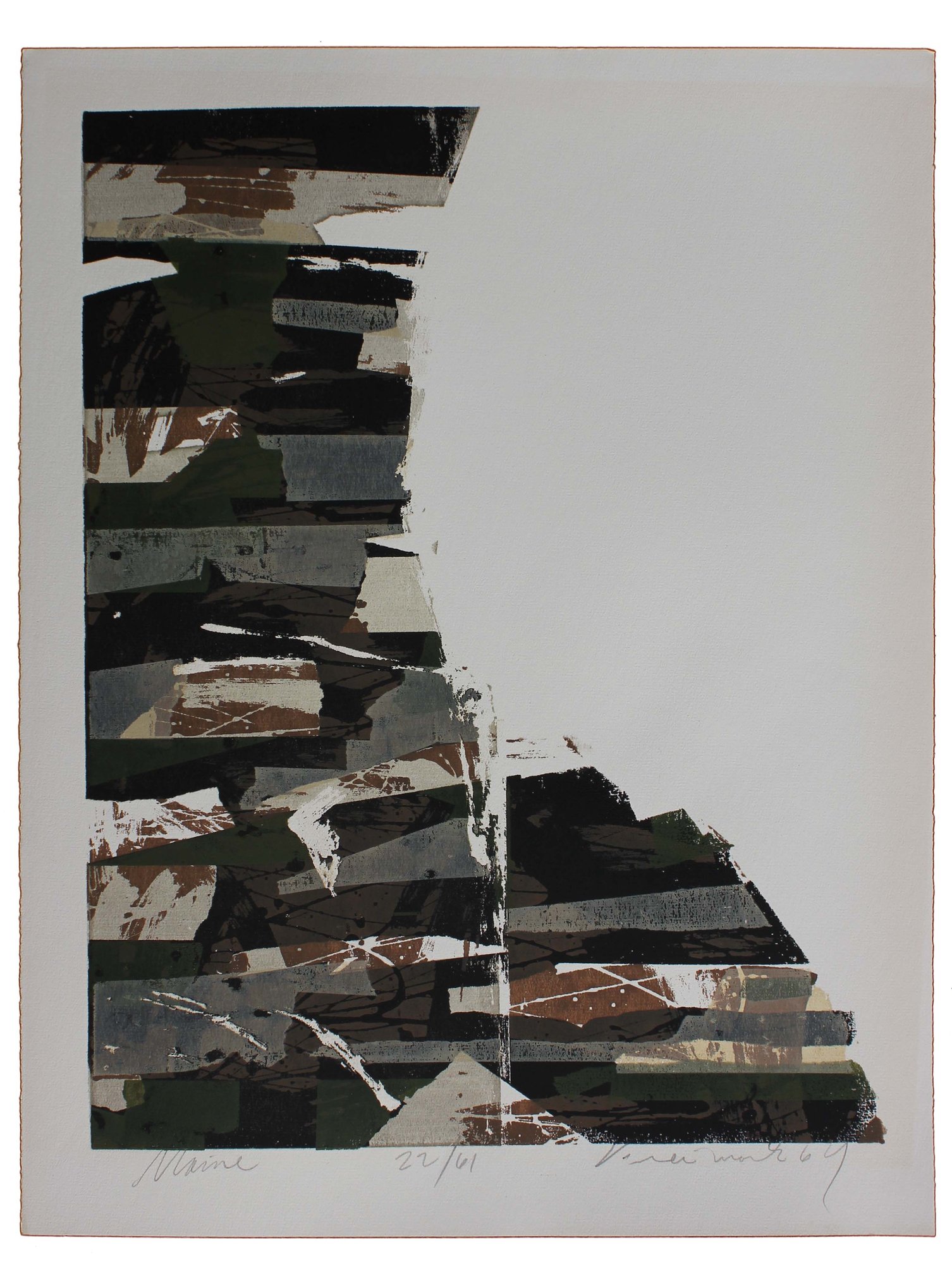
MAINE
15-3/4” x 21” – Edition of 61 –1964
Overlapping tones of moss green, foam white, sandstone brown, and transitional black strips become a metaphor for the stratified rockbound coast of Maine cradling an open harbor—the jagged line where each meet implying the forces of the elements and erosion. A modestly sized, quietly resilient, and naturally spectacular state Freimark visited upon a destroyer ship during the period when America was giving the ships to England. This homage to his encounter conjures a rugged salt-scented blend of timeless New England landscape during a time of slowly modernizing economy when lobster boats and logging trucks shared the roads with station wagons full of vacationers.
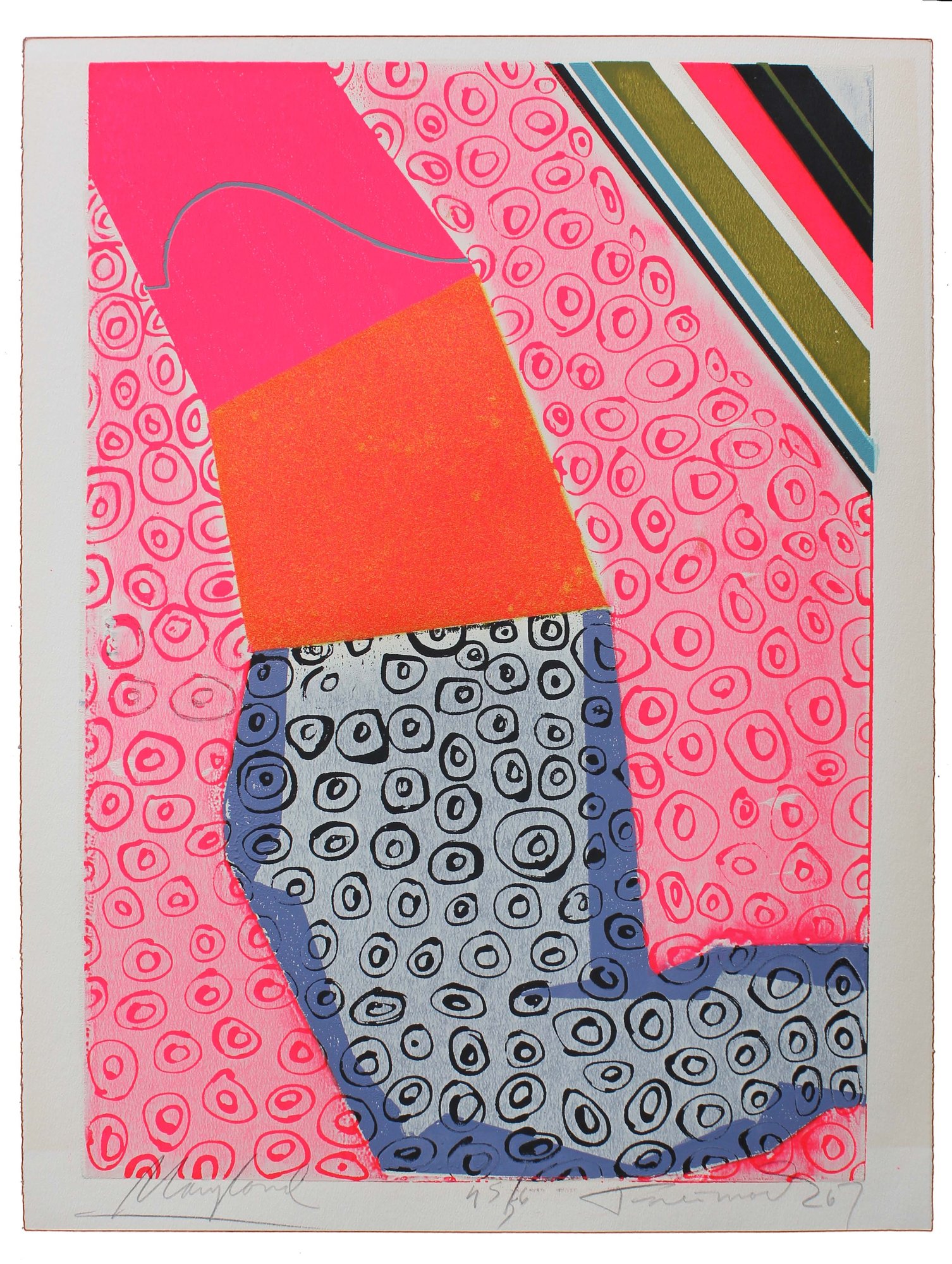
MARYLAND
15-5/8” x 23-1/2” – Edition of 56 – 1967
Freimark called Maryland “the most well-named among the fifty states,” based both on its lilting allusion to the female name Marilyn as well as the play on the word “merry.” Merry being the mood he felt was synonymous with the land of blue crabs, oyster harvests, watermen culture, skipjacks, and seafood shacks. In his abstract rendition of the Chesapeake Bay, throbbing with magenta, lavender, cerulean, hot pinks, and orange, we find whorls of bivalves and mollusks, content within their briny home. The upper right-hand corner is striped in the multi colors of a border state in transition—part Southern heritage and part Northeastern modernity.
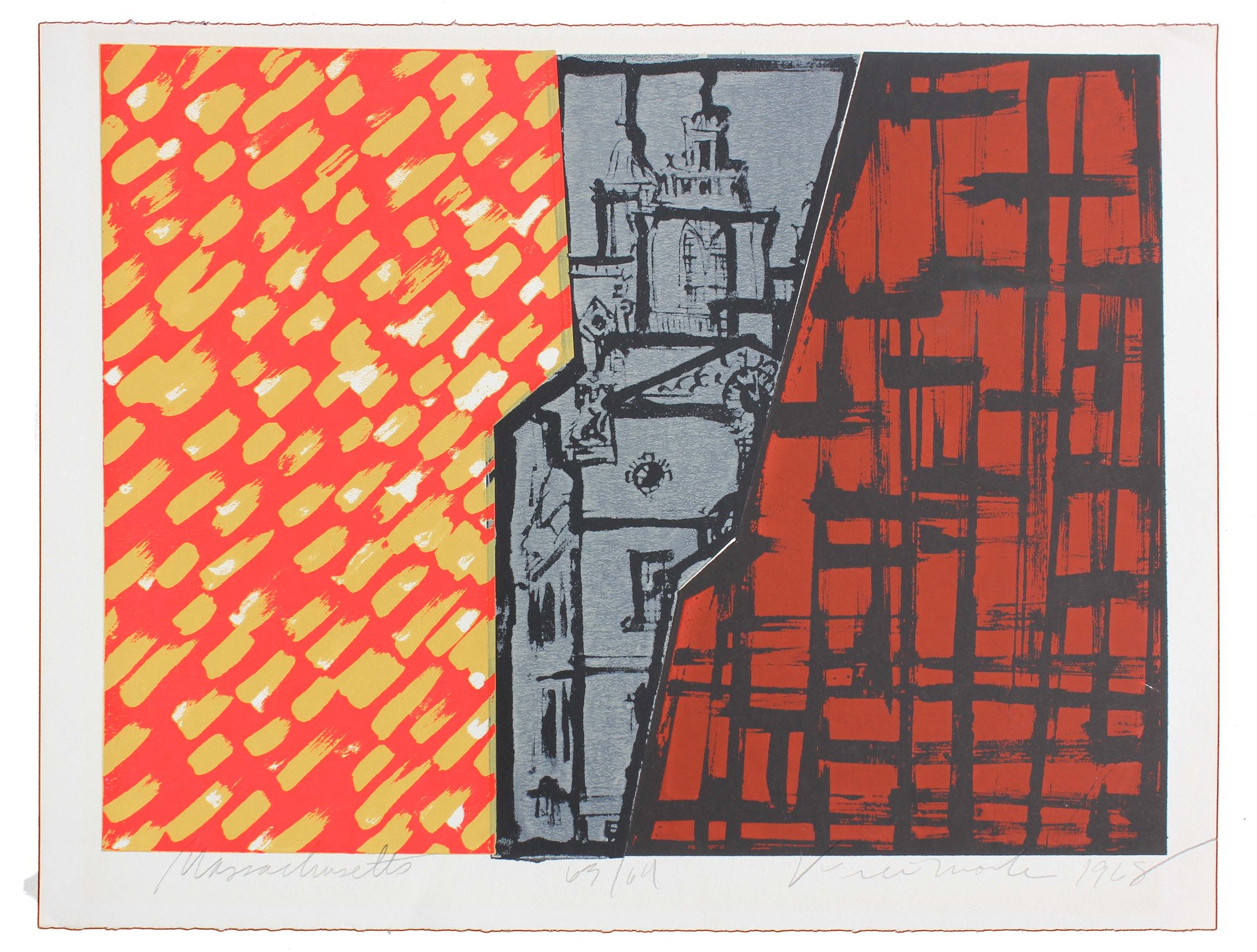
MASSACHUSETTS
16” x 21-3/4” – Edition of 64 – 1968
In the vibrant intellectually charged state of Massachusetts where colonial heritage met countercultural revolution, Freimark found “hot little girls from Revere who lay in the Common’s grass, speaking of independence. Meanwhile, at Naragansett, nestled by slate, is a cove of sand to wrench clams from. Usually they lie open, their presence revealed by a slight round orifice of air, or an inane bubble. But they can seal themselves immediately, even against bright steel.” This five-color serigraph reverberates a sense of old bricks and new ideas—a place where the past and the future were colliding, accentuated by electric dabs of fluorescent cerise.
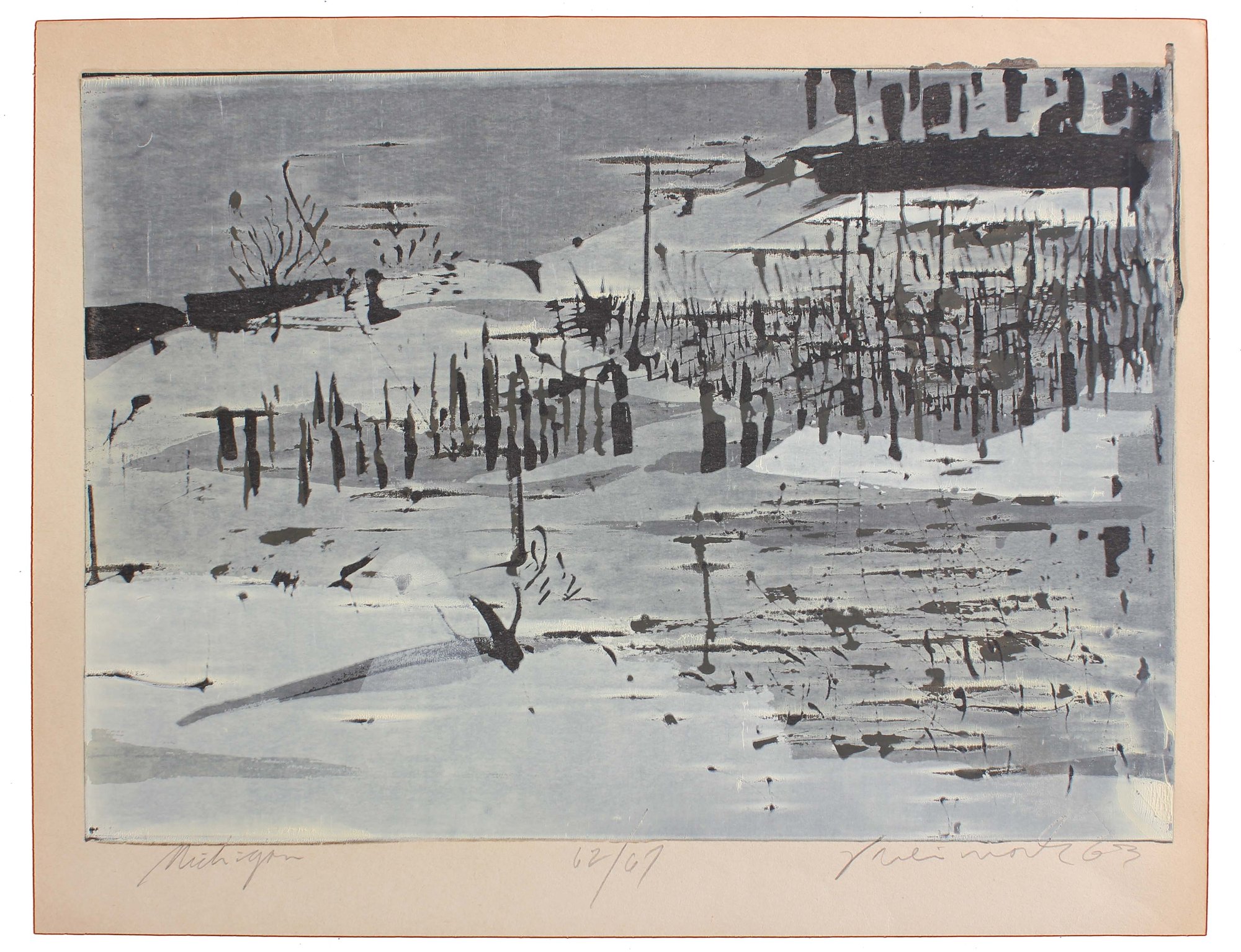
MICHIGAN
15-3/4” x 23-1/2” – Edition of 67 – 1963
The Northern finger of Michigan, celebrated for its pine forests, clear lakes, and the Porcupine Mountains was a spot where Freimark had “skated on frosty ponds, and by the horns dragged home my deer. I, too, swung on birches and watched the lake lap, licking up stretches of gold. I walked the miles of sand and shells without ever another being. Finally, in a cove was my lighted cottage. I hope, where the brook turns, there is yet a trout hiding.” A memorable scene revealed expertly here in black, white and nostalgic gray. A place of rugged yet serene respite.
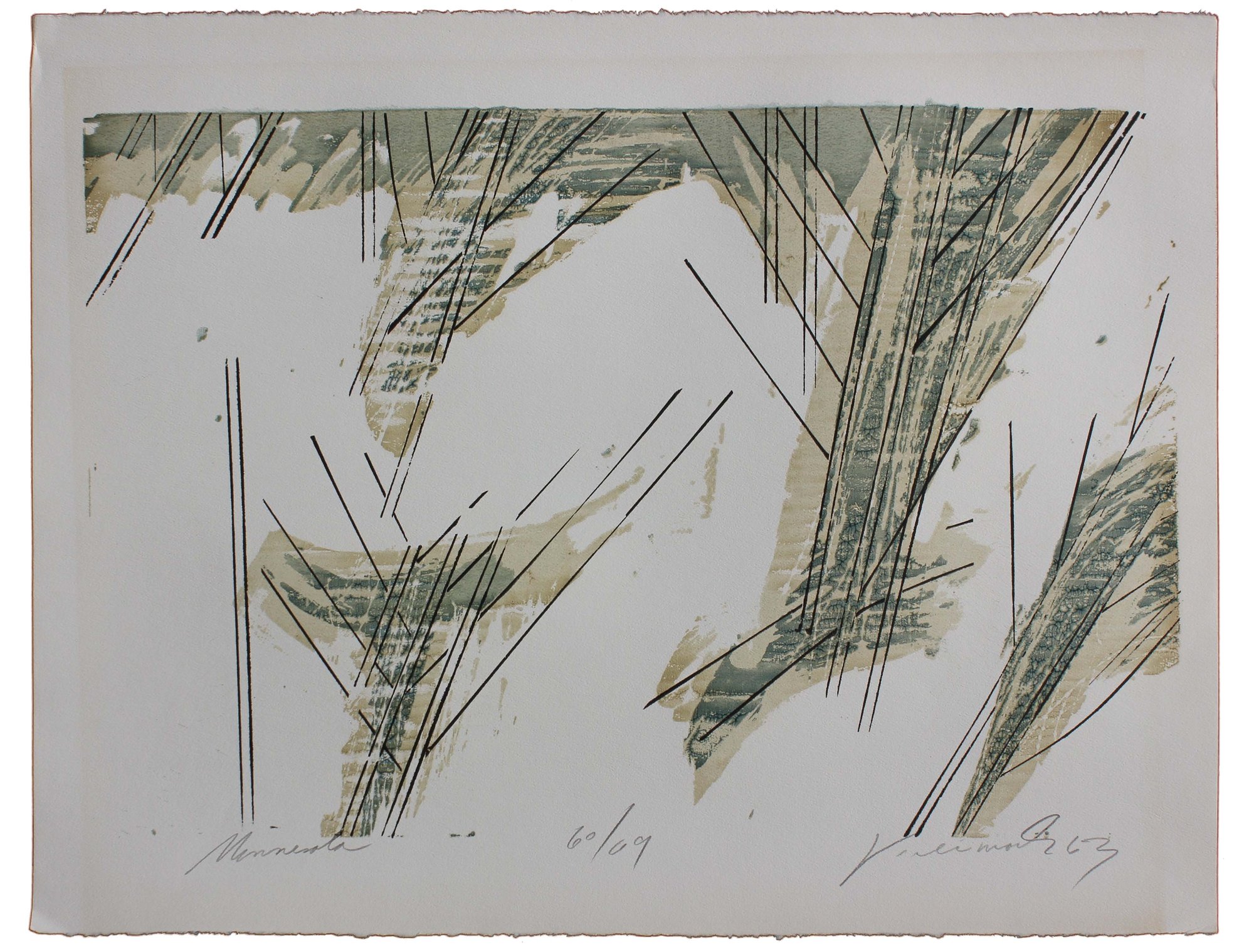
MINNESOTA
14-1/4” x 22-1/4” – Edition of 69 – 1963
In this land of 10,000 lakes Freimark saw that “The snow falls far and wide and deep in Minnesota. It reduces the landscape to a Nordic simplicity which even a child comprehends …
Lurking somewhere beneath these snows lies the saga of myth, and the bones of Hiawatha. Here at its edge is our most superior lake.” Subdued and neutral hues of tierra verte and tan with sharp jet-black incisions in this simple three-color serigraph denote peek-a-boo glimpses of a terrain otherwise obliterated by mother nature’s frosty breath up to six months a year, spreading powerful squalls across the northeastern towns.
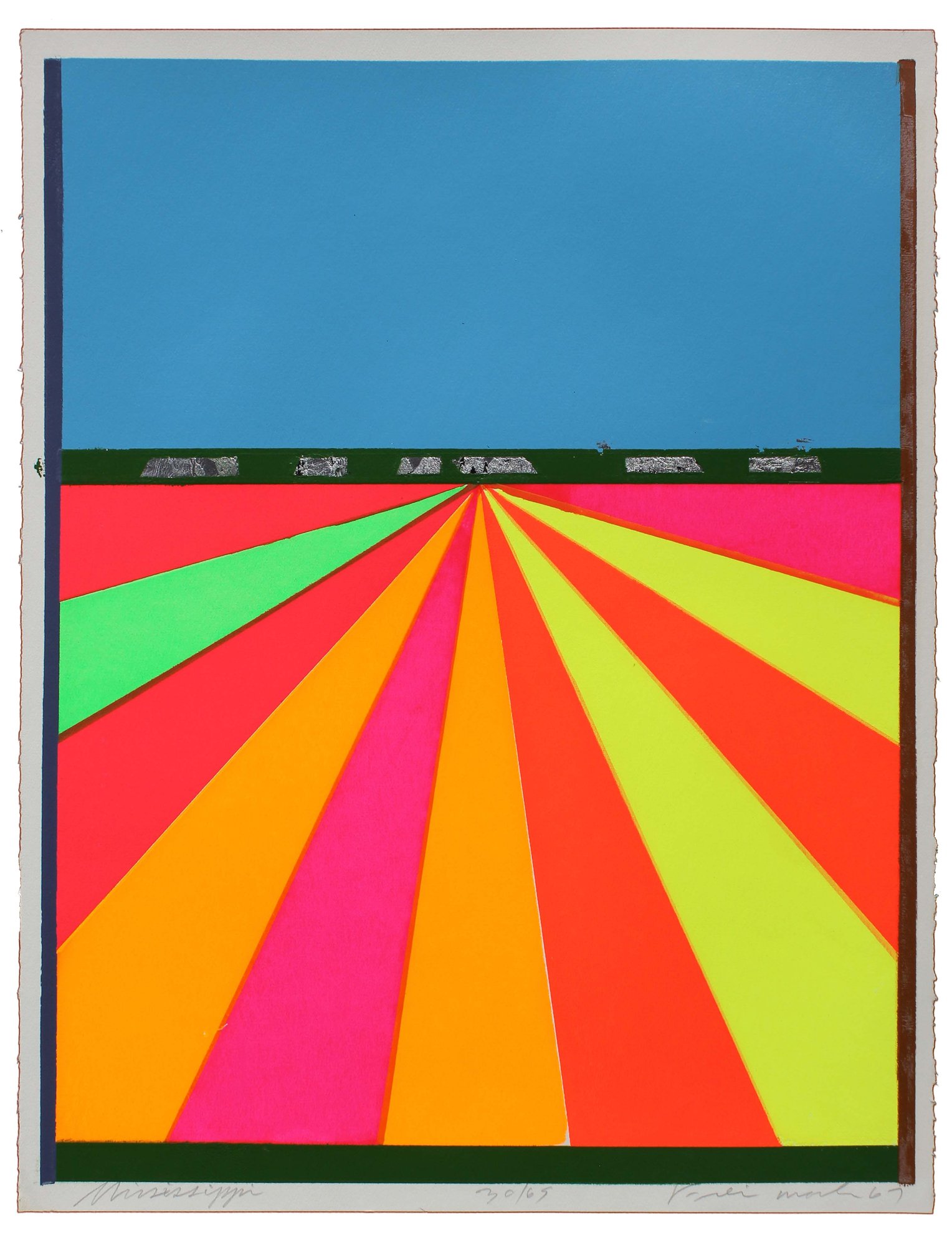
MISSISSIPPI
17-1/2” x 22-3/4” – Edition of 65 – 1967
A stunning eleven-color serigraph in flame pink, lemon, sunburst yellow, bright orange, and viridian fluorescent articulates the state’s defining feature, the Mississippi River Delta. A fertile plain of cotton and soybean fields, levees with catfish a-jumping, and blues music traditions stretching along the western edge in a time when the area was still largely rural, agriculture dominating its economy even while modern industry was slowly replacing the sharecroppers. Freimark wrote, “Anyone who has stood anywhere in Mississippi has experienced row upon row of cotton and crops converging where the sky meets the land,” and “If they see a rainbow, this is where they see it.”
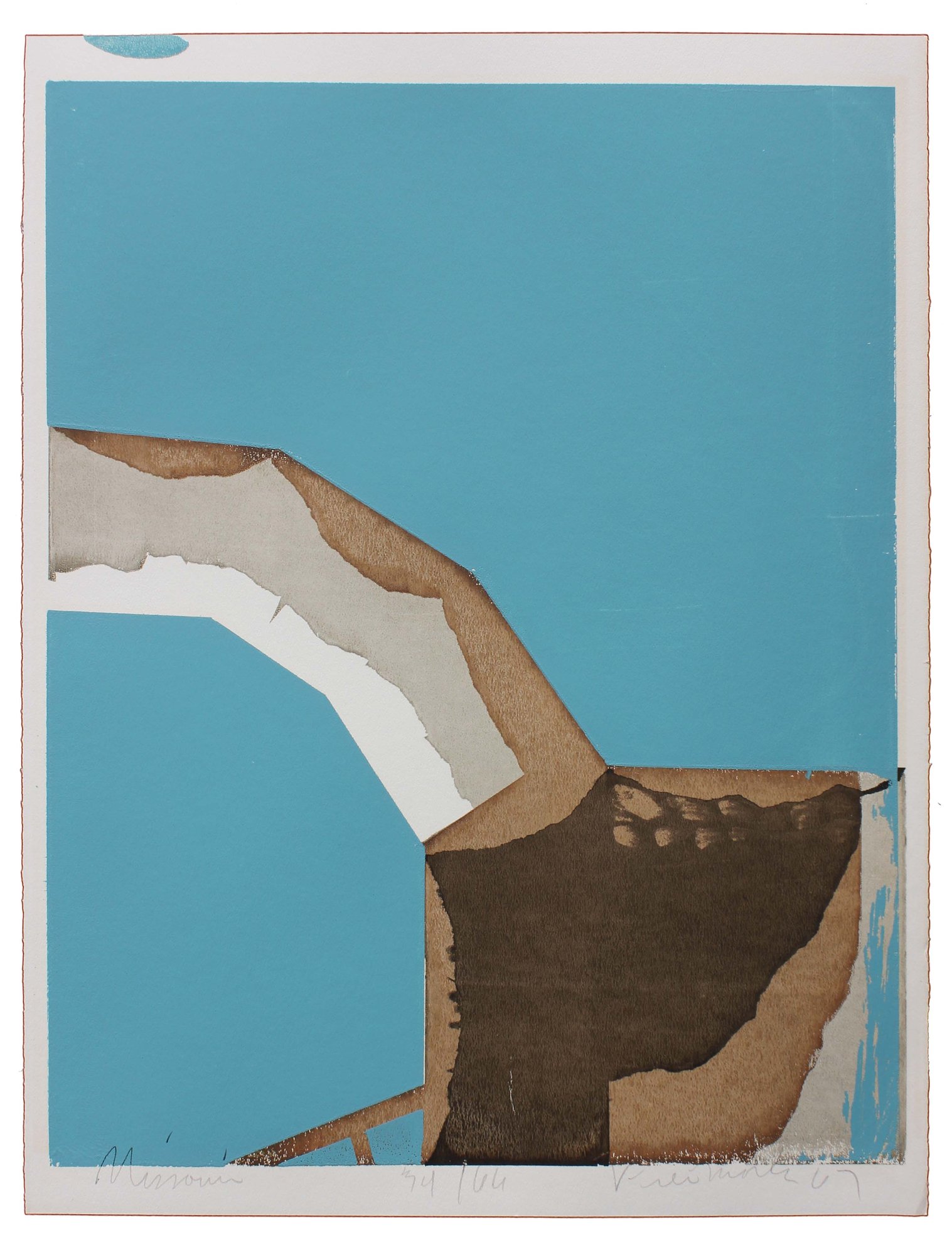
MISSOURI
17” x 22-1/8” – 1967
Missouri is depicted in soft sand and burnt sienna tones, set against a muted blue sky. This simple yet powerful representation captures the essence of the “Show Me” state, revealing the rich landscape beneath its unassuming surface. Freimark was drawn to Missouri’s golden hills, particularly the St. Francois Mountains, one of the oldest igneous rock formations in North America. The painting also hints at the state’s over 6,000 caves, earning Missouri the nickname “Mother of the West.” The composition reflects the state’s natural beauty and vast, open spaces.
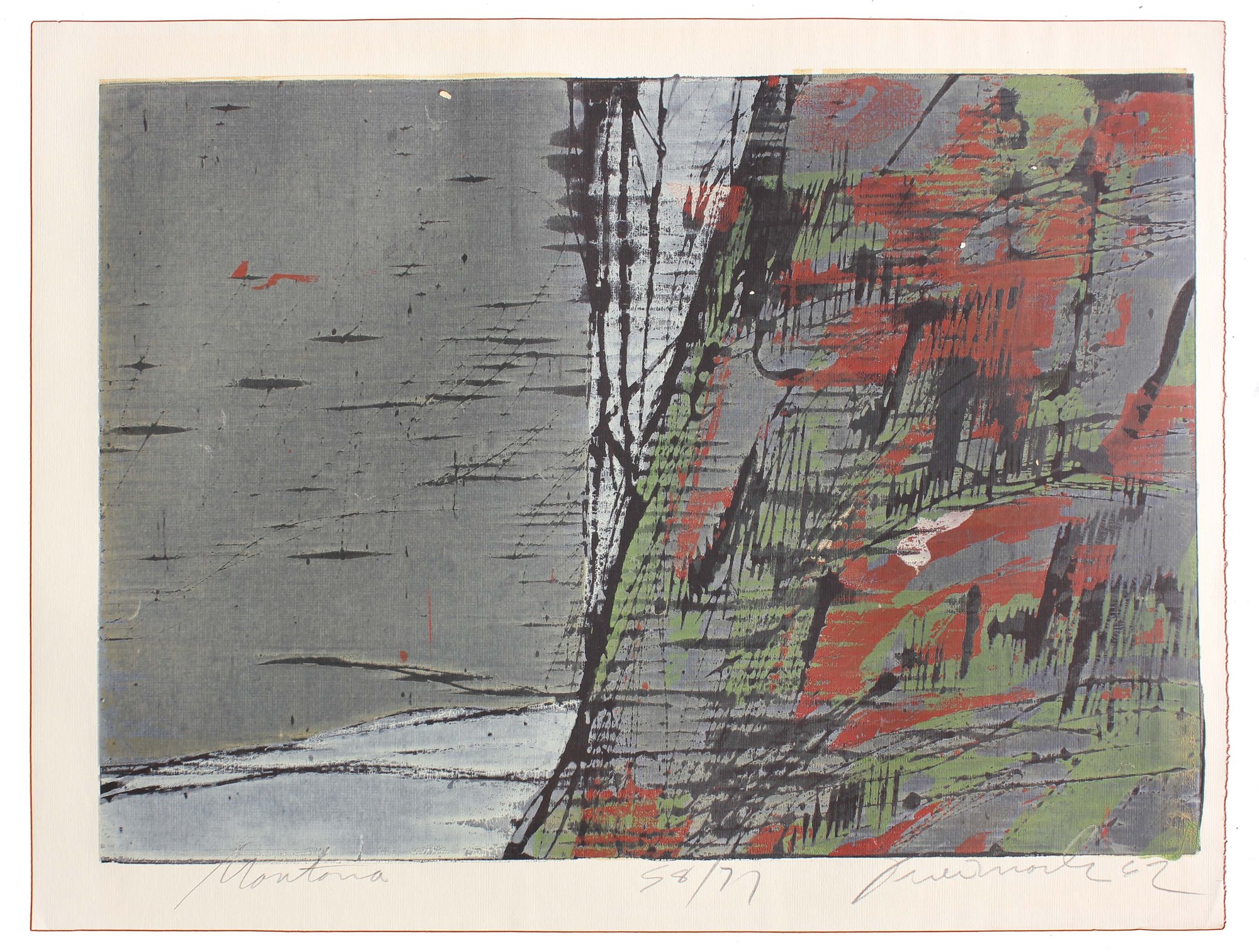
MONTANA
15-1/2” x 22” – Edition of 71 – 1962
Yellow-gray, sharp verdant green, earth red, and black on the right compose the hilly half of the state, which Freimark viewed in two—the other being flat and seen here, washed with gray. He wrote “In west Montana people do things people do in the mountains. In east Montana they live on the plains. The people of Montana are still, as they always will be, very aware of their environment. Ranchers look like the cracked and windswept prairie, and they are restless when they get off a horse.” But regardless of which type of terrain one stood upon, the Big Sky Country dwelt beneath endless horizons.
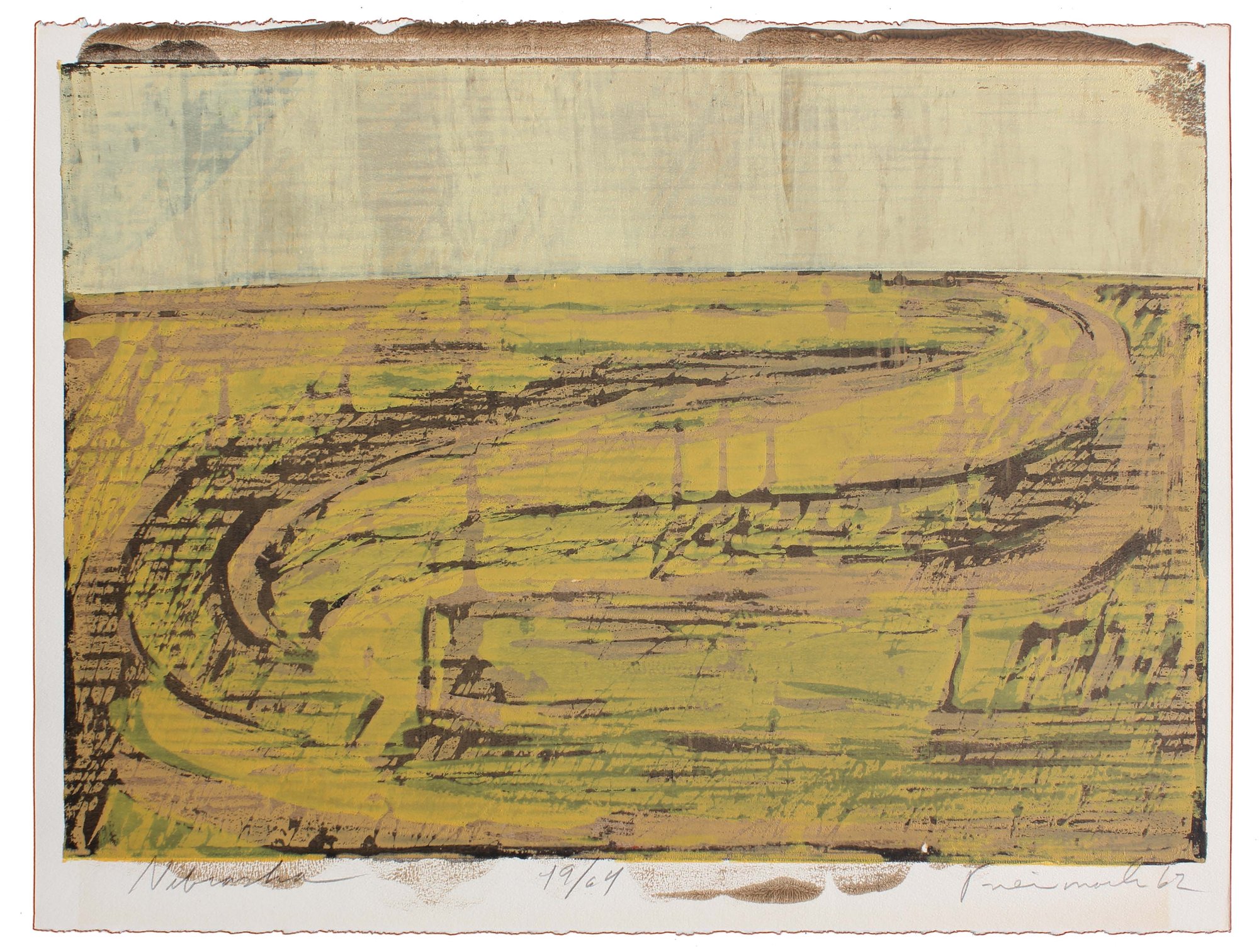
NEBRASKA
15-3/4” x 23” – Edition of 64 – 1962
A six-colored serigraph of cream, gold, brown, and green portrays the calm and undisturbed land of rolling yellow wheat from east to west that is Nebraska. A Great Plains heartland stretched across rolling prairies, sandhills, and river valleys birthing both rich, loamy farmland and vast grass-covered dunes. Freimark called it a “land where it is safe to make a prediction,” as its mellow climate and everyday character remained steadfast and familiar. Similar to its personality of moderate conservatism, and being the only U.S. state with a unicameral, nonpartisan legislature, a point of pride for political independence.
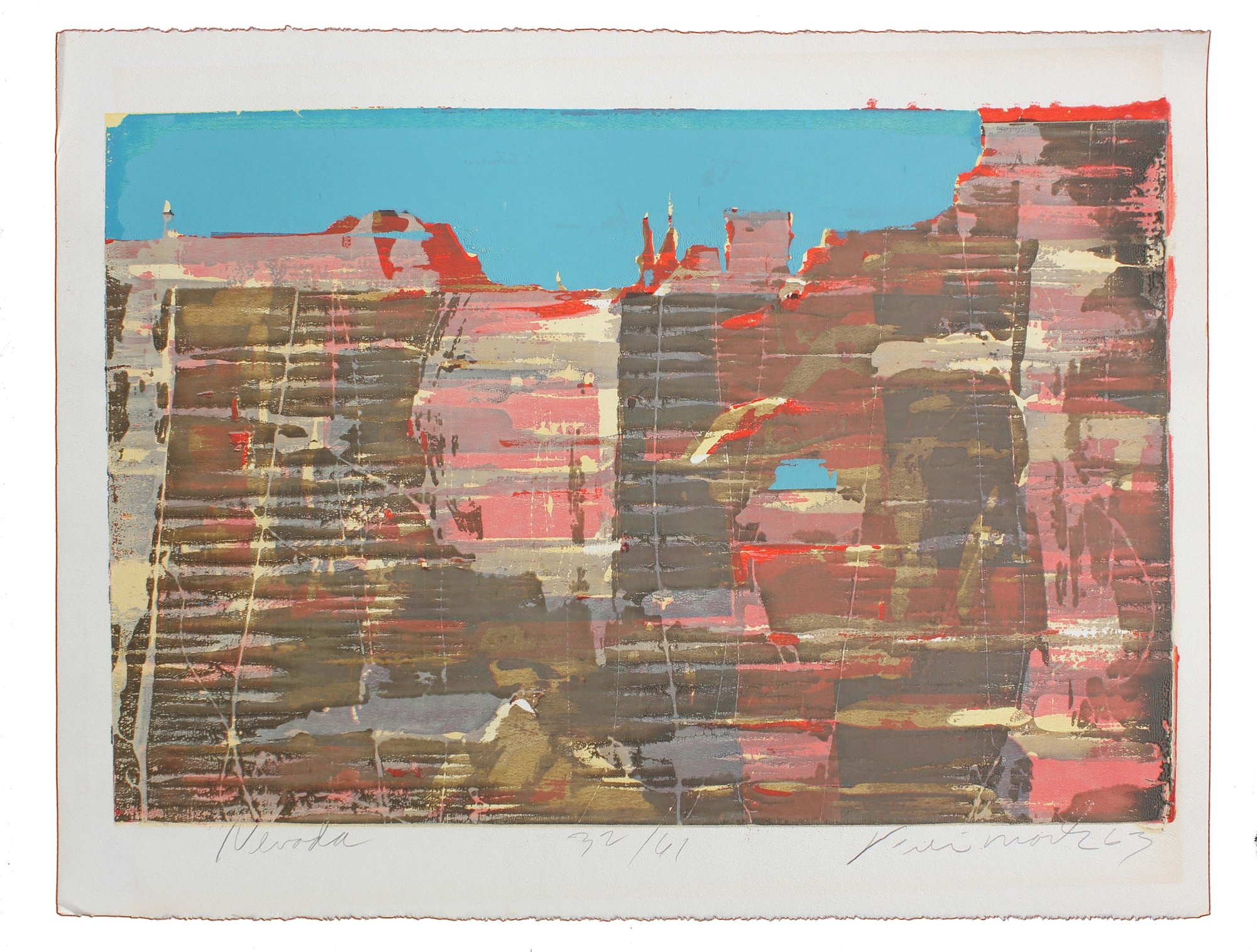
NEVADA
14-1/2” x 22” –Edition of 61 – 1963
Beyond the neon pull of Las Vegas, Freimark fell for Nevada’s natural high desert beauty rife with steep-elevation basins that featured sagebrush, rabbitbrush, and salt flats, glowing silver in the morning light and rose-gold at sunset. “Here in this arid sphere, here with the sweet smell of sage hovering nearby, here there is blue and the color of gold…Amputate the cities, and this land will stand with any.” Amongst its many geographical features, here we find a wall of fiery sandstone formations, cliffs rising up to conceal dramatic slot canyons, made of fiery red rock and the etched strata of time
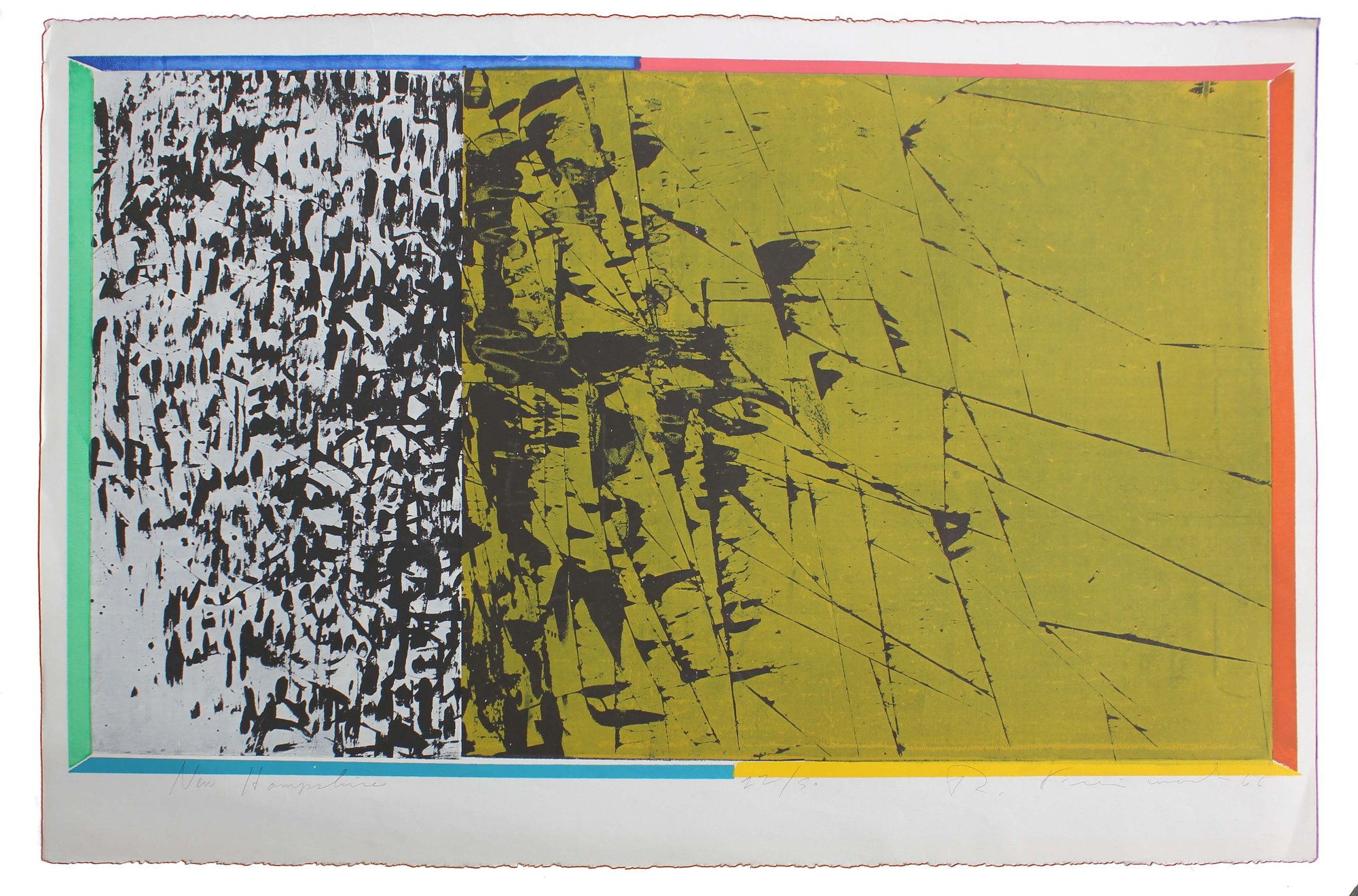
NEW HAMPSHIRE
22-1/4” x 38-1/2” –Edition of 50 –1966
Freimark saw New Hampshire as a “meadow without impurities, cut into king-size portions by gurgling streams,” and rendered it with the affectionate precision of a cartographer of feeling. Through his eyes, a vast olive-green patch seems to ooze left into the lap of a black-and-white body of feisty, playful water, whose fingers in turn meander back through the grassy field like curious tributaries. A vibrant fluorescent border, pulsing with pink, blue, yellow, green and orange, frames the scene like a glowing map edge, underscoring the artist’s evident love for this state of hardy beauty, granite steadiness, and quiet, ongoing transformations of season and light.
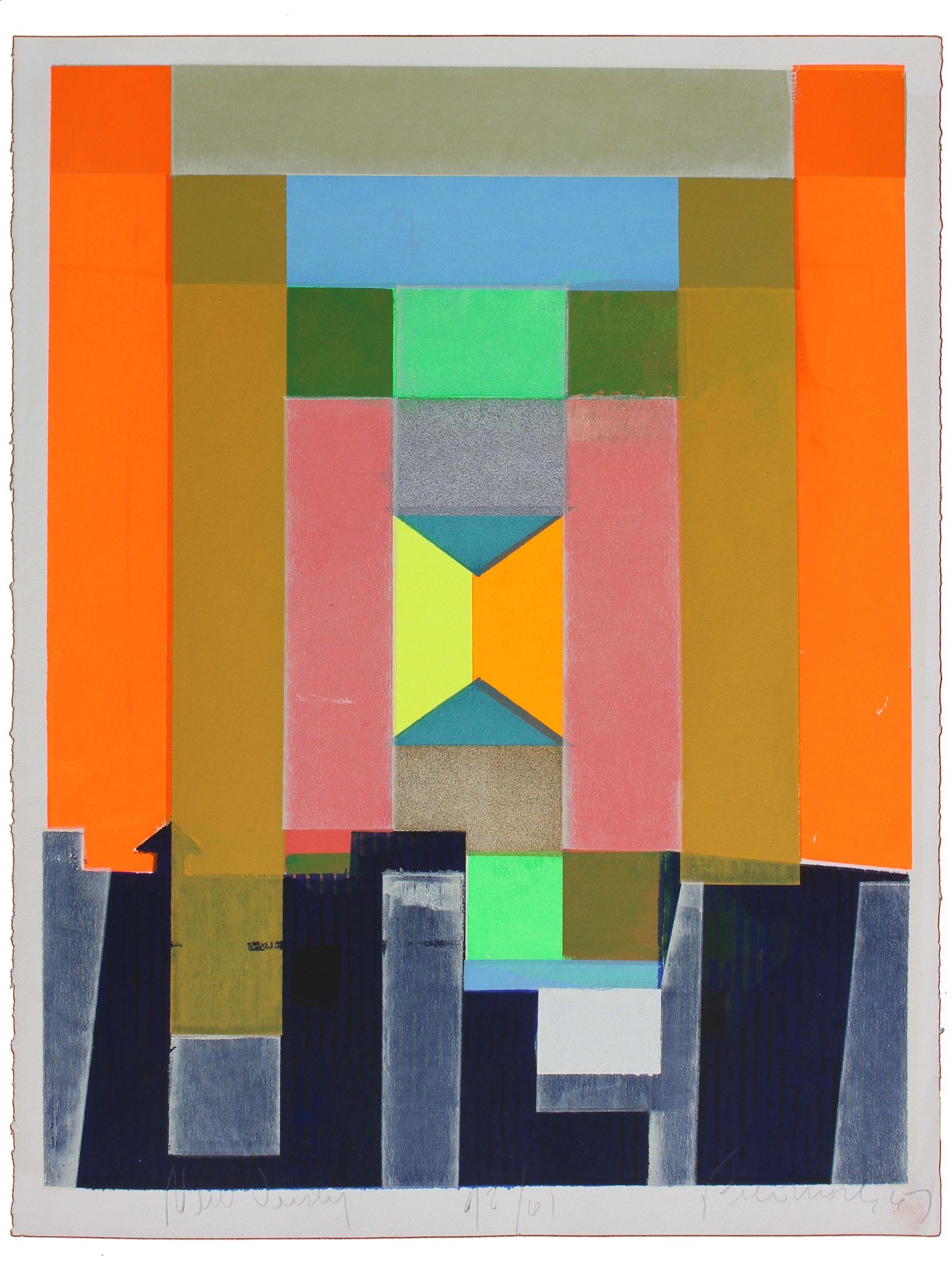
NEW JERSEY
17” x 22-1/2” – Edition of 61 – 1967
A complex sixteen color serigraph reflects New Jersey’s ongoing evolution into industrialization. It was here, in the nation's first planned industrial city, that the Industrial Revolution got a foothold, centered around the Great Falls of the Passaic River in Paterson, founded as a bold experiment, pioneering systems of business and mechanization. It was here that manufactories which enabled the young United States to become a global economic power were established and promoted. Freimark established this with experiments in silver, gold, and metal flake with the corrugated reminiscence of construction impinging on the colorful marshes of sprig that are no longer seen as dew-lapped or pristine. Relentlessly man overcomes nature with one hand and punishes it with the other.
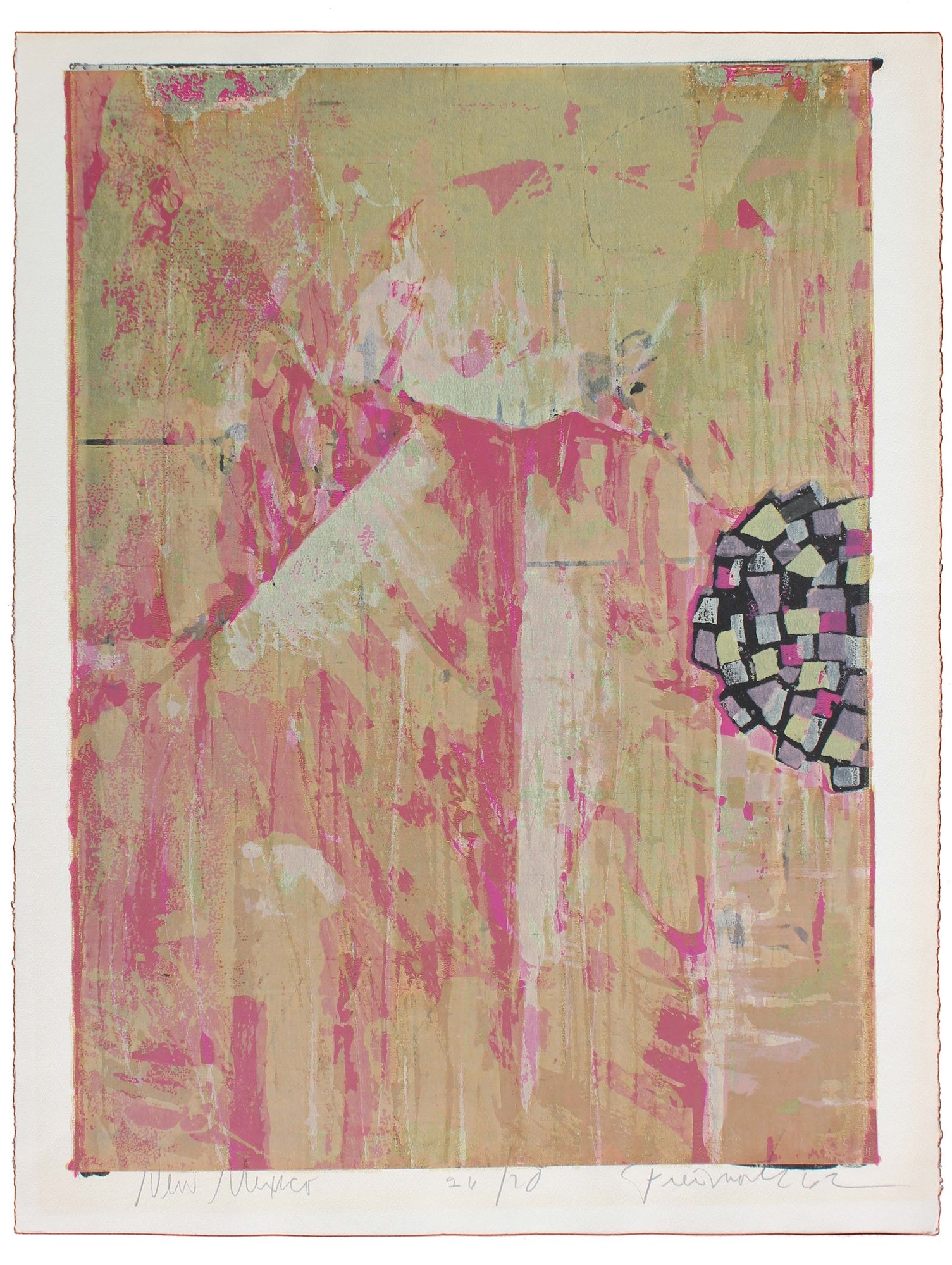
NEW MEXICO
15-1/2” x 22” – Edition of 70 – 1962
The blood of the Native braves and the conquistadores who colonized New Mexico in the 16th century has faded to pink yet still streaks the land where Freimark explored the carved-out caves of Bandolier and the ancient Pueblos. Abandoned now yet still alive with the ghosts of women grinding grain with pestles formed in rock, and prior to that the long-blown ashes of prehistoric fires. On the right, a ball of multicolored parts conjures a cob of maize, the indigenous corn known alongside beans and squash, as one of the “Three Sisters” in the area’s polyculture.
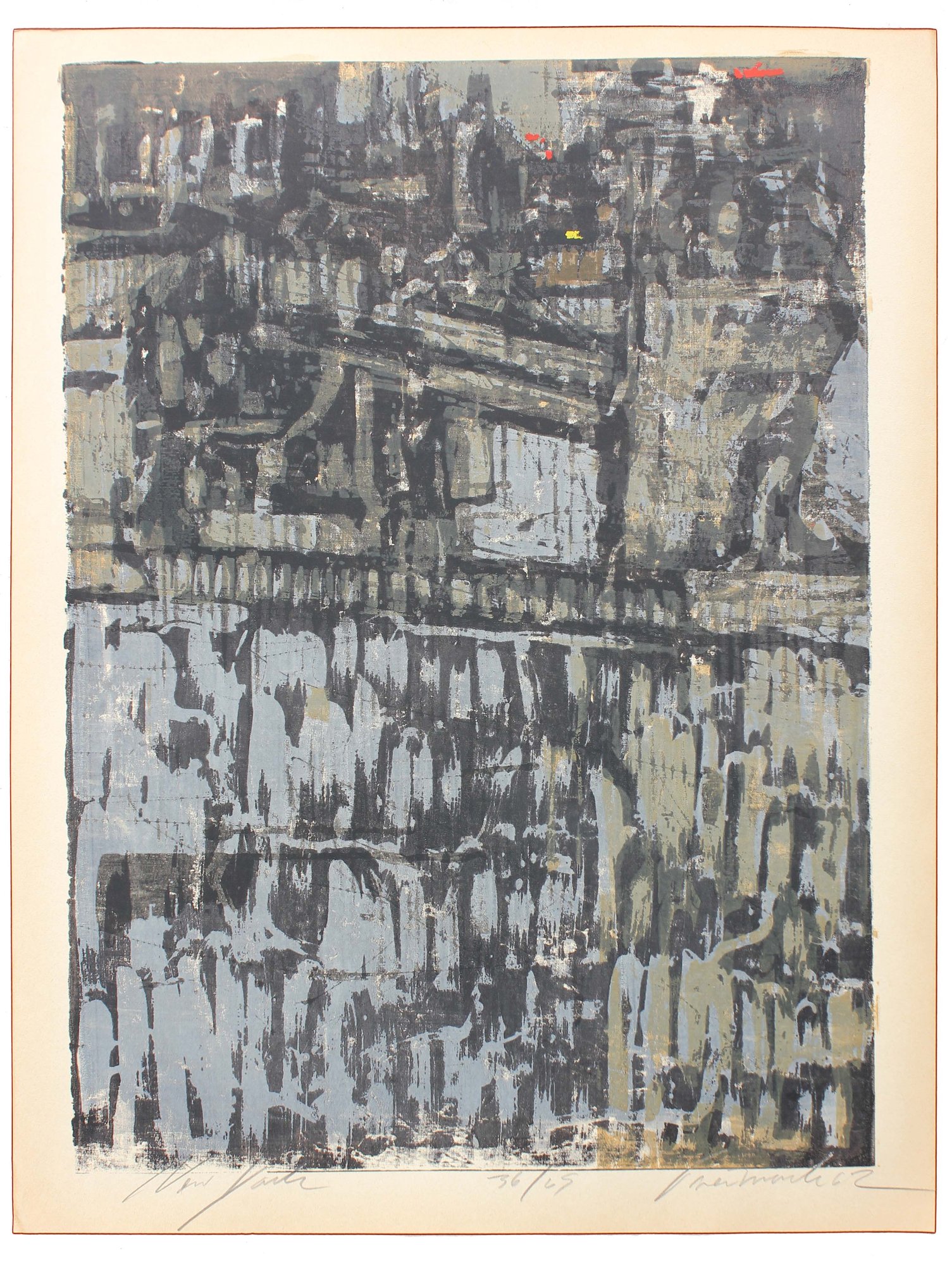
NEW YORK
22.25” x 16” – Edition of 69 – 1962
Freimark’s experience of New York was found underneath the compartmentalized existence of brownstone skyscrapers, pulsing with the ever-present throb of a compacted city’s heartbeat. A busy place built of concrete modality, slivers of light infiltrating the fast pace of city life. His square rendition of stacked boxes reflects the pulse of a place constructed of compacted lives, one atop another, a harmony of personality. A perpetual revolving door of people and place moving to the rhythm of life jammed together, a synchronicity of individual voices, and the sturdiness of solidity confounded by individuality. As he wrote, “the complexity grows” exponentially ad infinitum.
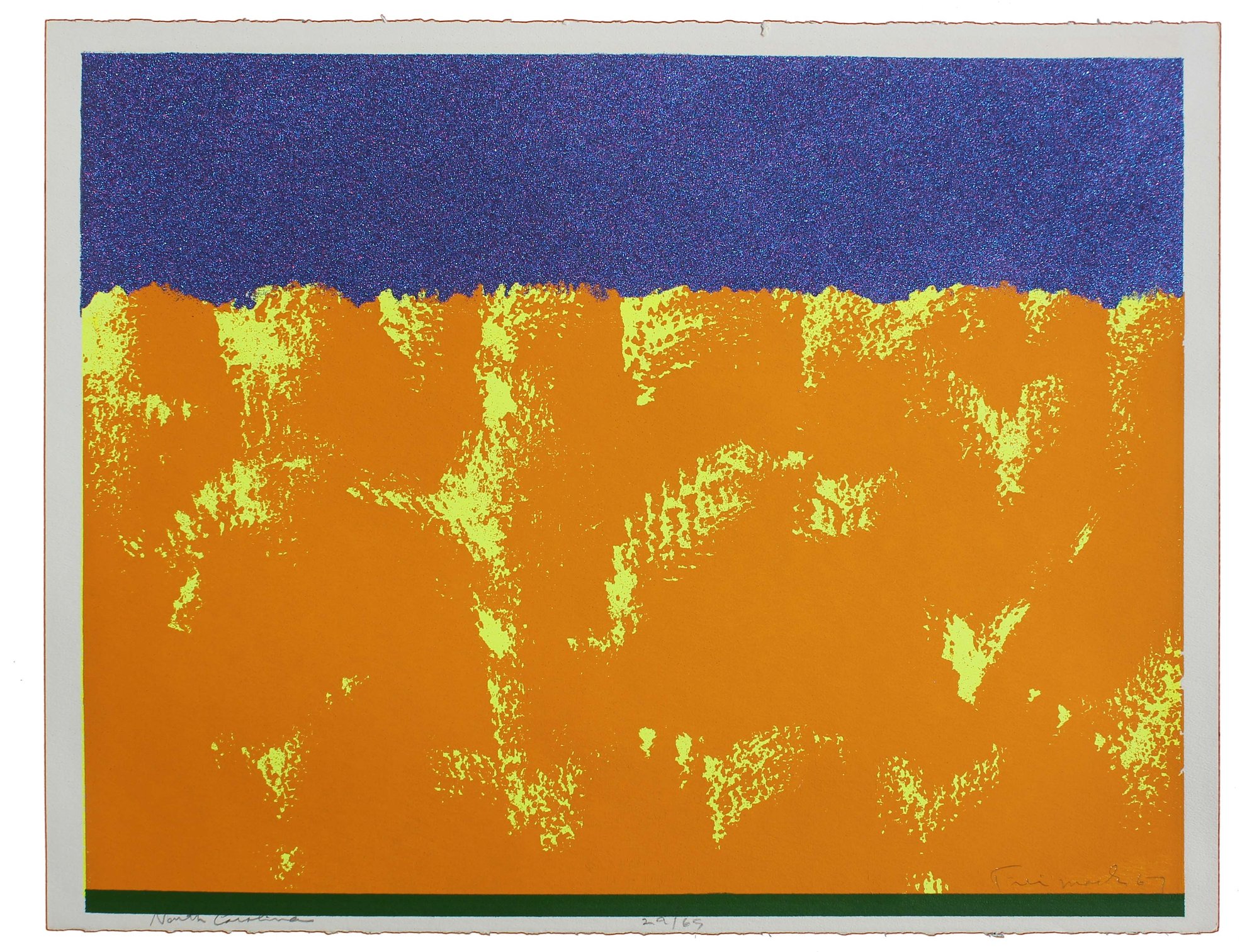
NORTH CAROLINA
17-1/4” x 22-5/8” – Edition of 65 – 1967
This four-color serigraph depicts North Carolina, somewhere west of Hatteras Island, where the sky swoops down to meet a mountain. A razorback ridge lacerated with pines saws the air. This is a place where Freimark imagined people in the hills who would “later pluck a pipe, and to the emanating sound and jigs that tie them, tune, and tumultuous dust into one, evoke the echo of an oak, the comfort of clear sipping whiskey, the red pine oozing its amber sap, and some of their Irish heritage.” A metal flake sky in blue and purple creates a sparkling, effervescent effect.
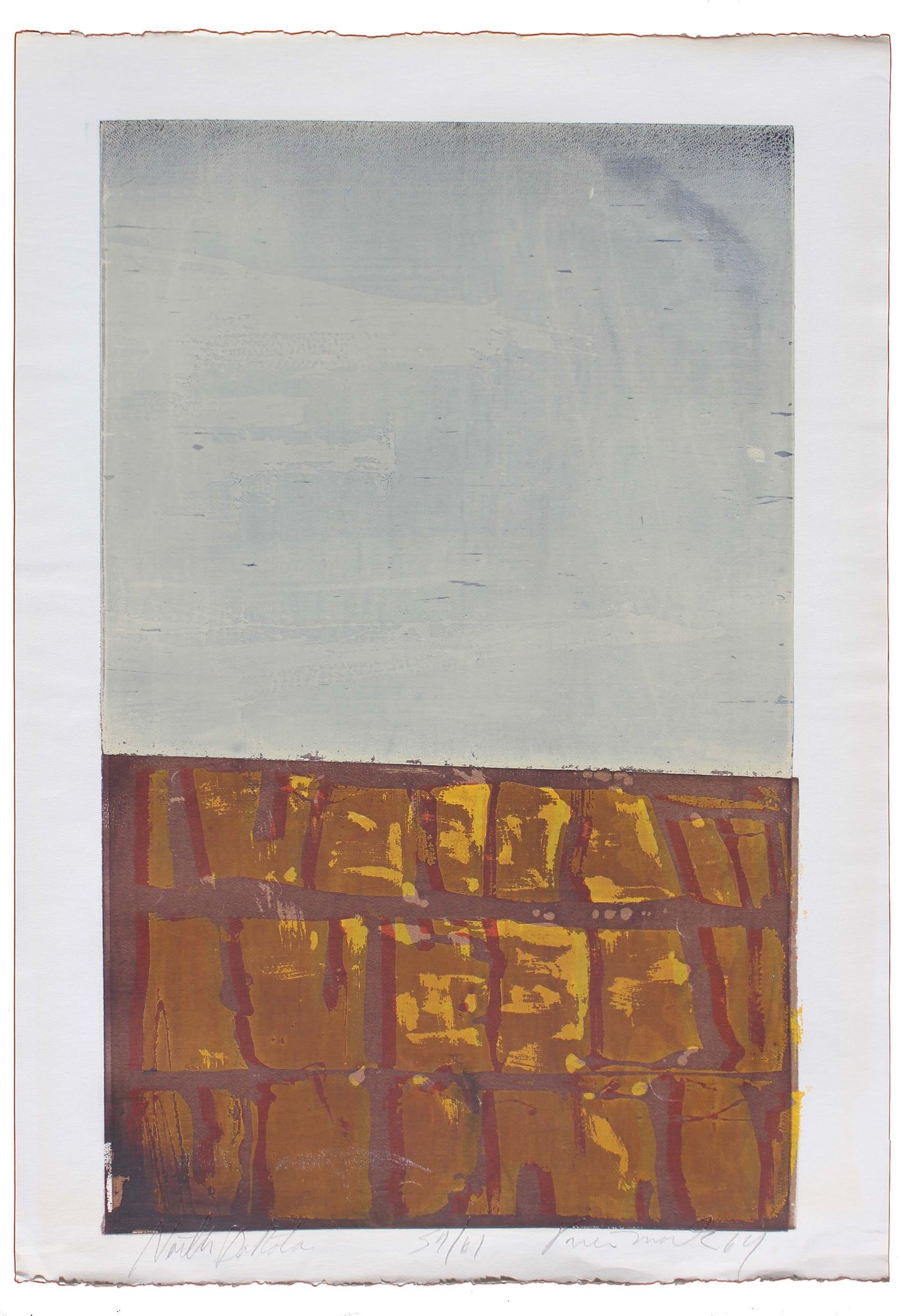
NORTH DAKOTA
14-1/4” x 23-1/2 – Edition of 61 – 1964
In North Dakota, a golden state of spring wheat and honey, Freimark rode through clefts of land cut with canyons and an occasional isolated peak. Just like President Teddy Rosevelt, he fell in love with the rugged lifestyle and freedom of the Badlands, marveling at the way a mesa would suddenly interrupt the horizon, thrusting its own flat heightened table in a gesture subordinating the lower landscapes. In this seven-color serigraph, the red, brown, and ochre mesa becomes the lower plane, ultimately dominated by a sweeping, cold grey sky.
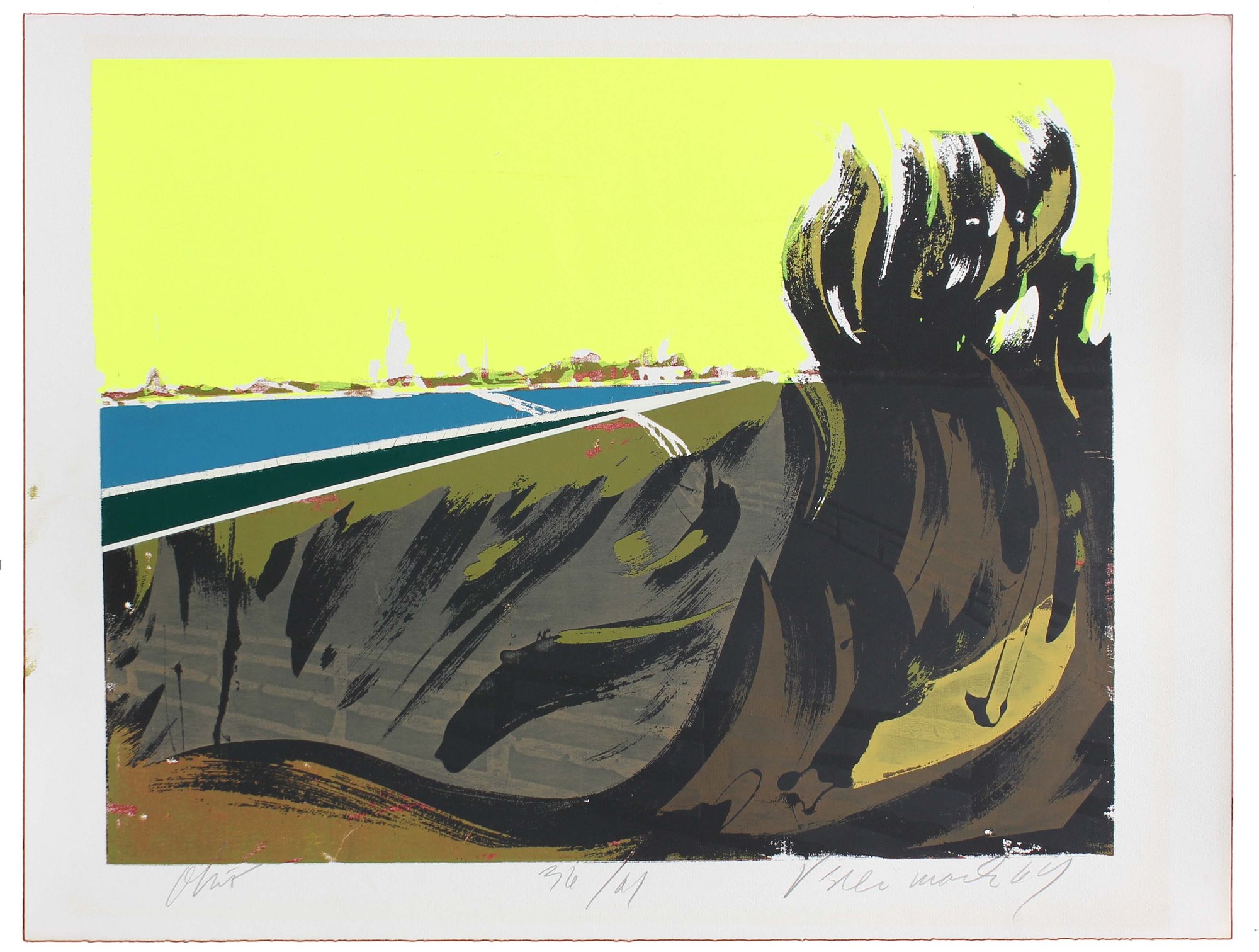
OHIO
16 x 20.75 – Edition of 61 - 1969
On the banks of Maumee Bay State Park with its billowing fields of rye and ripening corn, Freimark seemed to have found a sense of solace while watching the boats go by. Channeling a humble pheasant in the overabundant leaves, his tail protruding like bright silk, the artist concealed himself and enjoyed the butter yellow sun rays, the slow passing of time, in one of his more literal visual poems. The bush seems to overtake half the frame, the feeling of being disguised amongst the natural world, and inherent indigenous space, lending an intimacy to his love of place.
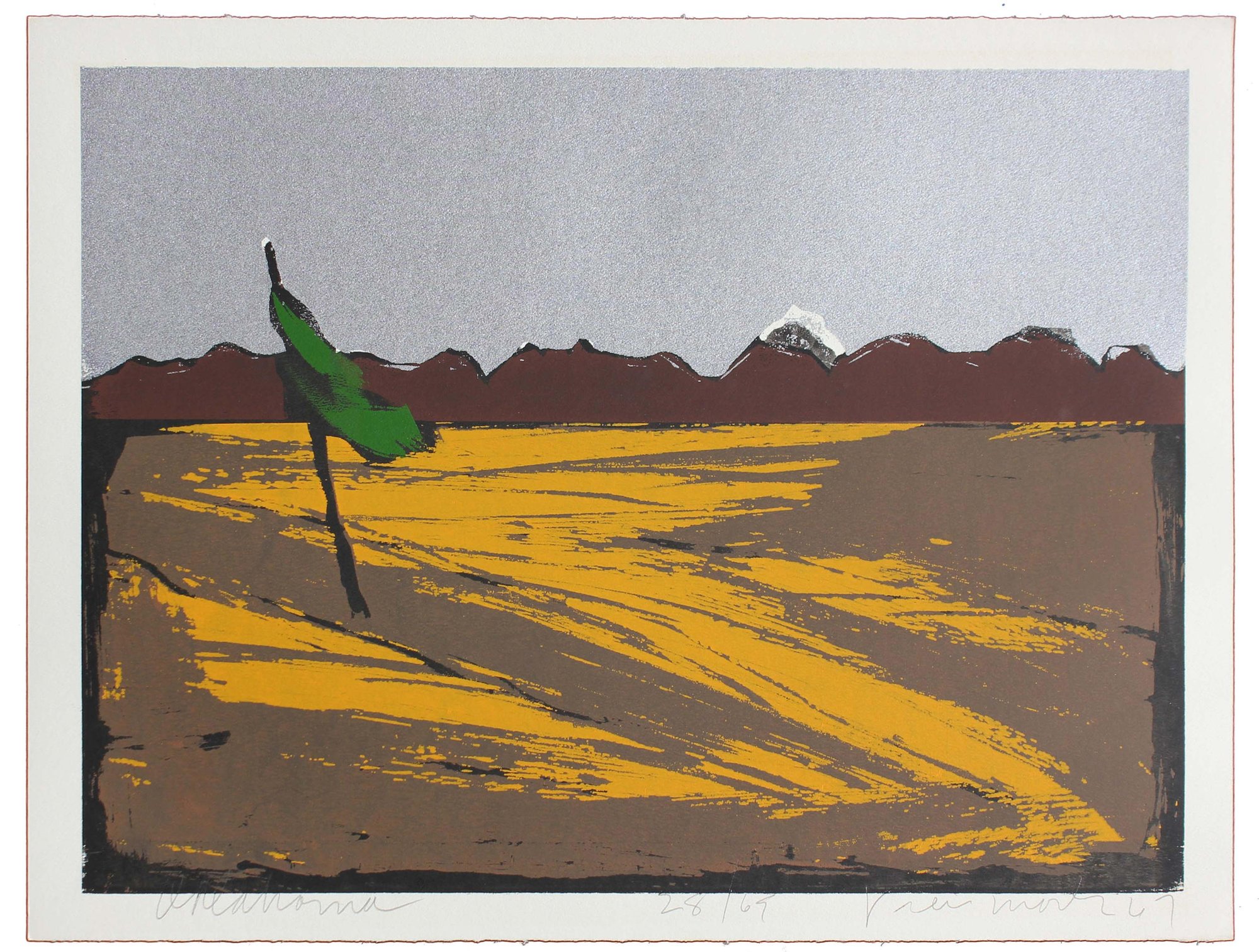
OKLAHOMA
16-3/8” x 22” – Edition of 43 – 1967
Freimark’s semi-abstracted impression of Oklahoma carries strong ghosts of the Dust Bowl. “A dry pump guards a still barn, while a fluttering rag beats without sound to the rustle of pack rats in the empty trough. Twisted, a half-cocked windmill has gone out of control in the dirt. The thin sounds of the strident Woody Guthrie, sympathizing with folk who stuck it out, on his piquant guitar.” Metal flake and cinnamon hued enamel ink are laid down above the scene to accentuate the severity of this period in history when several dust storms and drought in the 1930s devastated the American prairies.
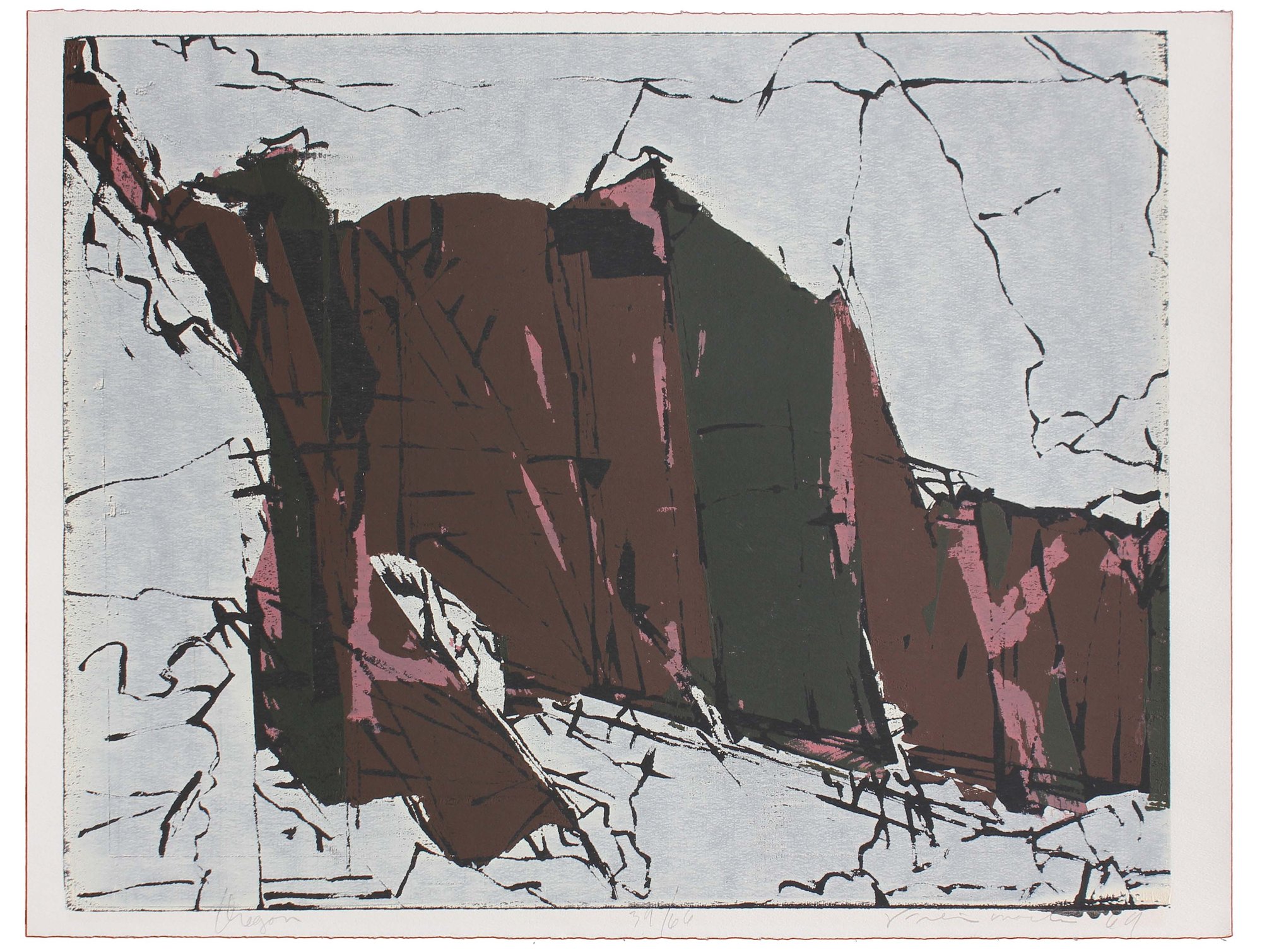
OREGON
17-1/4” x 22-1/4” – Edition of 66 – 1964
Hammering, gouging, crashing, dissolving, a relentless gray eroding sea smashes the cliffs protecting the left coast of Oregon –the rocky sides exposing mighty grooved facades in deep brown and dusty pink. A place where secrets were held in the narrow confines of ancient lighthouses dotting the border. Freimark’s feelings in the face of this rugged terrain were those of satisfaction; of sensing the inhabitants of the state were aware that the sea would never completely diminish them or their bountiful moments of beauty, even amidst the constant and crashing dialogue between water and earth
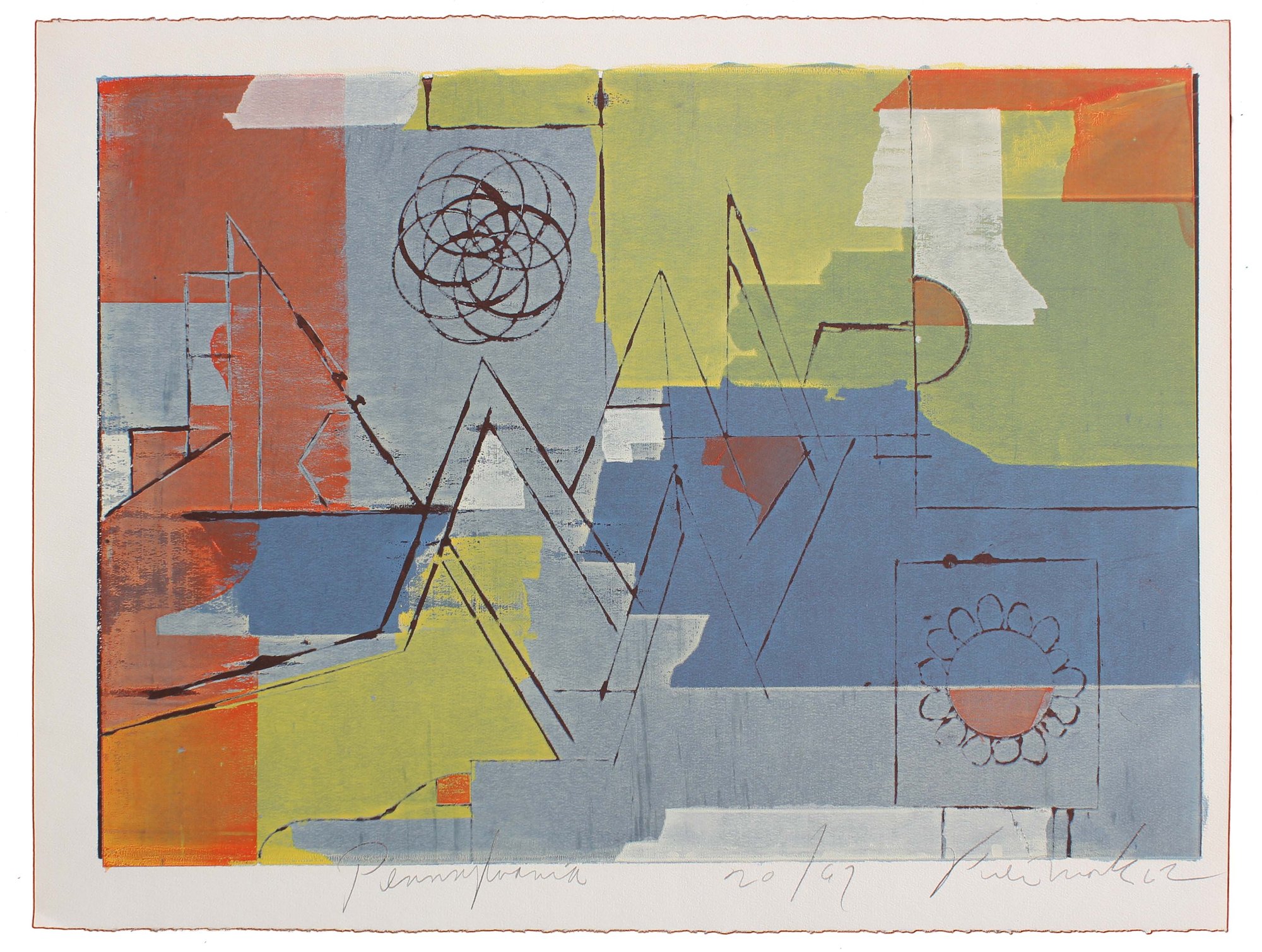
PENNSYLVANIA
15.75” X 22.5” – Edition of 67 – 1962
The humble building blocks of American freedom, sketched as an architect’s blueprint in black geometric lines, rudimentary shapes, and overladen with the colors of terra cotta earth, verdant greens, and chalky blues, Pennsylvania represents the building blocks of a populous country, experimenting with freedom and democracy. In Mondrian-esque forms and colorful swaths, accentuated on top by the spherical figures of concentric circles and a floral motif, it’s almost as if Freimark is having a party with a paint-by-number kit informed by the ingredients of a specific time and place known for the Pocono Mountains, the Liberty Bell, and the establishment of meaning for both the Constitution and the Declaration of Independence.
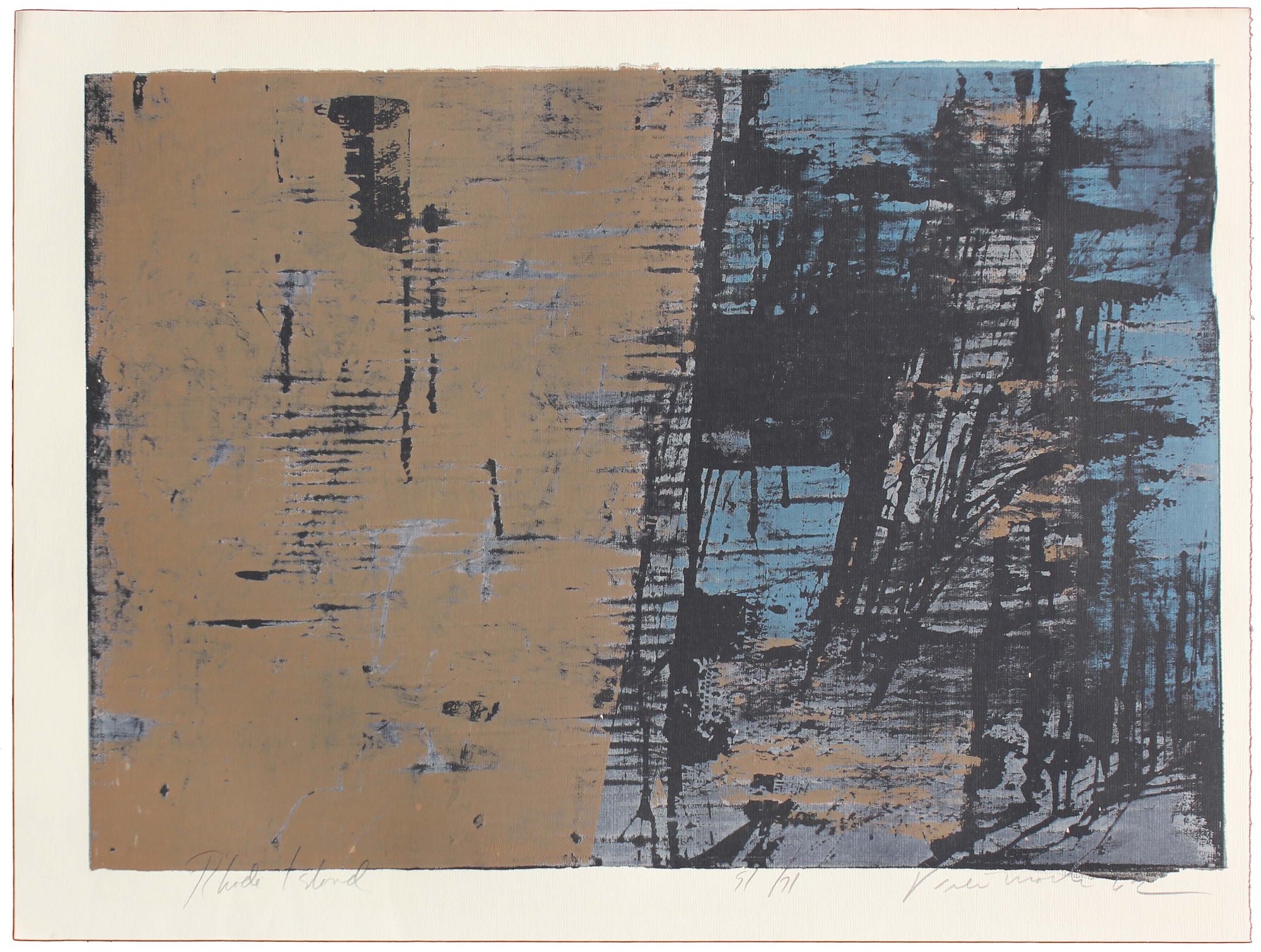
RHODE ISLAND
15-5/8” x 22-1/8” – Edition of 71 – 1962
On the wharves of Providence, Freimark marveled at the way the coastline of Rhode Island felt like a place where people and the sea met to clasp hands. Lapping waves ashore recreating a child’s laughter, heaping plates of shrimp with steam beer arriving at pier side eateries, and a world of stones peeking through earth to form walls built by men on land or found organically formed in the quays. This rendezvous between sand and water becomes evident in this four-color serigraph in brown, blue, black, and grey, a simplistic ode to the Ocean State of which colonial towns and Gilded Age mansions were famed.
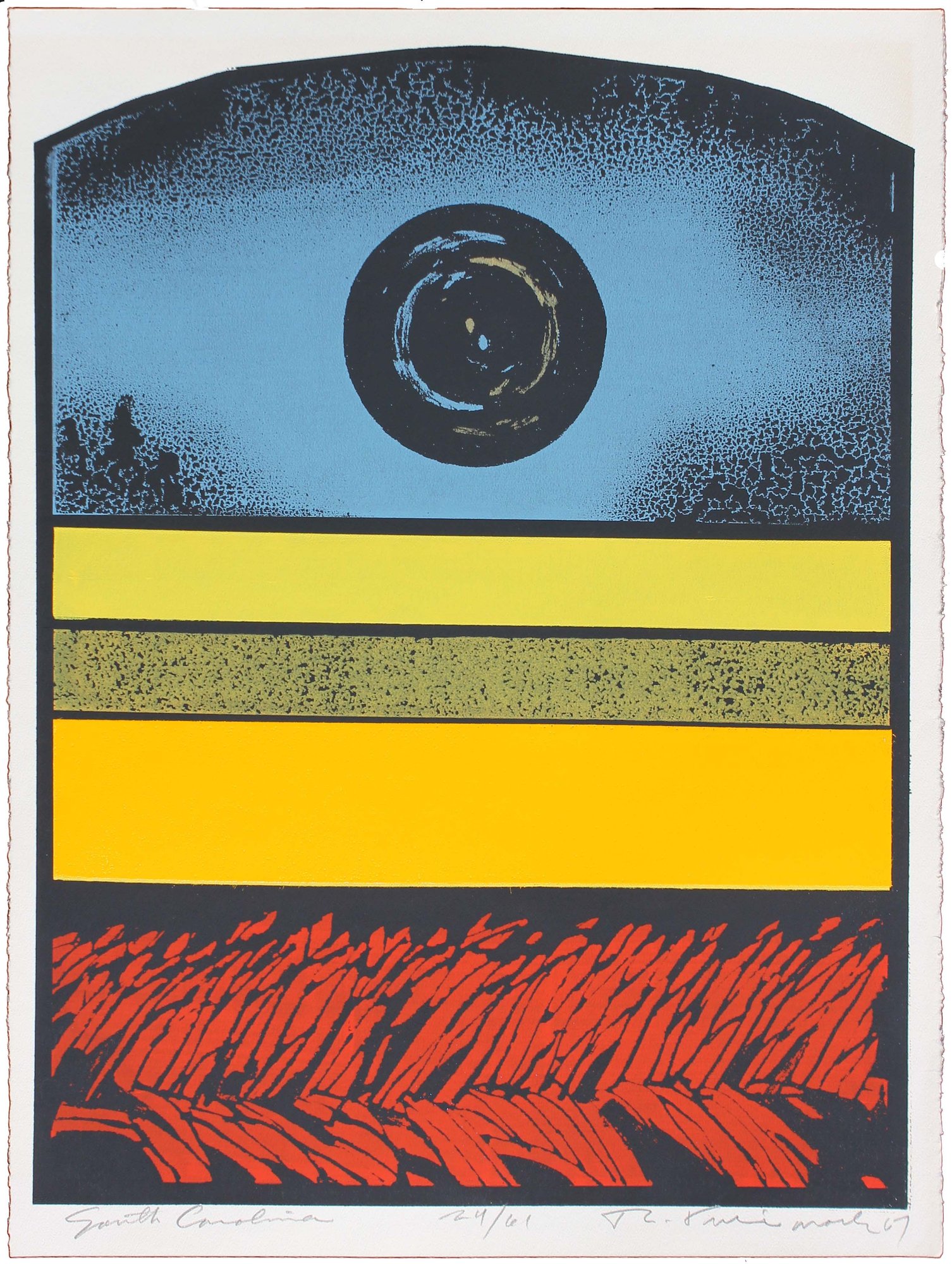
SOUTH CAROLINA
16-3/4” x 22-3/8” – Edition of 61 – 1967
In the South Carolina marshes in October, Freimark experienced a moment where a kindred mass of ducks sat turning in the sun, their silver banded wings catching the light and swathing the damp sea of weeds with a flash of dazzling sparks. This snippet of time is expressed on a tombstone shaped background covered with a flag of ochre, lemon, and gold atop a vermillion thatch of swampy grasses. A black circle floats in the pale blue sky as if the daylight has been stripped of its strength given over to the frolicking animals below.
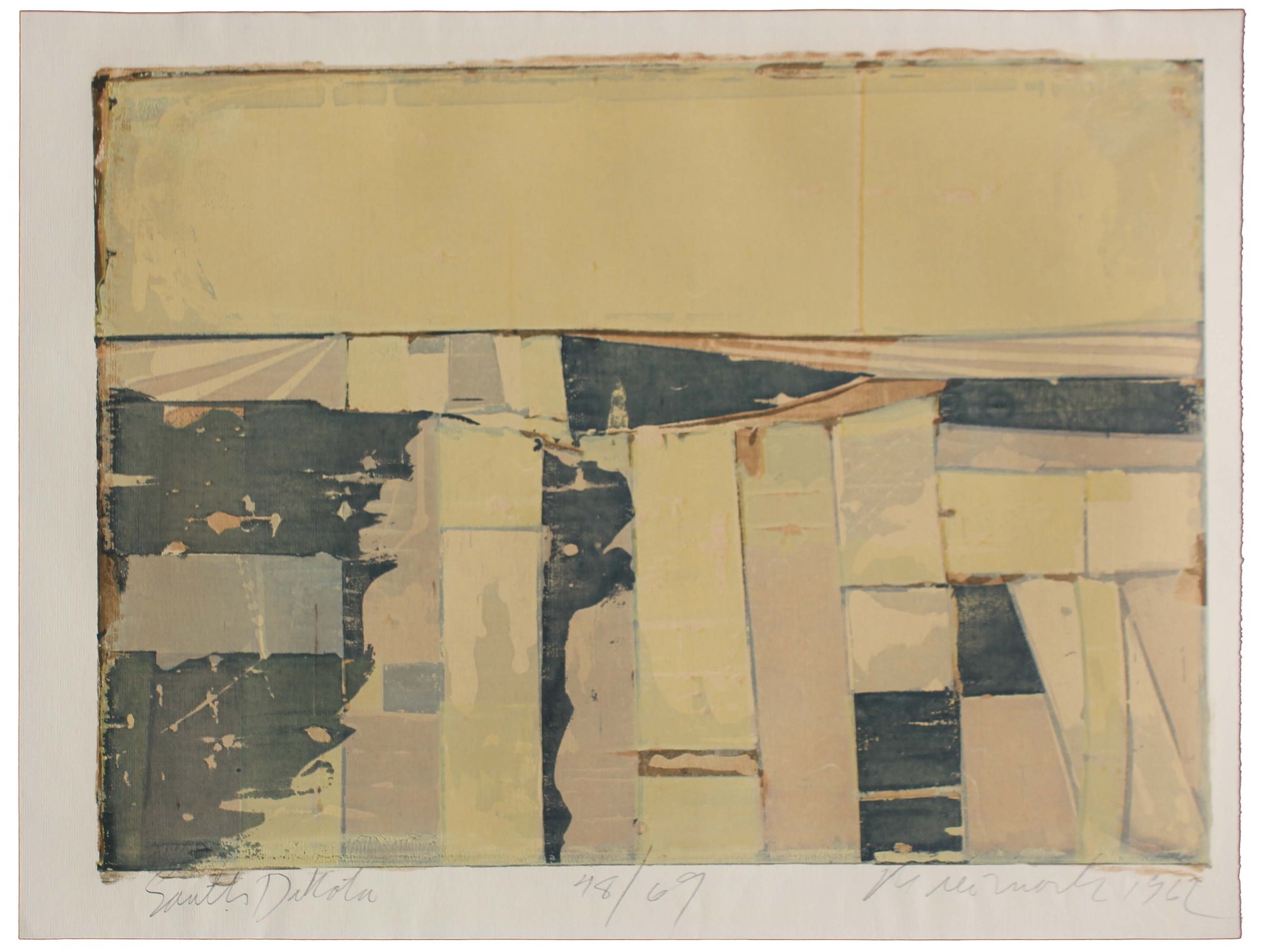
SOUTH DAKOTA
15-3/4” x 22” – Edition of 69 – 1962
On the sprawling prairies of South Dakota, Freimark found a pleasing geometry in its myriad strips of fertile farms, creatively plotted and placed throughout the state by pioneering men. He likened then sense of arrangement and order in the “land of infinite variety” to the architecture of buildings in cities or the patterns composed in the mind by great artists or craftsman. This piece reflects this in warm tones of the land, constructed in squares and rectangles that integrate with the foliage representing a symbiosis between wild nature and enterprising man underneath a block of straw-colored sky.
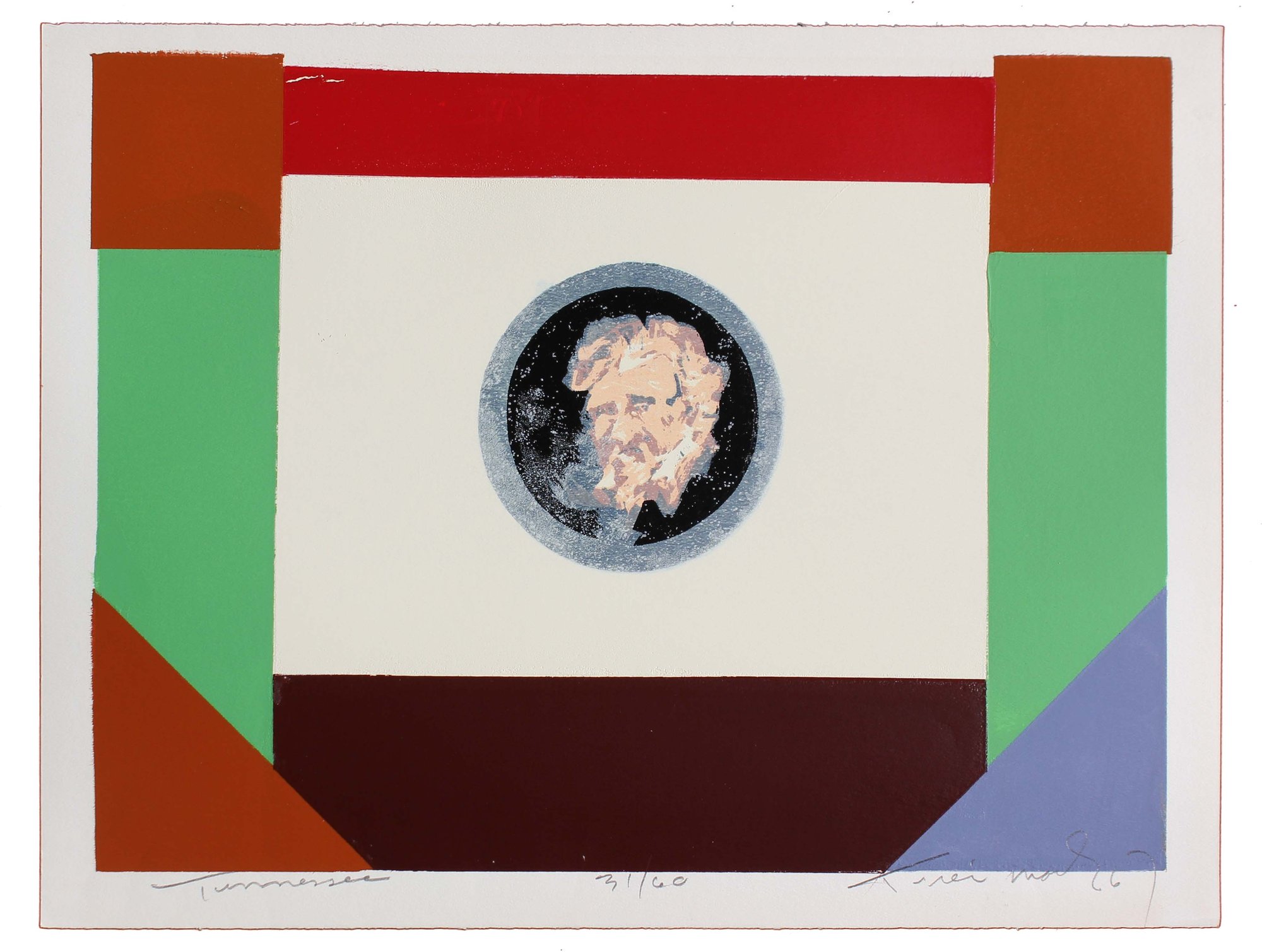
TENNESSEE
16-3/8” x 22” – Edition of 60 –1967
In the hills of Tennessee, Freimark felt the spirits of many unsung heroes ghosted in its contemporary people. In his own words, “a vestige of spirit smoking on the walls of old homes in antique frames, seeping from old portraits, a vast montage of lost American youth with grassy knees, who could handle a pickaxe, a lute, or a piece of steel.” This is depicted through a complex 12 color serigraph in bocks of liver, lavender, mauve, red, black, and green surround a white field, on which appears a heroic head in conventional flesh tones.
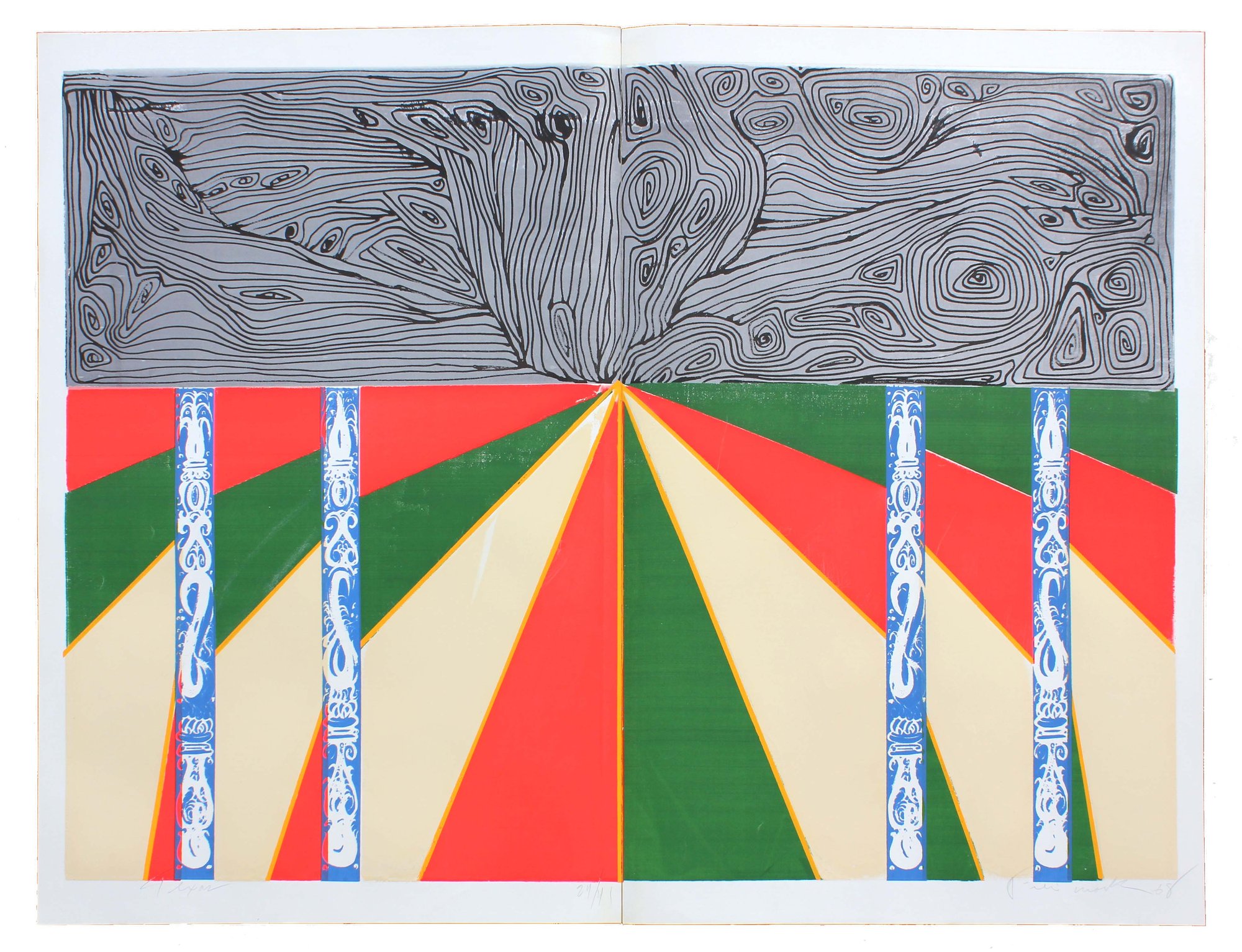
TEXAS
36.5” X 49.5” – Edition of 41 – 1968
An upper atmosphere of surreal squiggles floats in a grey sky, reminiscent of wavy oil slicks making their presence known in the atmosphere—the dominating industry of the larger- than-life state of Texas, an ever-present character on the economic horizon and source of the area’s greatest fortunes. Below lay stratified belts of agricultural rows touting red strips of prime-fed beef, cotton, sorghum, grains, rice and wheat on grasslands where everything looms larger than life in a great state proud of it excesses. Strips of ornamental columns, occupy the bottom right-hand corner offering a pale blue and white structure for, or nod to, the good ole boy architecture of America with roots stuck deep in the nostalgic heartlands of our communal psyche.
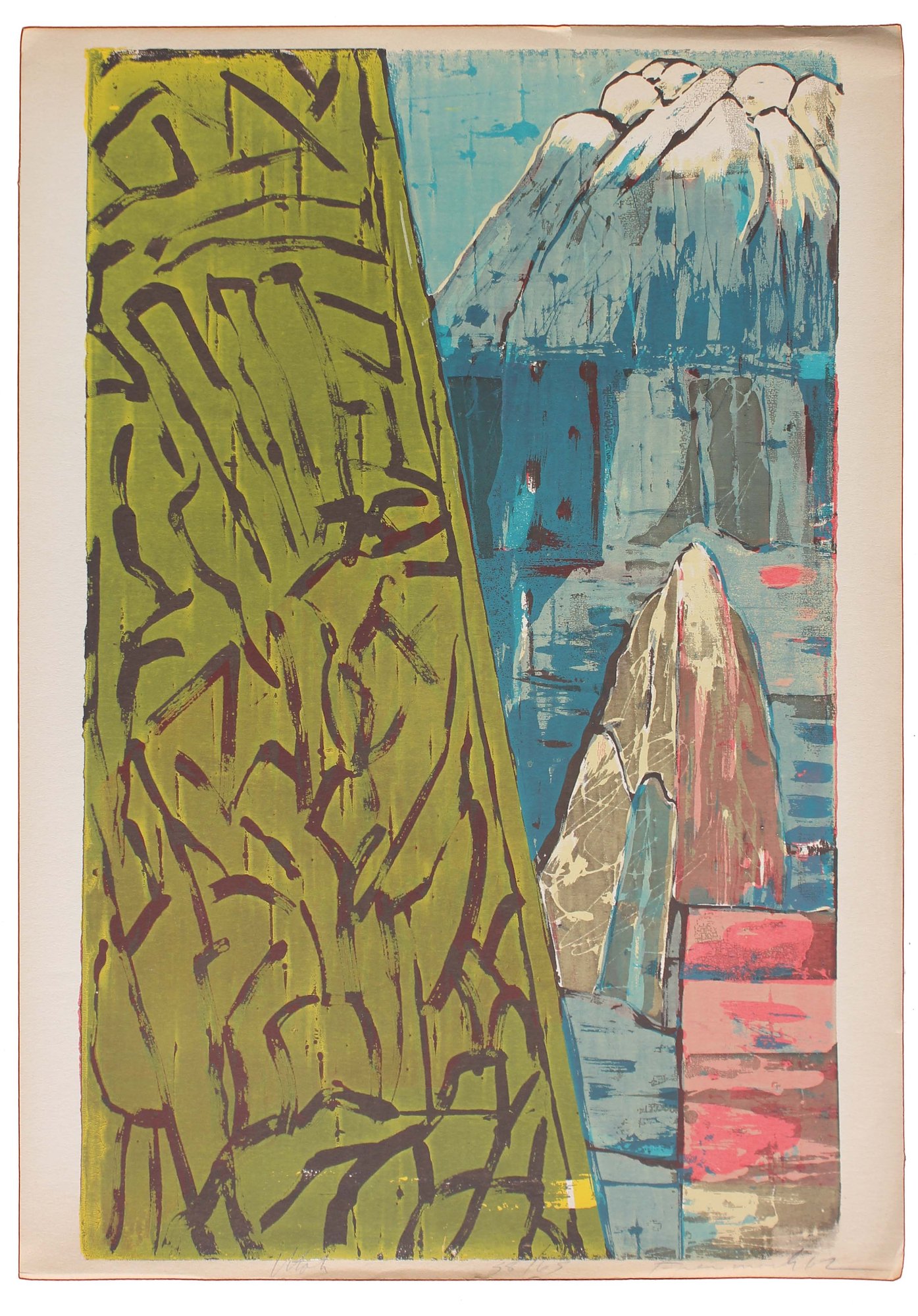
UTAH
15-1-2” x 25-1/4” 11 – Edition of 65 – 1962
Up and down Utah from Bryce Canyon to the Salt Flats, Freimark felt a pervasive spirit of the Native tribes who dwelt in the area for ages before the white man came to settle on their namesake land. This homage to that spirit arrives through a haunting thalo blue sweat lodge, an off-white teepee, a rose-colored blanket, and a light green triangular totem carved with dark brown forms, recognizing the traces of history’s footprints as the artist reimagines the state’s past. The items float together in a translucent wash, uniting them as if fragments of a dream or a long-lost memory.
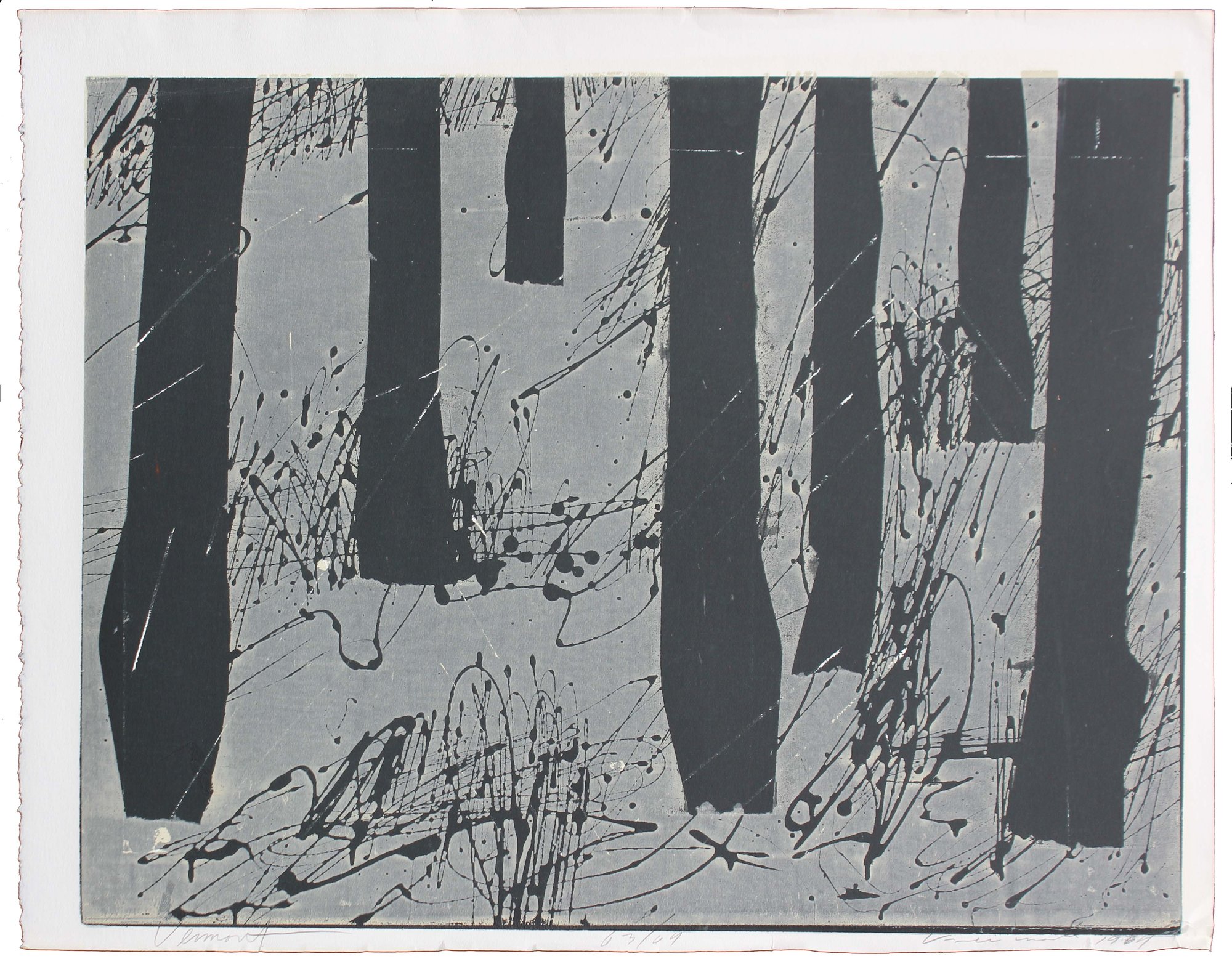
VERMONT
17-1/4” x 22-1/2” – Edition of 64 – 1964
A two-color serigraph in chilly gray and ebony depicts the famous trees of Vermont, which deliver the state’s celebrated syrup sap in March, in their dormant period when the wind eddies little gussets of snow, their silver flakes floating in stark contrast to the stolid maples. Frigid gusts weave through the trees in Pollock-like splatters and drips as the forest stands stoic amongst the climate’s barrages. A sense of peace permeates as nature runs its natural course in this darkened glade, no hints of the nearby towns and homes filled with people enjoying the fruits of last year’s tap on their morning pancakes.
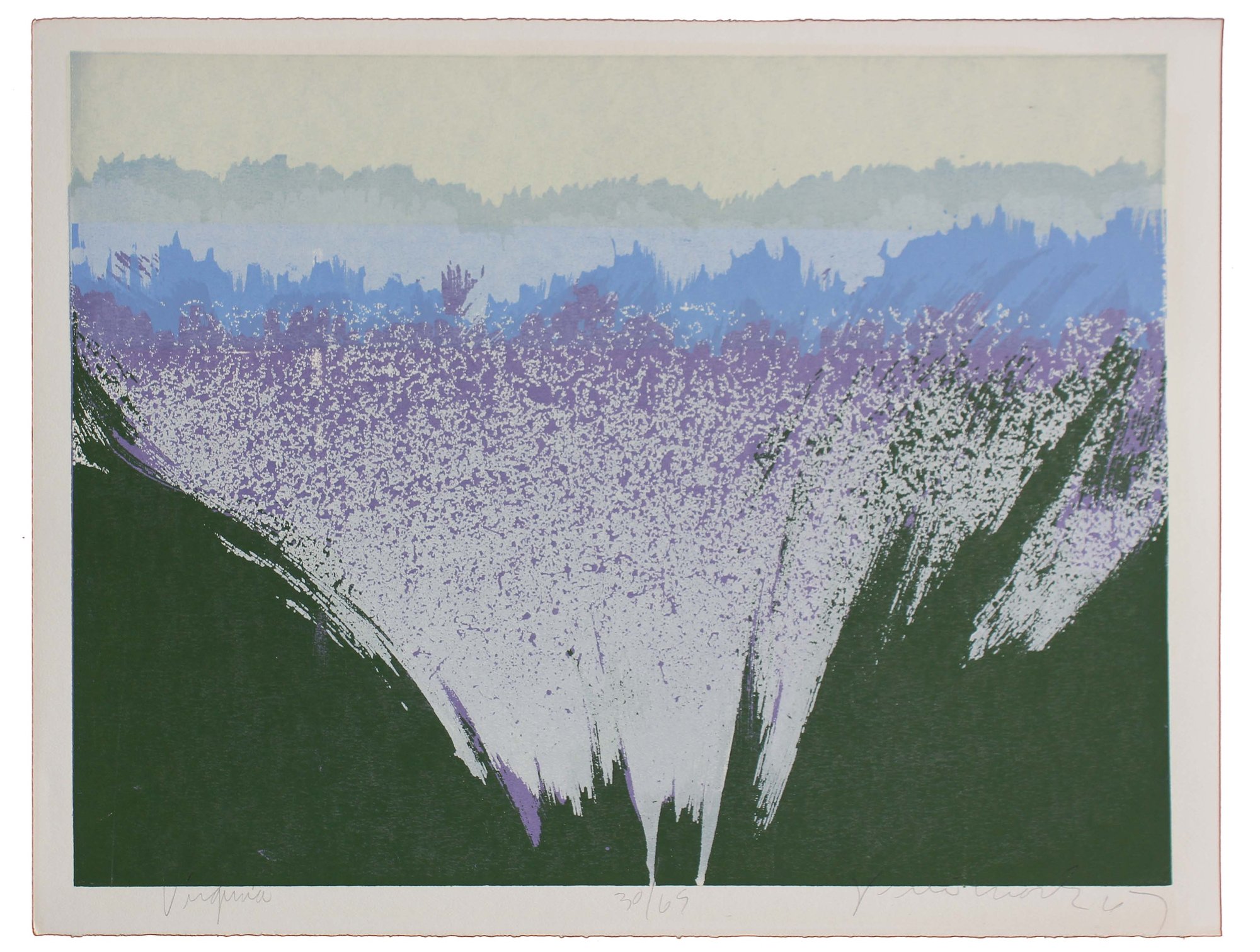
VIRGINIA
16-3/4” x 22-3/8” – Edition of 65 – 1967
Misted peaks emerge through vibrant layers of bursting, then receding, transparent blues and orchids behind an overlapping wash of purple. The scene depicts the signature haze from a natural atmospheric effect that is signature to the Blue Ridge Mountains and Shenandoah Valley of Virginia. It’s the verdant green forests below that blanket the slopes, rich with oaks, pines, and other broad-leafed trees which release particles into the air, that once scattered through with sun, create the soft, smoky cerulean veil that gave the range its name centuries ago. On clear days the ridges appear cobalt or slate; on humid summer afternoons they melt into a dreamy, misted indigo.
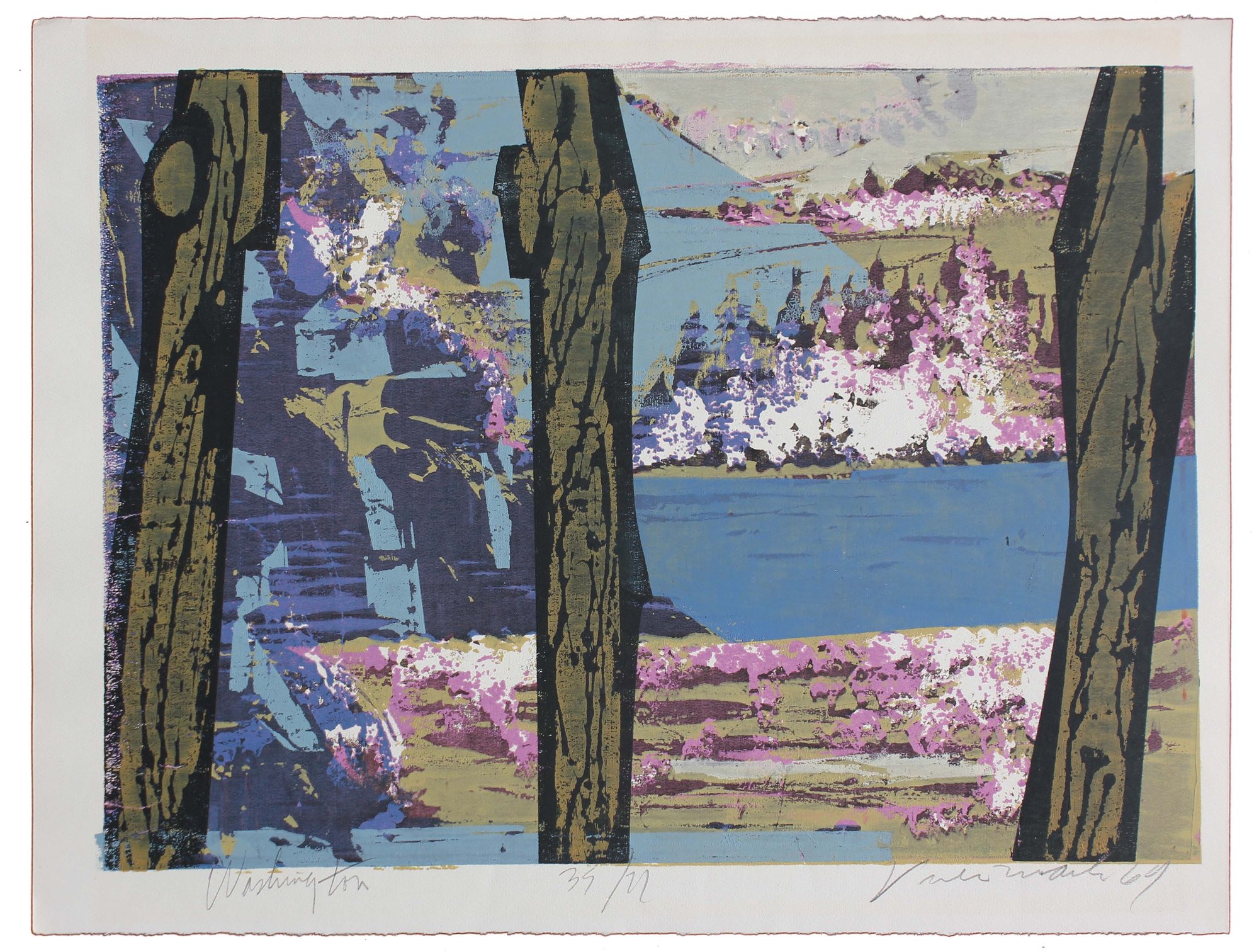
WASHINGTON
15-3/4” x 22” x Edition of 71 – 1964
Freimark’s self-described visual ode to American painter and poet Marsden Hartley informs a scene composed of natural elements indigenous to Washington. Three great firs beckon the eye into an idyllic painting of blue coastal waters and whimsical lavender, pink, and white orchid clusters known to proliferate on the Olympic Peninsula. The trees are rendered in a Cubist abstraction as the background resembles the refreshing authenticity of plein air – a place fruitful for visits by moose, grizzly, whale, or bear. A rare piece in the series for its more literal air and nod to the artist’s peer influences.
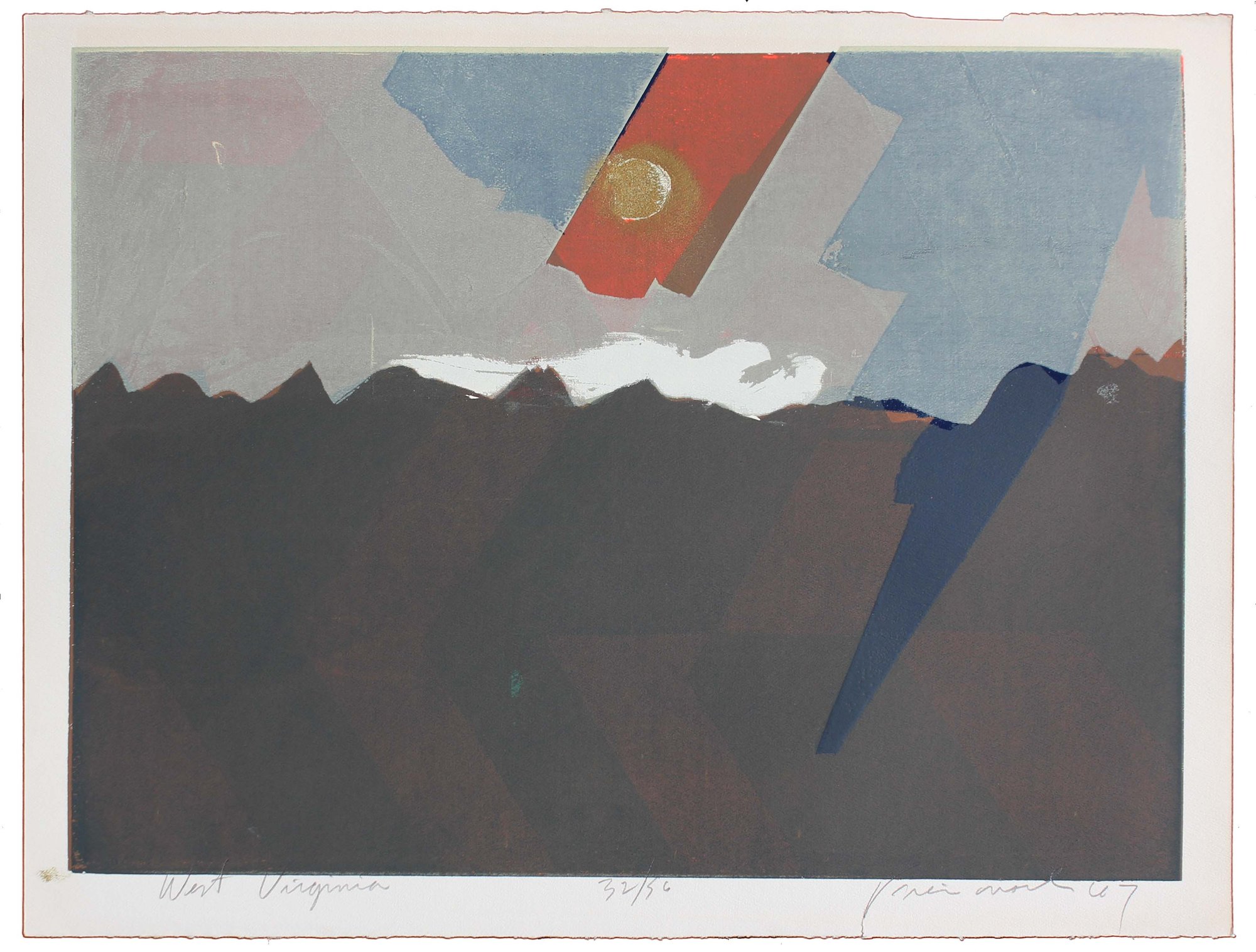
WEST VIRGINIA
16-3/8” x 22-1/4” – Edition of 56 – 1967
West Virginia was (and remains) a land of folded Appalachian ridges, deep river gorges, and forested plateaus. The Allegheny Mountains carved sharp contrasts of light and shadow, while valleys like the Kanawha, Monongahela, and New River Gorge carried white-water rapids and misty morning fog. In the late 60s, its hills were cloaked in oak, maple, and hemlock, and spring brought redbud and rhododendron blooms that streaked the slopes with pink, purple, rose, and bronze. Country roads wound past limestone caverns, trout streams, and high meadows that gave the state its nickname “the Mountain State.” Freimark once remarked, “They say you could walk a hundred miles down the Blue Ridge and never see a house. I believe that.”
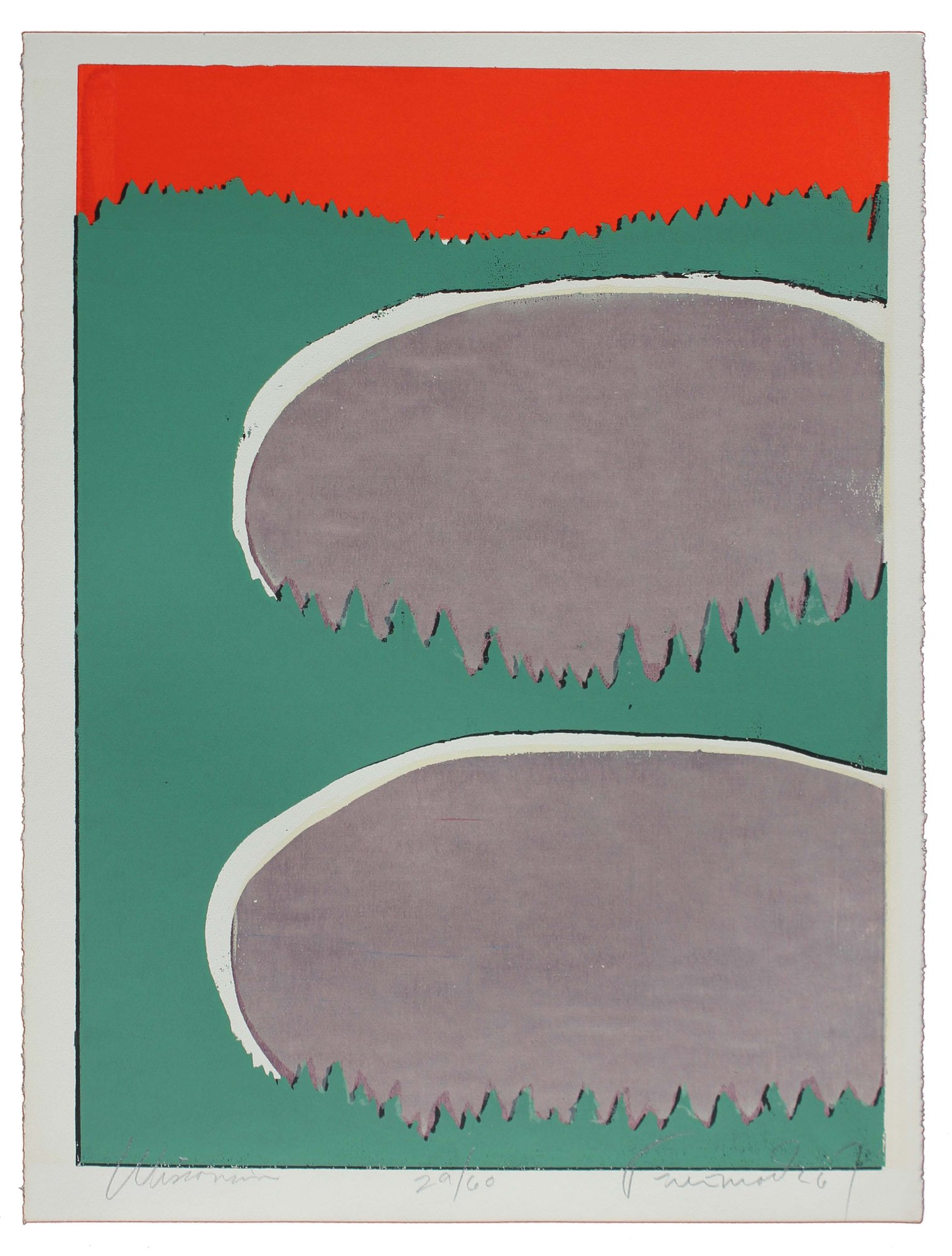
WISCONSIN
16-1/8” x 22-1/4” – Edition of 60 – 1967
Freimark’s Wisconsin was an innocent land of childhood lore, where “everybody knows the lakes were made by Paul Bunyan looking for his blue ox,” and he renders that tall tale with playful reverence. In this five-color serigraph, the state stretches wide beneath a stunning roseate northern sky, its lilac glacial lakes gleaming like storybook jewels. Pea-green fields and black forested woods echo dairy pastures, deep pines, and the mysterious beauty of the Northwoods. The glowing neon horizon suggests both the crisp clarity of winter air and the quiet wonder of a land shaped by ice and myth.
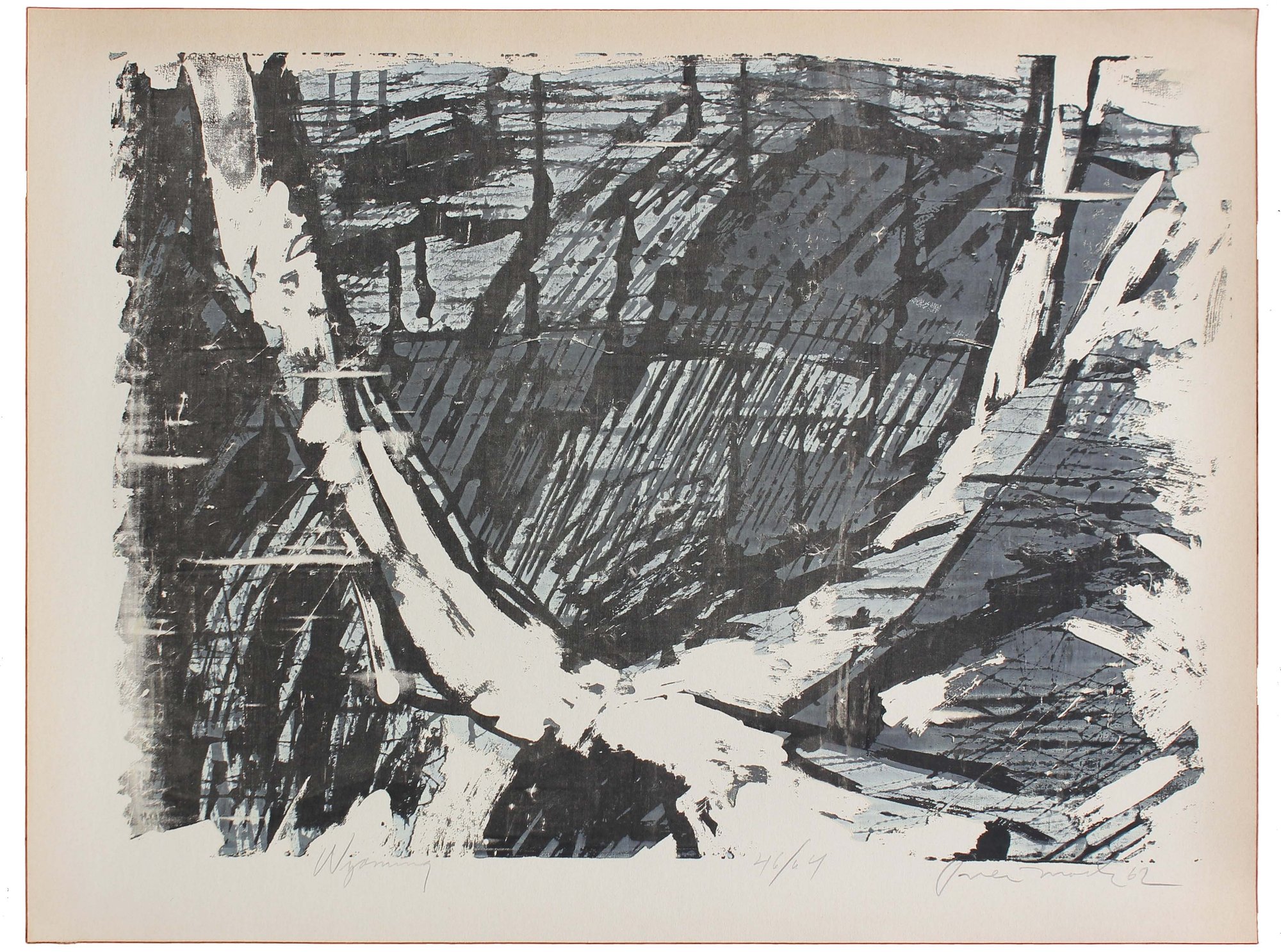
WYOMING
15-1/2” x 21-1/2” –Edition of 64 – 1962
A three-color serigraph, stark as a sketch, in monotone gradients from black through white, Wyoming reflects Freimark’s observance of it being dry as a bone, known for receiving less than ten inches of rain a year. Yet he also marveled at the flush flora and fauna: hair thin thickets of sage, cactus thrusting through brush, the ancient mesquite and the chameleon-like presence of mule deer and Rocky Mountain elk. This work compiles an arid glimpse of the state’s deserts, steppes, and alpine regions, echoing its spare climate on a neutral beige base.
more about this artist
Biography
Born in 1922, he graduated from the University of Toledo, and went on for an MFA from Cranbrook Academy of Art. Later he was a student of Max Weber, and was elected to New Talent in the USA in 1957. In the period 1960-68 he created a series of serigraphs entitled “Fifty States” which depict the U.S. states, and were completed under the aegis of a California State Colleges Special Creative Leave. They became the official U.S. bicentennial offering in 1976, opening at the Amerika Haus in Munich. They have been shown throughout the world, and the National Museum in Washington has acquired the complete set together with all accompanying sketches, plates, etc.
Freimark has over 250 solo exhibitions to his credit in such institutions as the Toledo Museum of Art, Minneapolis Institute of Arts, Morris and Sal peter Galleries in NYC, Santa Barbara Museum, Galerie Alliance in Copenhagen, etc. In 1990 he had shows in Stara Radnice in Brno and Strahov Kloster in Praha, Czechoslovakia. His works are in collections such as the Boston Museum of Fine Arts, Fogg Museum, Pennsylvania Academy of Fine Arts, British Museum, Bibliotheque Nationale in Paris, Honolulu Academy of Arts, Library of Congress, National Gallery in Prague, etc. He has lectured around the world, and was Visiting Professor at Harvard University in 1972-73.
In more recent years he was shown in “Künstler aus den USA” at Galerie Waiter Bischoff in Stuttgart, a major tapestry retrospective at Triton Museum of Art in Santa Clara, CA, and exhibitions in Antigua and Guatemala City, as well as Kunstostbayern in Viechtach, Germany, Amerika Haus in Stuttgart (1992), and Galerie Saint Cenerei-Ie-Gerei in France (1992). He has been invited to participate in the Quincentennial Exhibition of the Discovery of America at the Triton Museum of Art in 1992 In February 2010 Bob Freimark passed away in San Jose, CA.